TAE40116 Certificate IV in Training & Assessment - Knowledge Questions 1A - Design
VerifiedAdded on 2022/10/02
|54
|11535
|160
AI Summary
This document contains the instructions and tasks for completing Knowledge Questions 1A - Design for TAE40116 Certificate IV in Training & Assessment. The questions cover topics such as VET, its history, objectives, stakeholders, and more. The document also includes information on how to submit your task and receive feedback within 4 business days.
Contribute Materials
Your contribution can guide someone’s learning journey. Share your
documents today.
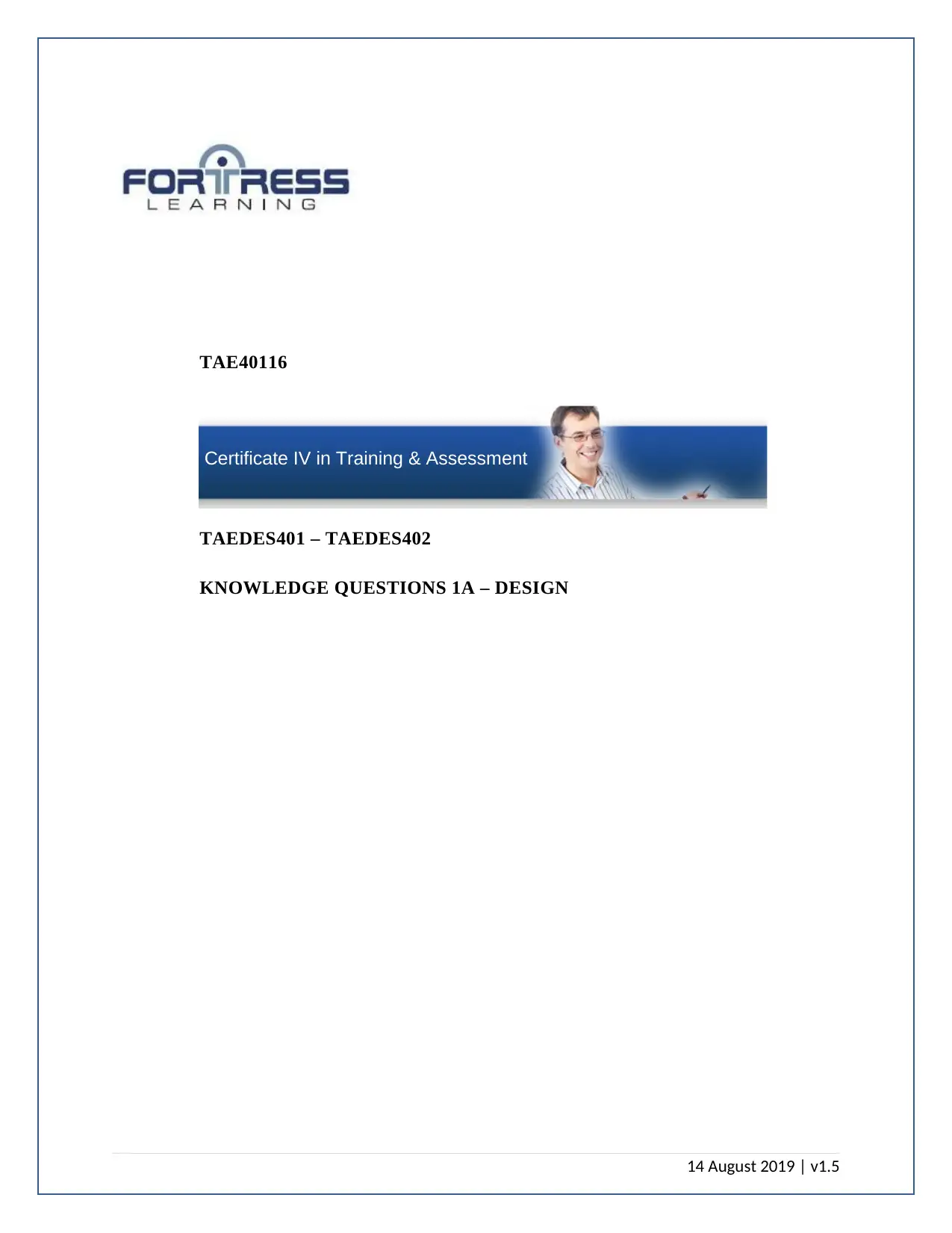
14 August 2019 | v1.5
TAE40116
TAEDES401 – TAEDES402
KNOWLEDGE QUESTIONS 1A – DESIGN
Certificate IV in Training & Assessment
TAE40116
TAEDES401 – TAEDES402
KNOWLEDGE QUESTIONS 1A – DESIGN
Certificate IV in Training & Assessment
Secure Best Marks with AI Grader
Need help grading? Try our AI Grader for instant feedback on your assignments.
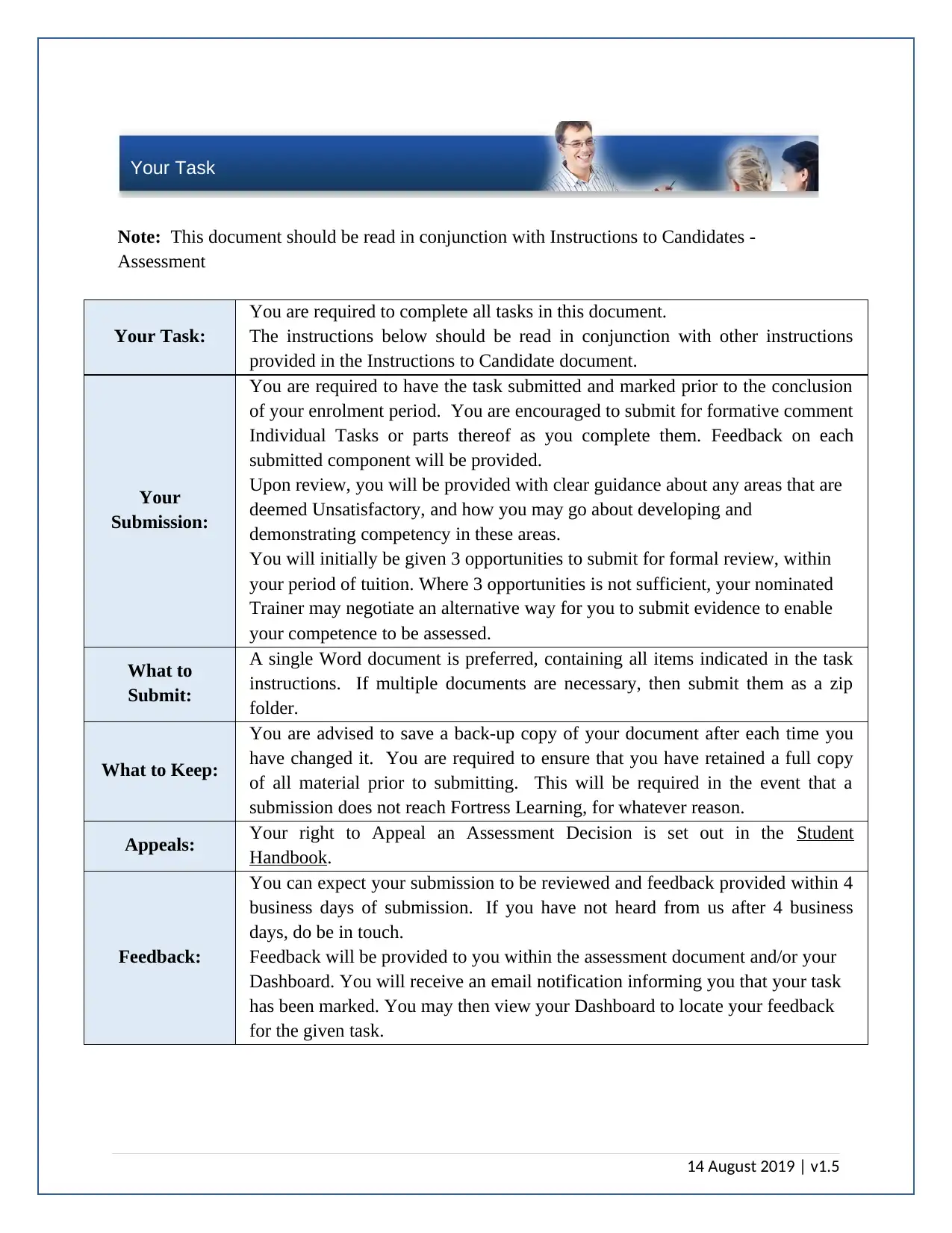
Note: This document should be read in conjunction with Instructions to Candidates -
Assessment
Your Task:
You are required to complete all tasks in this document.
The instructions below should be read in conjunction with other instructions
provided in the Instructions to Candidate document.
Your
Submission:
You are required to have the task submitted and marked prior to the conclusion
of your enrolment period. You are encouraged to submit for formative comment
Individual Tasks or parts thereof as you complete them. Feedback on each
submitted component will be provided.
Upon review, you will be provided with clear guidance about any areas that are
deemed Unsatisfactory, and how you may go about developing and
demonstrating competency in these areas.
You will initially be given 3 opportunities to submit for formal review, within
your period of tuition. Where 3 opportunities is not sufficient, your nominated
Trainer may negotiate an alternative way for you to submit evidence to enable
your competence to be assessed.
What to
Submit:
A single Word document is preferred, containing all items indicated in the task
instructions. If multiple documents are necessary, then submit them as a zip
folder.
What to Keep:
You are advised to save a back-up copy of your document after each time you
have changed it. You are required to ensure that you have retained a full copy
of all material prior to submitting. This will be required in the event that a
submission does not reach Fortress Learning, for whatever reason.
Appeals: Your right to Appeal an Assessment Decision is set out in the Student
Handbook.
Feedback:
You can expect your submission to be reviewed and feedback provided within 4
business days of submission. If you have not heard from us after 4 business
days, do be in touch.
Feedback will be provided to you within the assessment document and/or your
Dashboard. You will receive an email notification informing you that your task
has been marked. You may then view your Dashboard to locate your feedback
for the given task.
14 August 2019 | v1.5
Your Task
Assessment
Your Task:
You are required to complete all tasks in this document.
The instructions below should be read in conjunction with other instructions
provided in the Instructions to Candidate document.
Your
Submission:
You are required to have the task submitted and marked prior to the conclusion
of your enrolment period. You are encouraged to submit for formative comment
Individual Tasks or parts thereof as you complete them. Feedback on each
submitted component will be provided.
Upon review, you will be provided with clear guidance about any areas that are
deemed Unsatisfactory, and how you may go about developing and
demonstrating competency in these areas.
You will initially be given 3 opportunities to submit for formal review, within
your period of tuition. Where 3 opportunities is not sufficient, your nominated
Trainer may negotiate an alternative way for you to submit evidence to enable
your competence to be assessed.
What to
Submit:
A single Word document is preferred, containing all items indicated in the task
instructions. If multiple documents are necessary, then submit them as a zip
folder.
What to Keep:
You are advised to save a back-up copy of your document after each time you
have changed it. You are required to ensure that you have retained a full copy
of all material prior to submitting. This will be required in the event that a
submission does not reach Fortress Learning, for whatever reason.
Appeals: Your right to Appeal an Assessment Decision is set out in the Student
Handbook.
Feedback:
You can expect your submission to be reviewed and feedback provided within 4
business days of submission. If you have not heard from us after 4 business
days, do be in touch.
Feedback will be provided to you within the assessment document and/or your
Dashboard. You will receive an email notification informing you that your task
has been marked. You may then view your Dashboard to locate your feedback
for the given task.
14 August 2019 | v1.5
Your Task
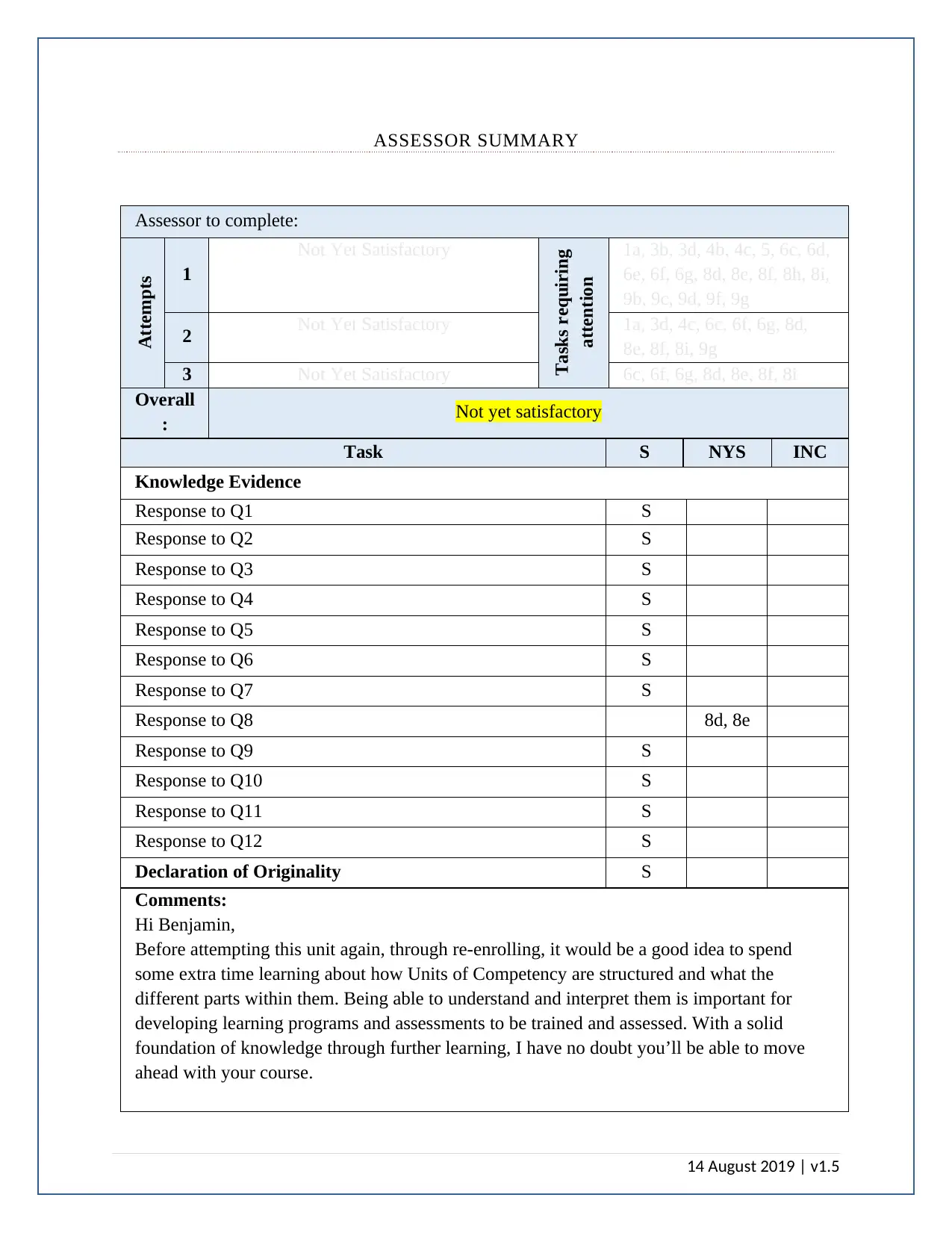
ASSESSOR SUMMARY
Assessor to complete:
Attempts 1
Not Yet Satisfactory
Tasks requiring
attention
1a, 3b, 3d, 4b, 4c, 5, 6c, 6d,
6e, 6f, 6g, 8d, 8e, 8f, 8h, 8i,
9b, 9c, 9d, 9f, 9g
2 Not Yet Satisfactory 1a, 3d, 4c, 6c, 6f, 6g, 8d,
8e, 8f, 8i, 9g
3 Not Yet Satisfactory 6c, 6f, 6g, 8d, 8e, 8f, 8i
Overall
: Not yet satisfactory
Task S NYS INC
Knowledge Evidence
Response to Q1 S
Response to Q2 S
Response to Q3 S
Response to Q4 S
Response to Q5 S
Response to Q6 S
Response to Q7 S
Response to Q8 8d, 8e
Response to Q9 S
Response to Q10 S
Response to Q11 S
Response to Q12 S
Declaration of Originality S
Comments:
Hi Benjamin,
Before attempting this unit again, through re-enrolling, it would be a good idea to spend
some extra time learning about how Units of Competency are structured and what the
different parts within them. Being able to understand and interpret them is important for
developing learning programs and assessments to be trained and assessed. With a solid
foundation of knowledge through further learning, I have no doubt you’ll be able to move
ahead with your course.
14 August 2019 | v1.5
Assessor to complete:
Attempts 1
Not Yet Satisfactory
Tasks requiring
attention
1a, 3b, 3d, 4b, 4c, 5, 6c, 6d,
6e, 6f, 6g, 8d, 8e, 8f, 8h, 8i,
9b, 9c, 9d, 9f, 9g
2 Not Yet Satisfactory 1a, 3d, 4c, 6c, 6f, 6g, 8d,
8e, 8f, 8i, 9g
3 Not Yet Satisfactory 6c, 6f, 6g, 8d, 8e, 8f, 8i
Overall
: Not yet satisfactory
Task S NYS INC
Knowledge Evidence
Response to Q1 S
Response to Q2 S
Response to Q3 S
Response to Q4 S
Response to Q5 S
Response to Q6 S
Response to Q7 S
Response to Q8 8d, 8e
Response to Q9 S
Response to Q10 S
Response to Q11 S
Response to Q12 S
Declaration of Originality S
Comments:
Hi Benjamin,
Before attempting this unit again, through re-enrolling, it would be a good idea to spend
some extra time learning about how Units of Competency are structured and what the
different parts within them. Being able to understand and interpret them is important for
developing learning programs and assessments to be trained and assessed. With a solid
foundation of knowledge through further learning, I have no doubt you’ll be able to move
ahead with your course.
14 August 2019 | v1.5
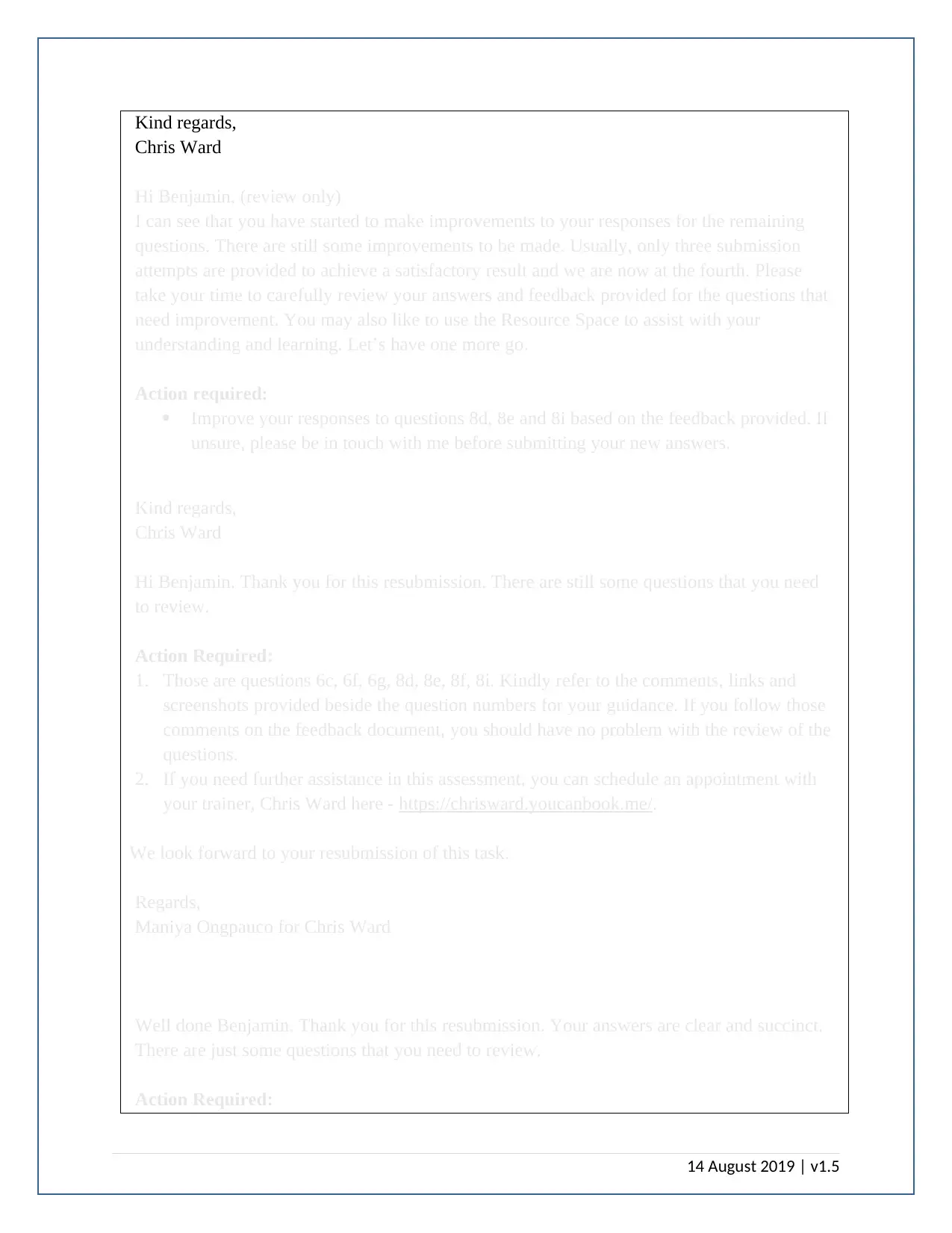
Kind regards,
Chris Ward
Hi Benjamin, (review only)
I can see that you have started to make improvements to your responses for the remaining
questions. There are still some improvements to be made. Usually, only three submission
attempts are provided to achieve a satisfactory result and we are now at the fourth. Please
take your time to carefully review your answers and feedback provided for the questions that
need improvement. You may also like to use the Resource Space to assist with your
understanding and learning. Let’s have one more go.
Action required:
Improve your responses to questions 8d, 8e and 8i based on the feedback provided. If
unsure, please be in touch with me before submitting your new answers.
Kind regards,
Chris Ward
Hi Benjamin. Thank you for this resubmission. There are still some questions that you need
to review.
Action Required:
1. Those are questions 6c, 6f, 6g, 8d, 8e, 8f, 8i. Kindly refer to the comments, links and
screenshots provided beside the question numbers for your guidance. If you follow those
comments on the feedback document, you should have no problem with the review of the
questions.
2. If you need further assistance in this assessment, you can schedule an appointment with
your trainer, Chris Ward here - https://chrisward.youcanbook.me/.
We look forward to your resubmission of this task.
Regards,
Maniya Ongpauco for Chris Ward
Well done Benjamin. Thank you for this resubmission. Your answers are clear and succinct.
There are just some questions that you need to review.
Action Required:
14 August 2019 | v1.5
Chris Ward
Hi Benjamin, (review only)
I can see that you have started to make improvements to your responses for the remaining
questions. There are still some improvements to be made. Usually, only three submission
attempts are provided to achieve a satisfactory result and we are now at the fourth. Please
take your time to carefully review your answers and feedback provided for the questions that
need improvement. You may also like to use the Resource Space to assist with your
understanding and learning. Let’s have one more go.
Action required:
Improve your responses to questions 8d, 8e and 8i based on the feedback provided. If
unsure, please be in touch with me before submitting your new answers.
Kind regards,
Chris Ward
Hi Benjamin. Thank you for this resubmission. There are still some questions that you need
to review.
Action Required:
1. Those are questions 6c, 6f, 6g, 8d, 8e, 8f, 8i. Kindly refer to the comments, links and
screenshots provided beside the question numbers for your guidance. If you follow those
comments on the feedback document, you should have no problem with the review of the
questions.
2. If you need further assistance in this assessment, you can schedule an appointment with
your trainer, Chris Ward here - https://chrisward.youcanbook.me/.
We look forward to your resubmission of this task.
Regards,
Maniya Ongpauco for Chris Ward
Well done Benjamin. Thank you for this resubmission. Your answers are clear and succinct.
There are just some questions that you need to review.
Action Required:
14 August 2019 | v1.5
Secure Best Marks with AI Grader
Need help grading? Try our AI Grader for instant feedback on your assignments.
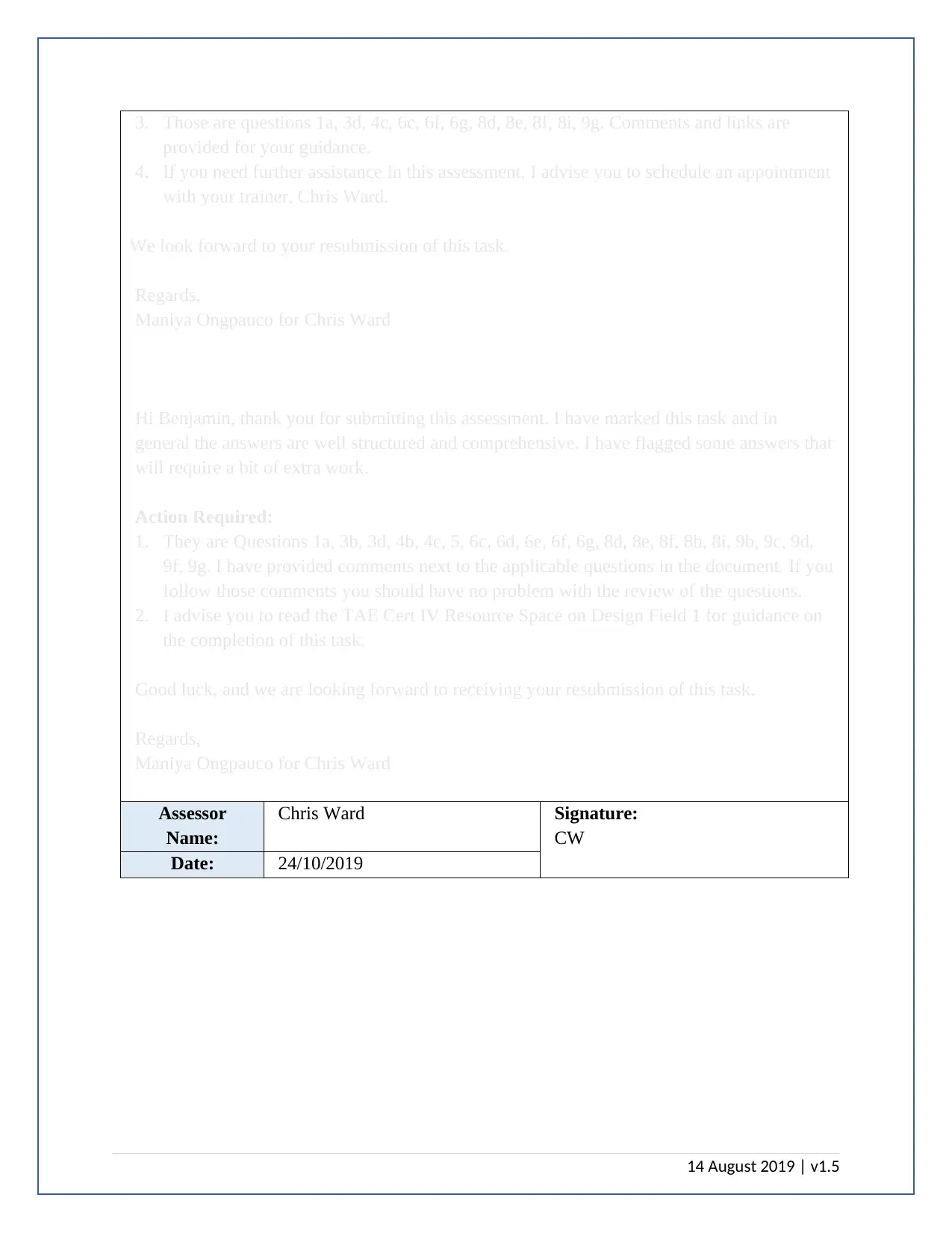
3. Those are questions 1a, 3d, 4c, 6c, 6f, 6g, 8d, 8e, 8f, 8i, 9g. Comments and links are
provided for your guidance.
4. If you need further assistance in this assessment, I advise you to schedule an appointment
with your trainer, Chris Ward.
We look forward to your resubmission of this task.
Regards,
Maniya Ongpauco for Chris Ward
Hi Benjamin, thank you for submitting this assessment. I have marked this task and in
general the answers are well structured and comprehensive. I have flagged some answers that
will require a bit of extra work.
Action Required:
1. They are Questions 1a, 3b, 3d, 4b, 4c, 5, 6c, 6d, 6e, 6f, 6g, 8d, 8e, 8f, 8h, 8i, 9b, 9c, 9d,
9f, 9g. I have provided comments next to the applicable questions in the document. If you
follow those comments you should have no problem with the review of the questions.
2. I advise you to read the TAE Cert IV Resource Space on Design Field 1 for guidance on
the completion of this task.
Good luck, and we are looking forward to receiving your resubmission of this task.
Regards,
Maniya Ongpauco for Chris Ward
Assessor
Name:
Chris Ward Signature:
CW
Date: 24/10/2019
14 August 2019 | v1.5
provided for your guidance.
4. If you need further assistance in this assessment, I advise you to schedule an appointment
with your trainer, Chris Ward.
We look forward to your resubmission of this task.
Regards,
Maniya Ongpauco for Chris Ward
Hi Benjamin, thank you for submitting this assessment. I have marked this task and in
general the answers are well structured and comprehensive. I have flagged some answers that
will require a bit of extra work.
Action Required:
1. They are Questions 1a, 3b, 3d, 4b, 4c, 5, 6c, 6d, 6e, 6f, 6g, 8d, 8e, 8f, 8h, 8i, 9b, 9c, 9d,
9f, 9g. I have provided comments next to the applicable questions in the document. If you
follow those comments you should have no problem with the review of the questions.
2. I advise you to read the TAE Cert IV Resource Space on Design Field 1 for guidance on
the completion of this task.
Good luck, and we are looking forward to receiving your resubmission of this task.
Regards,
Maniya Ongpauco for Chris Ward
Assessor
Name:
Chris Ward Signature:
CW
Date: 24/10/2019
14 August 2019 | v1.5
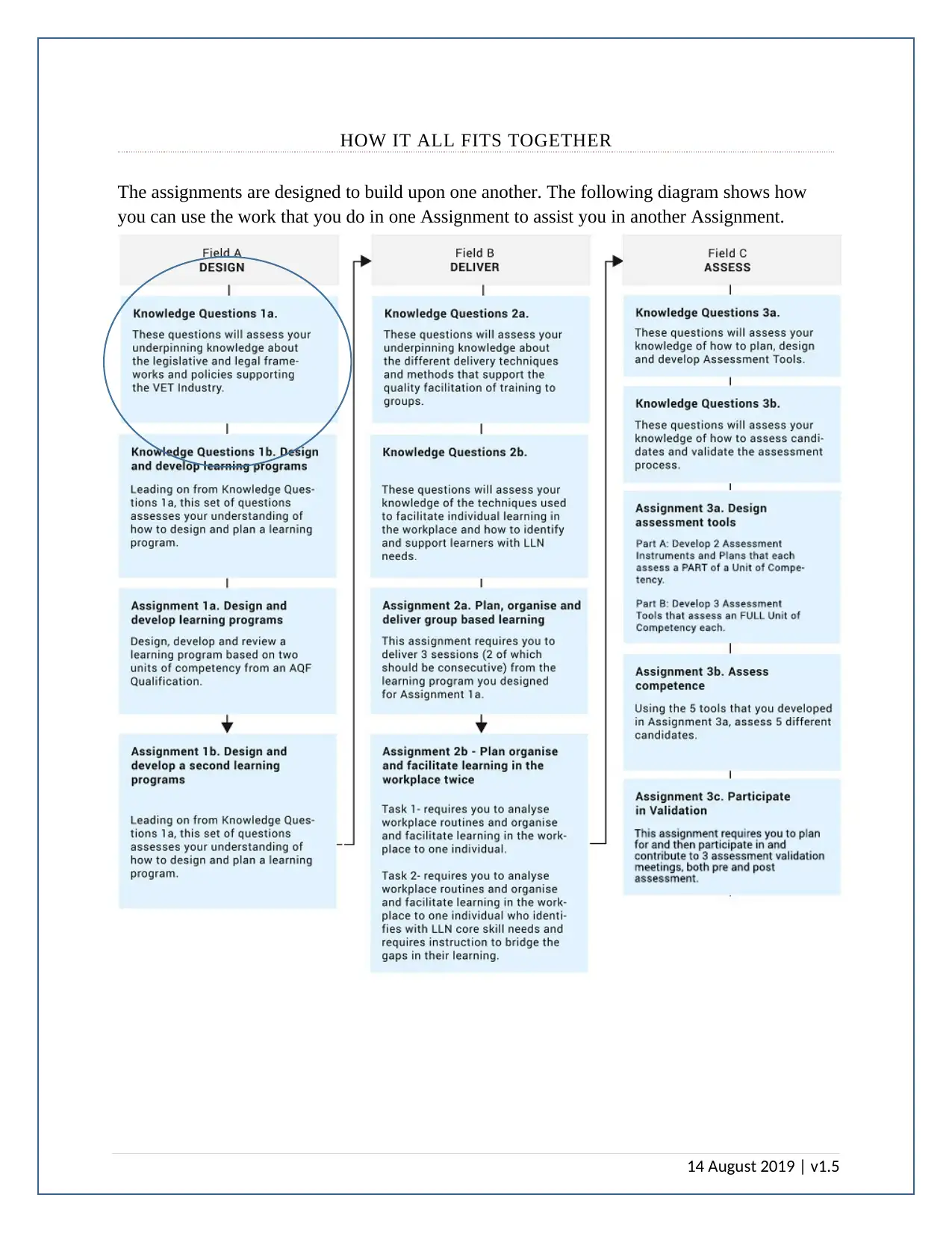
HOW IT ALL FITS TOGETHER
The assignments are designed to build upon one another. The following diagram shows how
you can use the work that you do in one Assignment to assist you in another Assignment.
14 August 2019 | v1.5
The assignments are designed to build upon one another. The following diagram shows how
you can use the work that you do in one Assignment to assist you in another Assignment.
14 August 2019 | v1.5
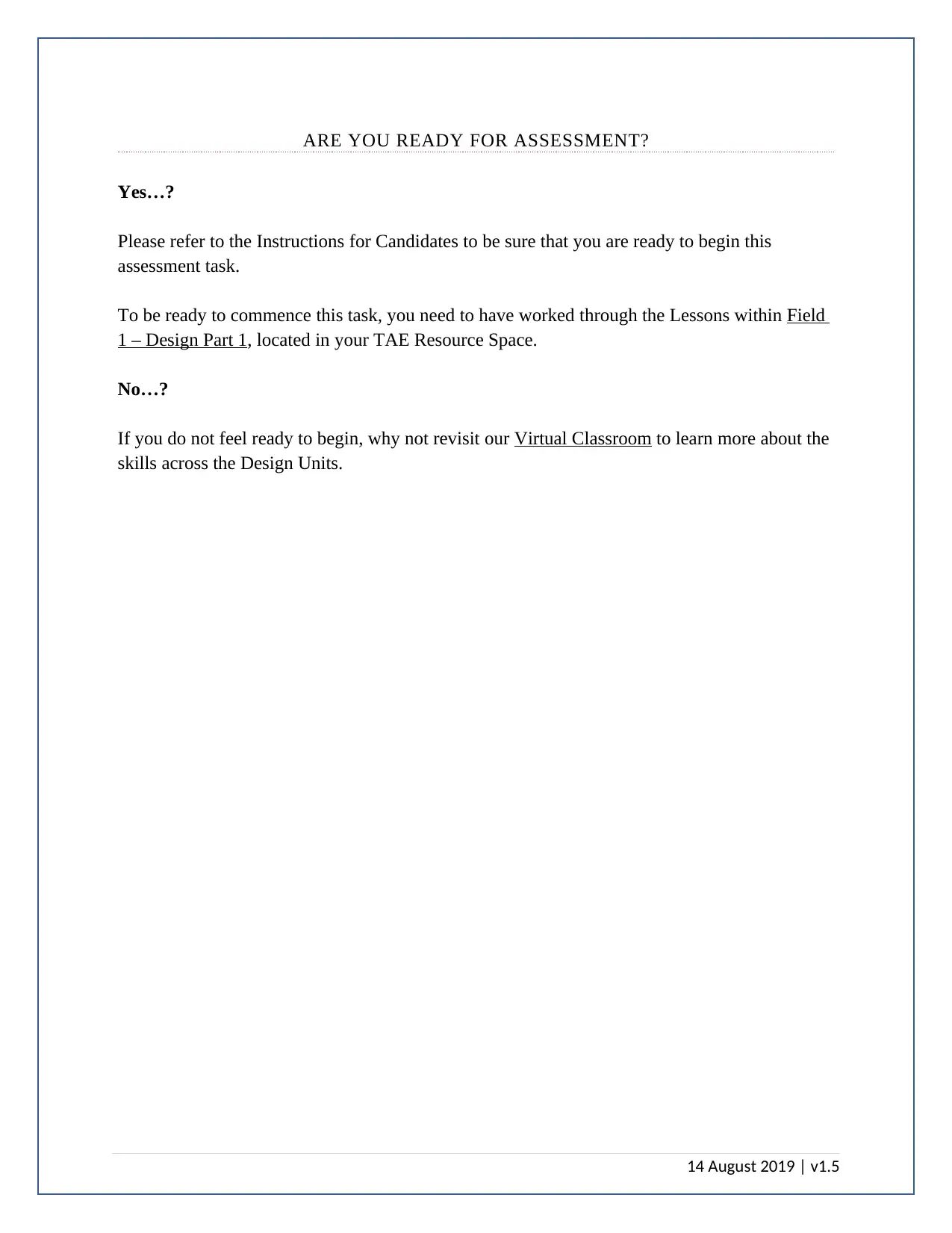
ARE YOU READY FOR ASSESSMENT?
Yes…?
Please refer to the Instructions for Candidates to be sure that you are ready to begin this
assessment task.
To be ready to commence this task, you need to have worked through the Lessons within Field
1 – Design Part 1, located in your TAE Resource Space.
No…?
If you do not feel ready to begin, why not revisit our Virtual Classroom to learn more about the
skills across the Design Units.
14 August 2019 | v1.5
Yes…?
Please refer to the Instructions for Candidates to be sure that you are ready to begin this
assessment task.
To be ready to commence this task, you need to have worked through the Lessons within Field
1 – Design Part 1, located in your TAE Resource Space.
No…?
If you do not feel ready to begin, why not revisit our Virtual Classroom to learn more about the
skills across the Design Units.
14 August 2019 | v1.5
Paraphrase This Document
Need a fresh take? Get an instant paraphrase of this document with our AI Paraphraser
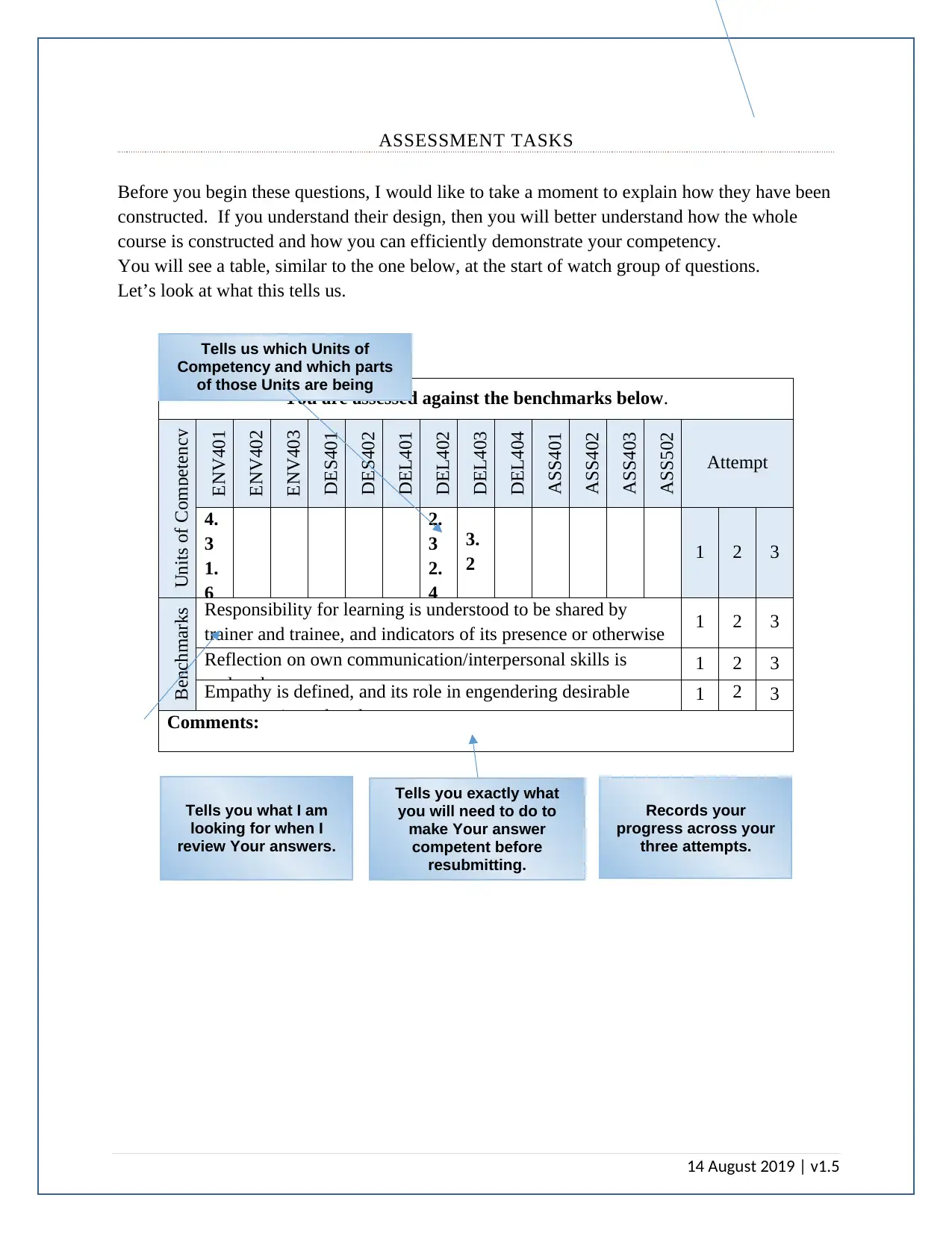
ASSESSMENT TASKS
Before you begin these questions, I would like to take a moment to explain how they have been
constructed. If you understand their design, then you will better understand how the whole
course is constructed and how you can efficiently demonstrate your competency.
You will see a table, similar to the one below, at the start of watch group of questions.
Let’s look at what this tells us.
You are assessed against the benchmarks below.
Units of Competency
ENV401
ENV402
ENV403
DES401
DES402
DEL401
DEL402
DEL403
DEL404
ASS401
ASS402
ASS403
ASS502
Attempt
4.
3
1.
6
2.
3
2.
4
3.
2 1 2 3
Benchmarks Responsibility for learning is understood to be shared by
trainer and trainee, and indicators of its presence or otherwise
in a training situation are recognized
1 2 3
Reflection on own communication/interpersonal skills is
undertaken
1 2 3
Empathy is defined, and its role in engendering desirable
outcomes is explored
1 2 3
Comments:
14 August 2019 | v1.5
Tells us which Units of
Competency and which parts
of those Units are being
assessed.
Tells you what I am
looking for when I
review Your answers.
Tells you exactly what
you will need to do to
make Your answer
competent before
resubmitting.
Records your
progress across your
three attempts.
Before you begin these questions, I would like to take a moment to explain how they have been
constructed. If you understand their design, then you will better understand how the whole
course is constructed and how you can efficiently demonstrate your competency.
You will see a table, similar to the one below, at the start of watch group of questions.
Let’s look at what this tells us.
You are assessed against the benchmarks below.
Units of Competency
ENV401
ENV402
ENV403
DES401
DES402
DEL401
DEL402
DEL403
DEL404
ASS401
ASS402
ASS403
ASS502
Attempt
4.
3
1.
6
2.
3
2.
4
3.
2 1 2 3
Benchmarks Responsibility for learning is understood to be shared by
trainer and trainee, and indicators of its presence or otherwise
in a training situation are recognized
1 2 3
Reflection on own communication/interpersonal skills is
undertaken
1 2 3
Empathy is defined, and its role in engendering desirable
outcomes is explored
1 2 3
Comments:
14 August 2019 | v1.5
Tells us which Units of
Competency and which parts
of those Units are being
assessed.
Tells you what I am
looking for when I
review Your answers.
Tells you exactly what
you will need to do to
make Your answer
competent before
resubmitting.
Records your
progress across your
three attempts.
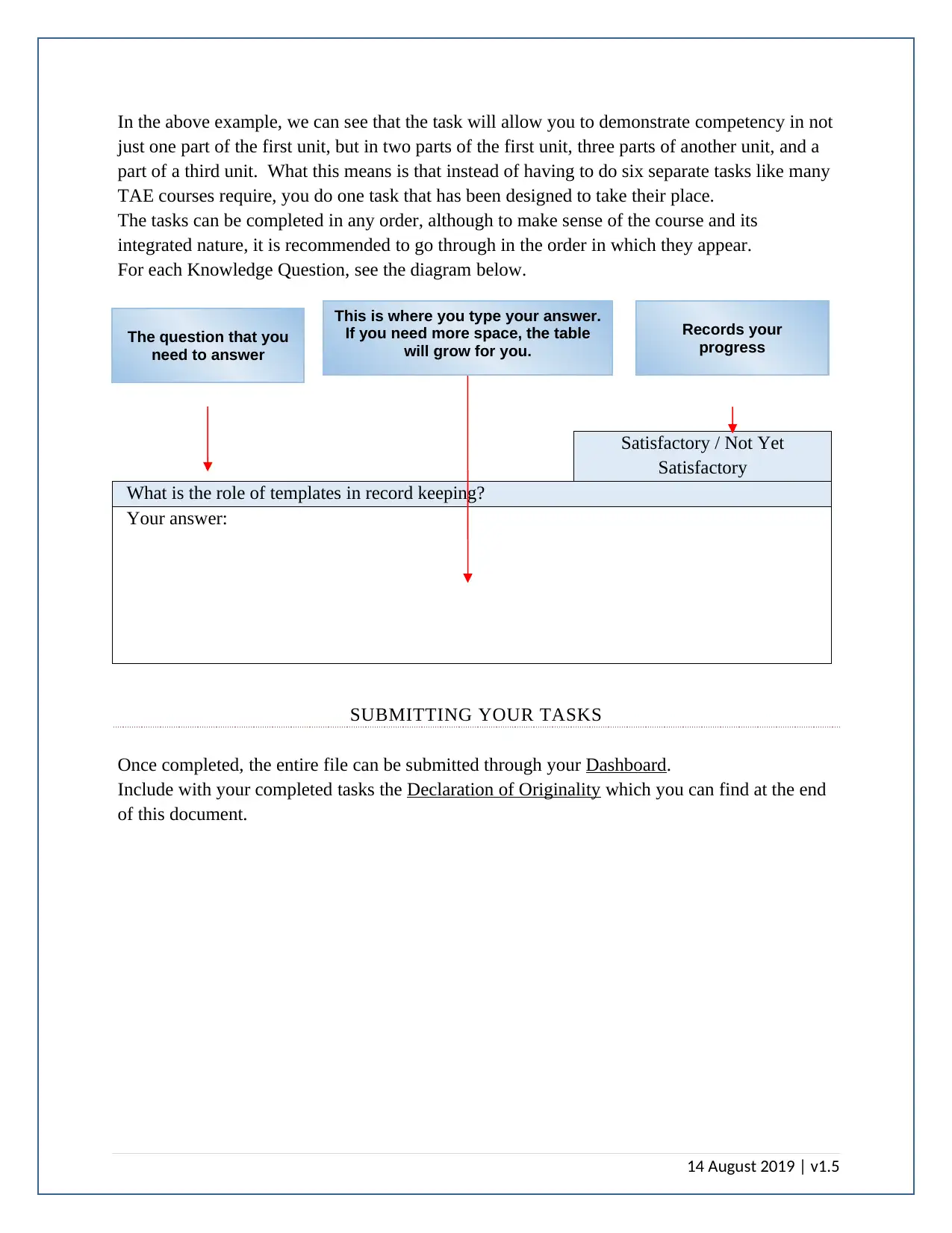
In the above example, we can see that the task will allow you to demonstrate competency in not
just one part of the first unit, but in two parts of the first unit, three parts of another unit, and a
part of a third unit. What this means is that instead of having to do six separate tasks like many
TAE courses require, you do one task that has been designed to take their place.
The tasks can be completed in any order, although to make sense of the course and its
integrated nature, it is recommended to go through in the order in which they appear.
For each Knowledge Question, see the diagram below.
Satisfactory / Not Yet
Satisfactory
What is the role of templates in record keeping?
Your answer:
SUBMITTING YOUR TASKS
Once completed, the entire file can be submitted through your Dashboard.
Include with your completed tasks the Declaration of Originality which you can find at the end
of this document.
14 August 2019 | v1.5
This is where you type your answer.
If you need more space, the table
will grow for you.
The question that you
need to answer
Records your
progress
just one part of the first unit, but in two parts of the first unit, three parts of another unit, and a
part of a third unit. What this means is that instead of having to do six separate tasks like many
TAE courses require, you do one task that has been designed to take their place.
The tasks can be completed in any order, although to make sense of the course and its
integrated nature, it is recommended to go through in the order in which they appear.
For each Knowledge Question, see the diagram below.
Satisfactory / Not Yet
Satisfactory
What is the role of templates in record keeping?
Your answer:
SUBMITTING YOUR TASKS
Once completed, the entire file can be submitted through your Dashboard.
Include with your completed tasks the Declaration of Originality which you can find at the end
of this document.
14 August 2019 | v1.5
This is where you type your answer.
If you need more space, the table
will grow for you.
The question that you
need to answer
Records your
progress
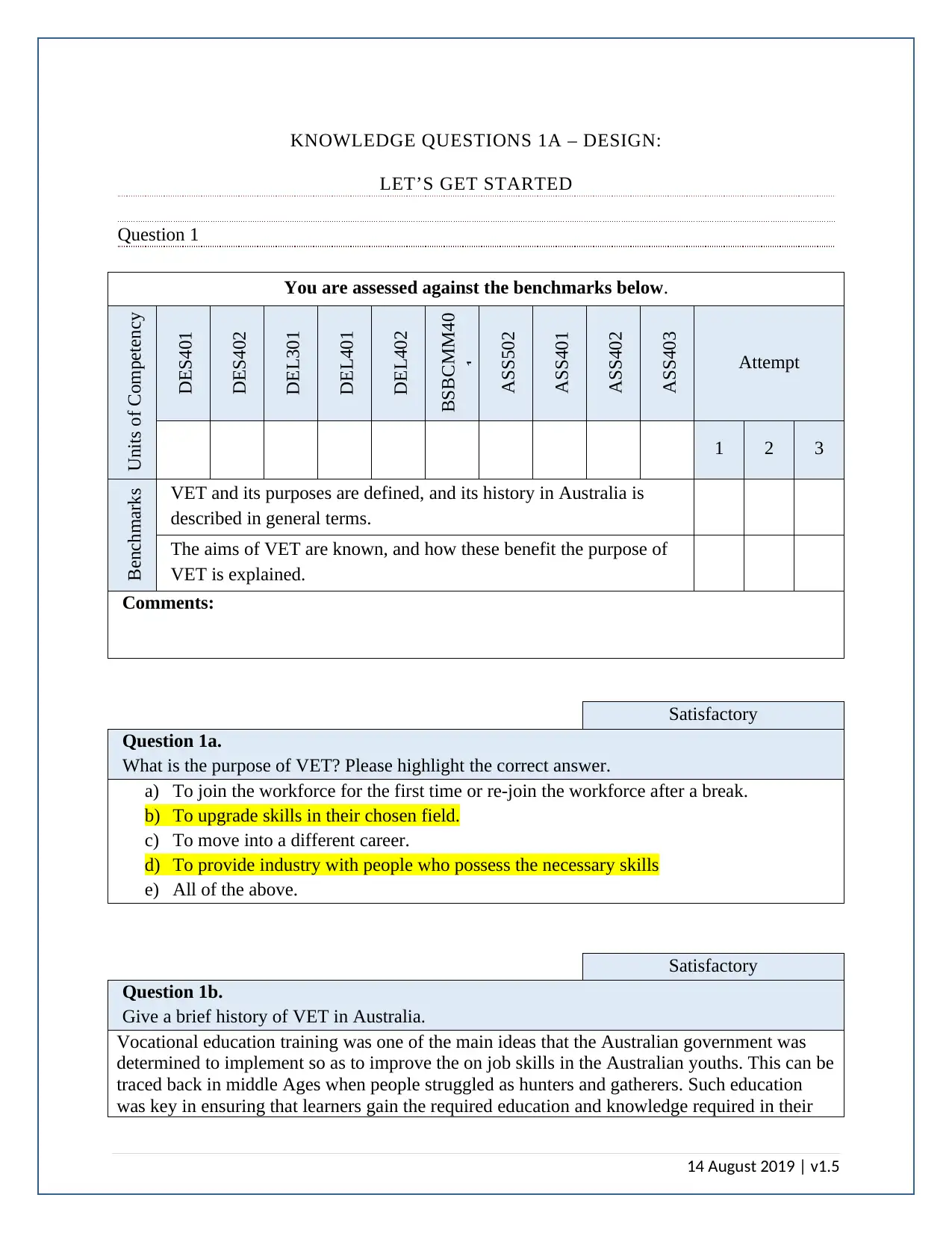
KNOWLEDGE QUESTIONS 1A – DESIGN:
LET’S GET STARTED
Question 1
You are assessed against the benchmarks below.
Units of Competency
DES401
DES402
DEL301
DEL401
DEL402
BSBCMM40
1
ASS502
ASS401
ASS402
ASS403
Attempt
1 2 3
Benchmarks VET and its purposes are defined, and its history in Australia is
described in general terms.
The aims of VET are known, and how these benefit the purpose of
VET is explained.
Comments:
Satisfactory
Question 1a.
What is the purpose of VET? Please highlight the correct answer.
a) To join the workforce for the first time or re-join the workforce after a break.
b) To upgrade skills in their chosen field.
c) To move into a different career.
d) To provide industry with people who possess the necessary skills
e) All of the above.
Satisfactory
Question 1b.
Give a brief history of VET in Australia.
Vocational education training was one of the main ideas that the Australian government was
determined to implement so as to improve the on job skills in the Australian youths. This can be
traced back in middle Ages when people struggled as hunters and gatherers. Such education
was key in ensuring that learners gain the required education and knowledge required in their
14 August 2019 | v1.5
LET’S GET STARTED
Question 1
You are assessed against the benchmarks below.
Units of Competency
DES401
DES402
DEL301
DEL401
DEL402
BSBCMM40
1
ASS502
ASS401
ASS402
ASS403
Attempt
1 2 3
Benchmarks VET and its purposes are defined, and its history in Australia is
described in general terms.
The aims of VET are known, and how these benefit the purpose of
VET is explained.
Comments:
Satisfactory
Question 1a.
What is the purpose of VET? Please highlight the correct answer.
a) To join the workforce for the first time or re-join the workforce after a break.
b) To upgrade skills in their chosen field.
c) To move into a different career.
d) To provide industry with people who possess the necessary skills
e) All of the above.
Satisfactory
Question 1b.
Give a brief history of VET in Australia.
Vocational education training was one of the main ideas that the Australian government was
determined to implement so as to improve the on job skills in the Australian youths. This can be
traced back in middle Ages when people struggled as hunters and gatherers. Such education
was key in ensuring that learners gain the required education and knowledge required in their
14 August 2019 | v1.5
Secure Best Marks with AI Grader
Need help grading? Try our AI Grader for instant feedback on your assignments.
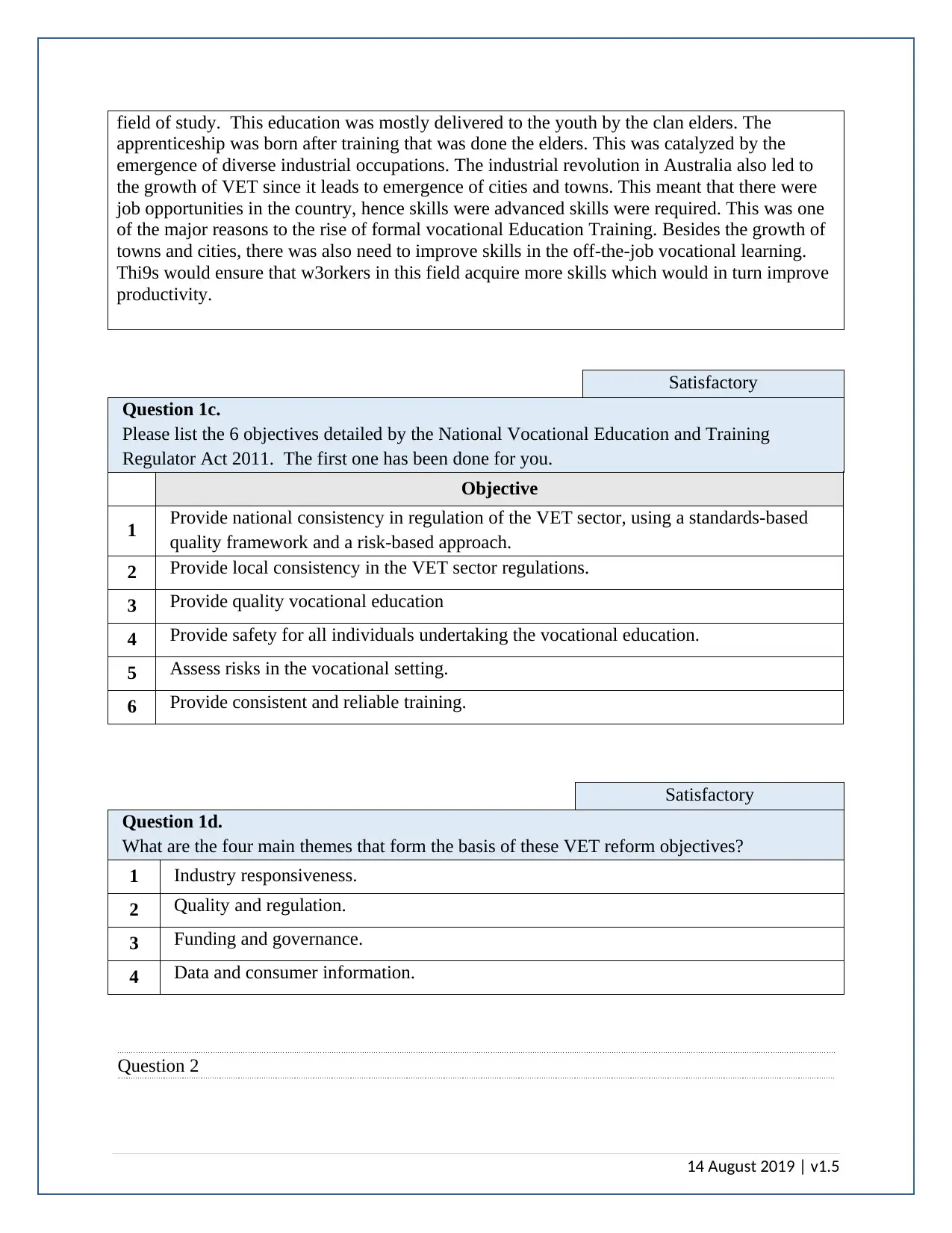
field of study. This education was mostly delivered to the youth by the clan elders. The
apprenticeship was born after training that was done the elders. This was catalyzed by the
emergence of diverse industrial occupations. The industrial revolution in Australia also led to
the growth of VET since it leads to emergence of cities and towns. This meant that there were
job opportunities in the country, hence skills were advanced skills were required. This was one
of the major reasons to the rise of formal vocational Education Training. Besides the growth of
towns and cities, there was also need to improve skills in the off-the-job vocational learning.
Thi9s would ensure that w3orkers in this field acquire more skills which would in turn improve
productivity.
Satisfactory
Question 1c.
Please list the 6 objectives detailed by the National Vocational Education and Training
Regulator Act 2011. The first one has been done for you.
Objective
1 Provide national consistency in regulation of the VET sector, using a standards-based
quality framework and a risk-based approach.
2 Provide local consistency in the VET sector regulations.
3 Provide quality vocational education
4 Provide safety for all individuals undertaking the vocational education.
5 Assess risks in the vocational setting.
6 Provide consistent and reliable training.
Satisfactory
Question 1d.
What are the four main themes that form the basis of these VET reform objectives?
1 Industry responsiveness.
2 Quality and regulation.
3 Funding and governance.
4 Data and consumer information.
Question 2
14 August 2019 | v1.5
apprenticeship was born after training that was done the elders. This was catalyzed by the
emergence of diverse industrial occupations. The industrial revolution in Australia also led to
the growth of VET since it leads to emergence of cities and towns. This meant that there were
job opportunities in the country, hence skills were advanced skills were required. This was one
of the major reasons to the rise of formal vocational Education Training. Besides the growth of
towns and cities, there was also need to improve skills in the off-the-job vocational learning.
Thi9s would ensure that w3orkers in this field acquire more skills which would in turn improve
productivity.
Satisfactory
Question 1c.
Please list the 6 objectives detailed by the National Vocational Education and Training
Regulator Act 2011. The first one has been done for you.
Objective
1 Provide national consistency in regulation of the VET sector, using a standards-based
quality framework and a risk-based approach.
2 Provide local consistency in the VET sector regulations.
3 Provide quality vocational education
4 Provide safety for all individuals undertaking the vocational education.
5 Assess risks in the vocational setting.
6 Provide consistent and reliable training.
Satisfactory
Question 1d.
What are the four main themes that form the basis of these VET reform objectives?
1 Industry responsiveness.
2 Quality and regulation.
3 Funding and governance.
4 Data and consumer information.
Question 2
14 August 2019 | v1.5
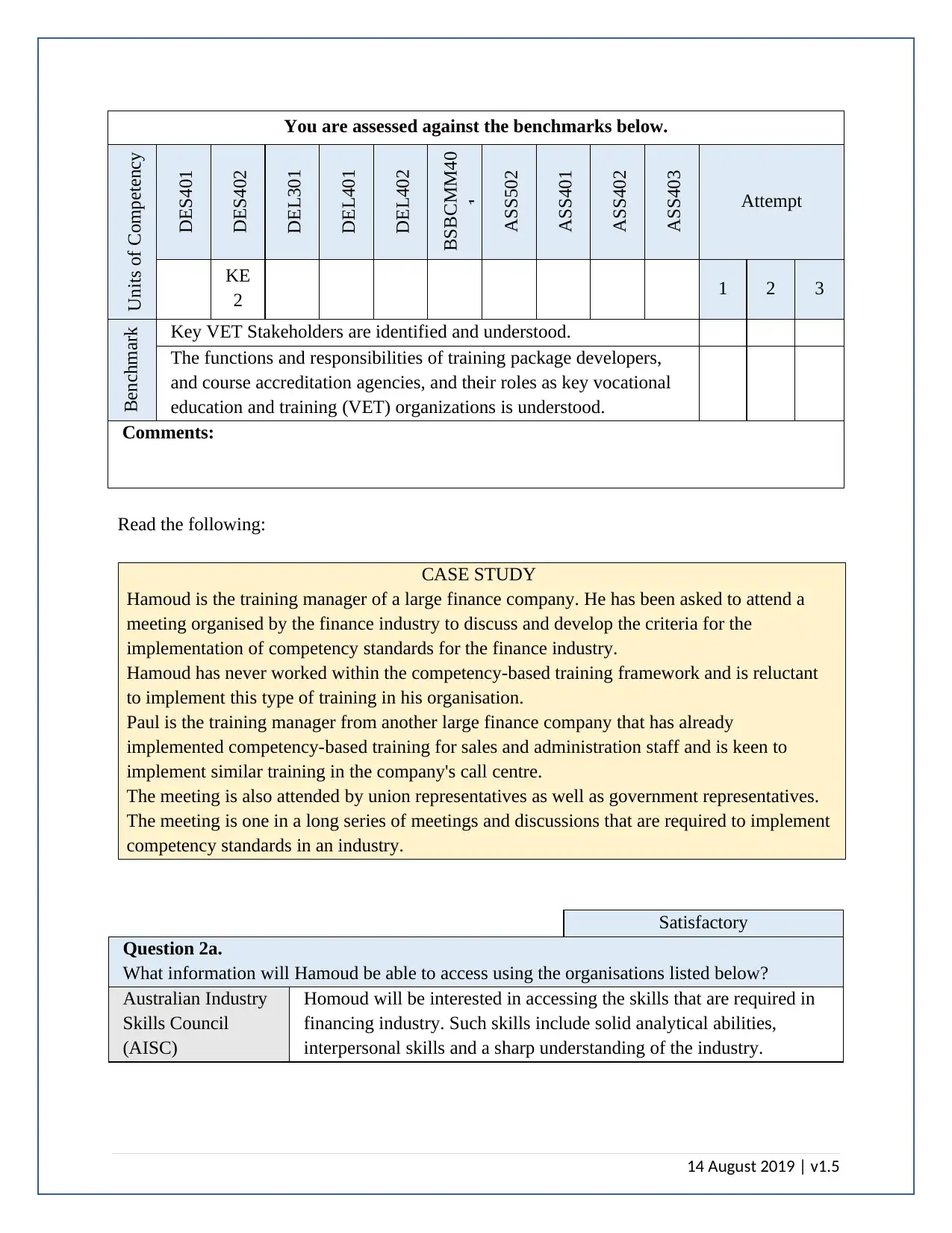
You are assessed against the benchmarks below.
Units of Competency
DES401
DES402
DEL301
DEL401
DEL402
BSBCMM40
1
ASS502
ASS401
ASS402
ASS403
Attempt
KE
2 1 2 3
Benchmark
s
Key VET Stakeholders are identified and understood.
The functions and responsibilities of training package developers,
and course accreditation agencies, and their roles as key vocational
education and training (VET) organizations is understood.
Comments:
Read the following:
CASE STUDY
Hamoud is the training manager of a large finance company. He has been asked to attend a
meeting organised by the finance industry to discuss and develop the criteria for the
implementation of competency standards for the finance industry.
Hamoud has never worked within the competency-based training framework and is reluctant
to implement this type of training in his organisation.
Paul is the training manager from another large finance company that has already
implemented competency-based training for sales and administration staff and is keen to
implement similar training in the company's call centre.
The meeting is also attended by union representatives as well as government representatives.
The meeting is one in a long series of meetings and discussions that are required to implement
competency standards in an industry.
Satisfactory
Question 2a.
What information will Hamoud be able to access using the organisations listed below?
Australian Industry
Skills Council
(AISC)
Homoud will be interested in accessing the skills that are required in
financing industry. Such skills include solid analytical abilities,
interpersonal skills and a sharp understanding of the industry.
14 August 2019 | v1.5
Units of Competency
DES401
DES402
DEL301
DEL401
DEL402
BSBCMM40
1
ASS502
ASS401
ASS402
ASS403
Attempt
KE
2 1 2 3
Benchmark
s
Key VET Stakeholders are identified and understood.
The functions and responsibilities of training package developers,
and course accreditation agencies, and their roles as key vocational
education and training (VET) organizations is understood.
Comments:
Read the following:
CASE STUDY
Hamoud is the training manager of a large finance company. He has been asked to attend a
meeting organised by the finance industry to discuss and develop the criteria for the
implementation of competency standards for the finance industry.
Hamoud has never worked within the competency-based training framework and is reluctant
to implement this type of training in his organisation.
Paul is the training manager from another large finance company that has already
implemented competency-based training for sales and administration staff and is keen to
implement similar training in the company's call centre.
The meeting is also attended by union representatives as well as government representatives.
The meeting is one in a long series of meetings and discussions that are required to implement
competency standards in an industry.
Satisfactory
Question 2a.
What information will Hamoud be able to access using the organisations listed below?
Australian Industry
Skills Council
(AISC)
Homoud will be interested in accessing the skills that are required in
financing industry. Such skills include solid analytical abilities,
interpersonal skills and a sharp understanding of the industry.
14 August 2019 | v1.5
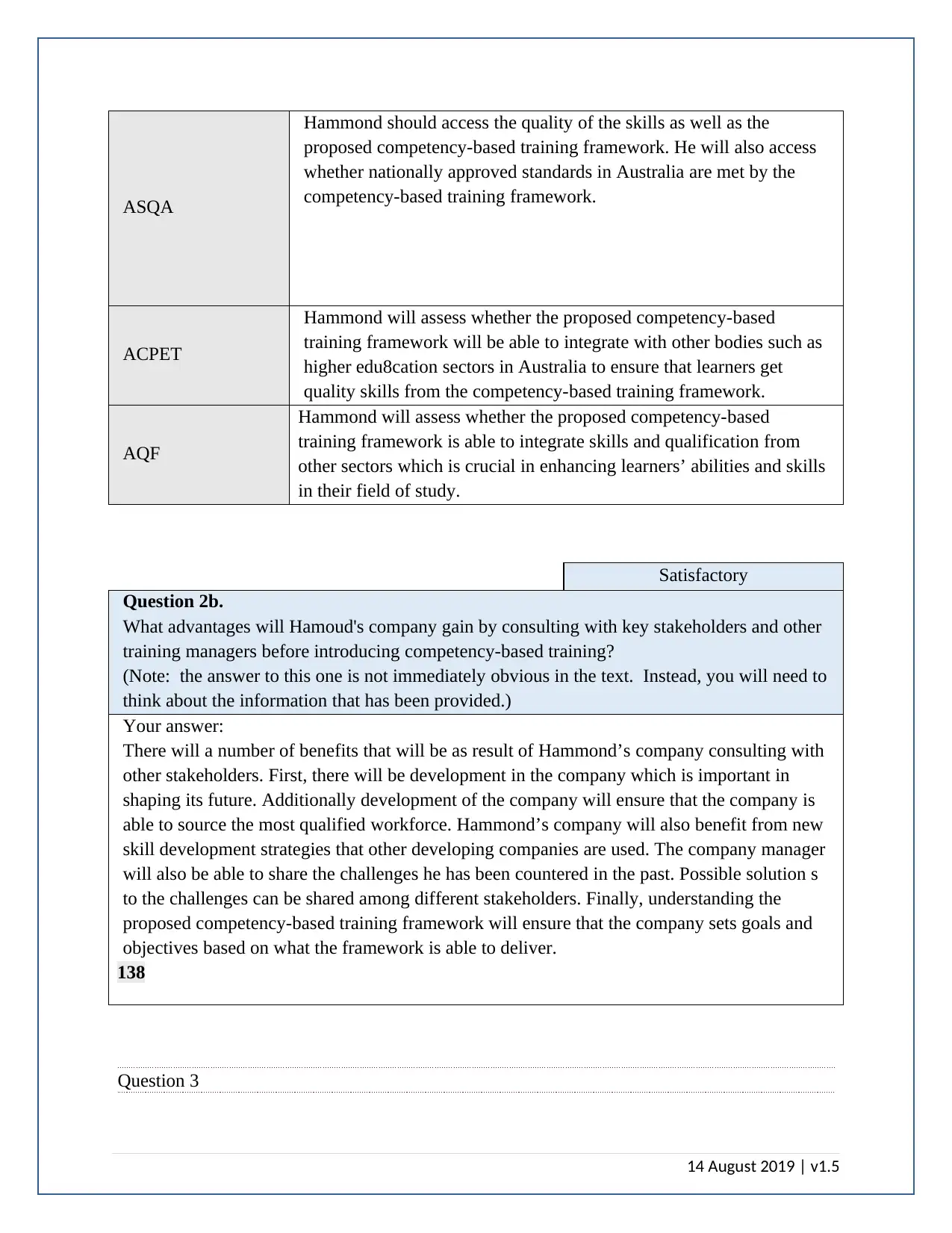
ASQA
Hammond should access the quality of the skills as well as the
proposed competency-based training framework. He will also access
whether nationally approved standards in Australia are met by the
competency-based training framework.
ACPET
Hammond will assess whether the proposed competency-based
training framework will be able to integrate with other bodies such as
higher edu8cation sectors in Australia to ensure that learners get
quality skills from the competency-based training framework.
AQF
Hammond will assess whether the proposed competency-based
training framework is able to integrate skills and qualification from
other sectors which is crucial in enhancing learners’ abilities and skills
in their field of study.
Satisfactory
Question 2b.
What advantages will Hamoud's company gain by consulting with key stakeholders and other
training managers before introducing competency-based training?
(Note: the answer to this one is not immediately obvious in the text. Instead, you will need to
think about the information that has been provided.)
Your answer:
There will a number of benefits that will be as result of Hammond’s company consulting with
other stakeholders. First, there will be development in the company which is important in
shaping its future. Additionally development of the company will ensure that the company is
able to source the most qualified workforce. Hammond’s company will also benefit from new
skill development strategies that other developing companies are used. The company manager
will also be able to share the challenges he has been countered in the past. Possible solution s
to the challenges can be shared among different stakeholders. Finally, understanding the
proposed competency-based training framework will ensure that the company sets goals and
objectives based on what the framework is able to deliver.
138
Question 3
14 August 2019 | v1.5
Hammond should access the quality of the skills as well as the
proposed competency-based training framework. He will also access
whether nationally approved standards in Australia are met by the
competency-based training framework.
ACPET
Hammond will assess whether the proposed competency-based
training framework will be able to integrate with other bodies such as
higher edu8cation sectors in Australia to ensure that learners get
quality skills from the competency-based training framework.
AQF
Hammond will assess whether the proposed competency-based
training framework is able to integrate skills and qualification from
other sectors which is crucial in enhancing learners’ abilities and skills
in their field of study.
Satisfactory
Question 2b.
What advantages will Hamoud's company gain by consulting with key stakeholders and other
training managers before introducing competency-based training?
(Note: the answer to this one is not immediately obvious in the text. Instead, you will need to
think about the information that has been provided.)
Your answer:
There will a number of benefits that will be as result of Hammond’s company consulting with
other stakeholders. First, there will be development in the company which is important in
shaping its future. Additionally development of the company will ensure that the company is
able to source the most qualified workforce. Hammond’s company will also benefit from new
skill development strategies that other developing companies are used. The company manager
will also be able to share the challenges he has been countered in the past. Possible solution s
to the challenges can be shared among different stakeholders. Finally, understanding the
proposed competency-based training framework will ensure that the company sets goals and
objectives based on what the framework is able to deliver.
138
Question 3
14 August 2019 | v1.5
Paraphrase This Document
Need a fresh take? Get an instant paraphrase of this document with our AI Paraphraser
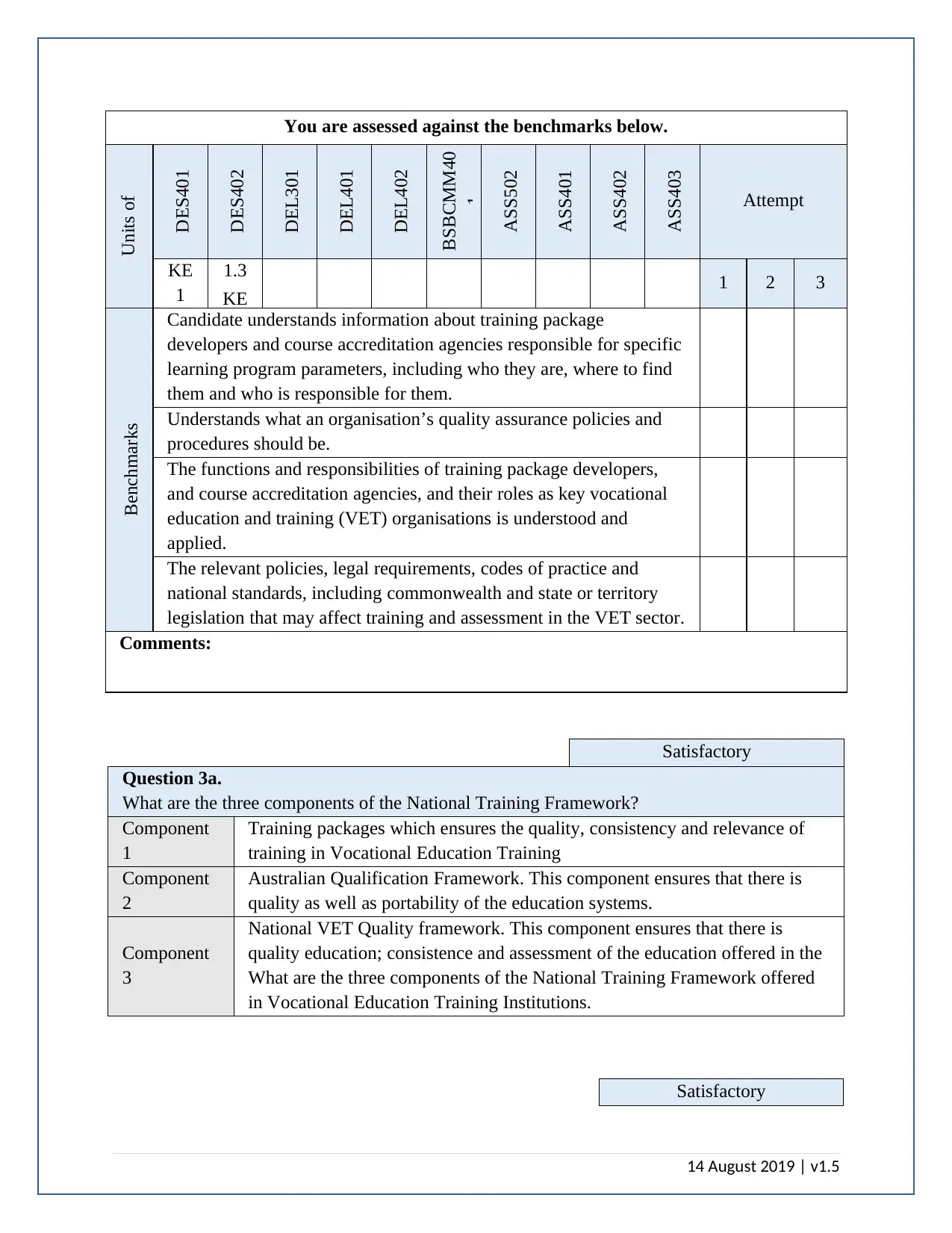
You are assessed against the benchmarks below.
Units of
Competency
DES401
DES402
DEL301
DEL401
DEL402
BSBCMM40
1
ASS502
ASS401
ASS402
ASS403
Attempt
KE
1
1.3
KE 1 2 3
Benchmarks
Candidate understands information about training package
developers and course accreditation agencies responsible for specific
learning program parameters, including who they are, where to find
them and who is responsible for them.
Understands what an organisation’s quality assurance policies and
procedures should be.
The functions and responsibilities of training package developers,
and course accreditation agencies, and their roles as key vocational
education and training (VET) organisations is understood and
applied.
The relevant policies, legal requirements, codes of practice and
national standards, including commonwealth and state or territory
legislation that may affect training and assessment in the VET sector.
Comments:
Satisfactory
Question 3a.
What are the three components of the National Training Framework?
Component
1
Training packages which ensures the quality, consistency and relevance of
training in Vocational Education Training
Component
2
Australian Qualification Framework. This component ensures that there is
quality as well as portability of the education systems.
Component
3
National VET Quality framework. This component ensures that there is
quality education; consistence and assessment of the education offered in the
What are the three components of the National Training Framework offered
in Vocational Education Training Institutions.
Satisfactory
14 August 2019 | v1.5
Units of
Competency
DES401
DES402
DEL301
DEL401
DEL402
BSBCMM40
1
ASS502
ASS401
ASS402
ASS403
Attempt
KE
1
1.3
KE 1 2 3
Benchmarks
Candidate understands information about training package
developers and course accreditation agencies responsible for specific
learning program parameters, including who they are, where to find
them and who is responsible for them.
Understands what an organisation’s quality assurance policies and
procedures should be.
The functions and responsibilities of training package developers,
and course accreditation agencies, and their roles as key vocational
education and training (VET) organisations is understood and
applied.
The relevant policies, legal requirements, codes of practice and
national standards, including commonwealth and state or territory
legislation that may affect training and assessment in the VET sector.
Comments:
Satisfactory
Question 3a.
What are the three components of the National Training Framework?
Component
1
Training packages which ensures the quality, consistency and relevance of
training in Vocational Education Training
Component
2
Australian Qualification Framework. This component ensures that there is
quality as well as portability of the education systems.
Component
3
National VET Quality framework. This component ensures that there is
quality education; consistence and assessment of the education offered in the
What are the three components of the National Training Framework offered
in Vocational Education Training Institutions.
Satisfactory
14 August 2019 | v1.5
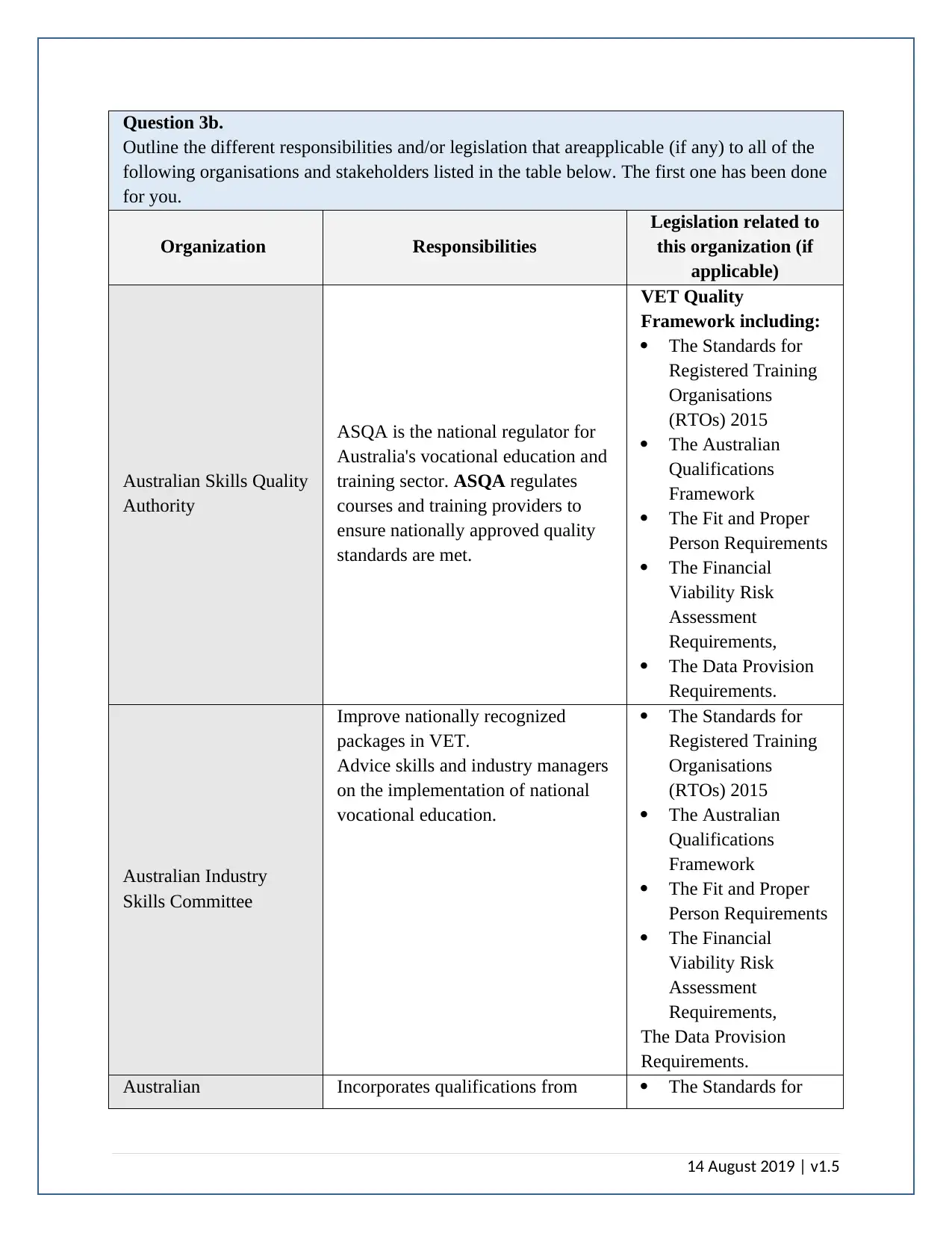
Question 3b.
Outline the different responsibilities and/or legislation that areapplicable (if any) to all of the
following organisations and stakeholders listed in the table below. The first one has been done
for you.
Organization Responsibilities
Legislation related to
this organization (if
applicable)
Australian Skills Quality
Authority
ASQA is the national regulator for
Australia's vocational education and
training sector. ASQA regulates
courses and training providers to
ensure nationally approved quality
standards are met.
VET Quality
Framework including:
The Standards for
Registered Training
Organisations
(RTOs) 2015
The Australian
Qualifications
Framework
The Fit and Proper
Person Requirements
The Financial
Viability Risk
Assessment
Requirements,
The Data Provision
Requirements.
Australian Industry
Skills Committee
Improve nationally recognized
packages in VET.
Advice skills and industry managers
on the implementation of national
vocational education.
The Standards for
Registered Training
Organisations
(RTOs) 2015
The Australian
Qualifications
Framework
The Fit and Proper
Person Requirements
The Financial
Viability Risk
Assessment
Requirements,
The Data Provision
Requirements.
Australian Incorporates qualifications from The Standards for
14 August 2019 | v1.5
Outline the different responsibilities and/or legislation that areapplicable (if any) to all of the
following organisations and stakeholders listed in the table below. The first one has been done
for you.
Organization Responsibilities
Legislation related to
this organization (if
applicable)
Australian Skills Quality
Authority
ASQA is the national regulator for
Australia's vocational education and
training sector. ASQA regulates
courses and training providers to
ensure nationally approved quality
standards are met.
VET Quality
Framework including:
The Standards for
Registered Training
Organisations
(RTOs) 2015
The Australian
Qualifications
Framework
The Fit and Proper
Person Requirements
The Financial
Viability Risk
Assessment
Requirements,
The Data Provision
Requirements.
Australian Industry
Skills Committee
Improve nationally recognized
packages in VET.
Advice skills and industry managers
on the implementation of national
vocational education.
The Standards for
Registered Training
Organisations
(RTOs) 2015
The Australian
Qualifications
Framework
The Fit and Proper
Person Requirements
The Financial
Viability Risk
Assessment
Requirements,
The Data Provision
Requirements.
Australian Incorporates qualifications from The Standards for
14 August 2019 | v1.5
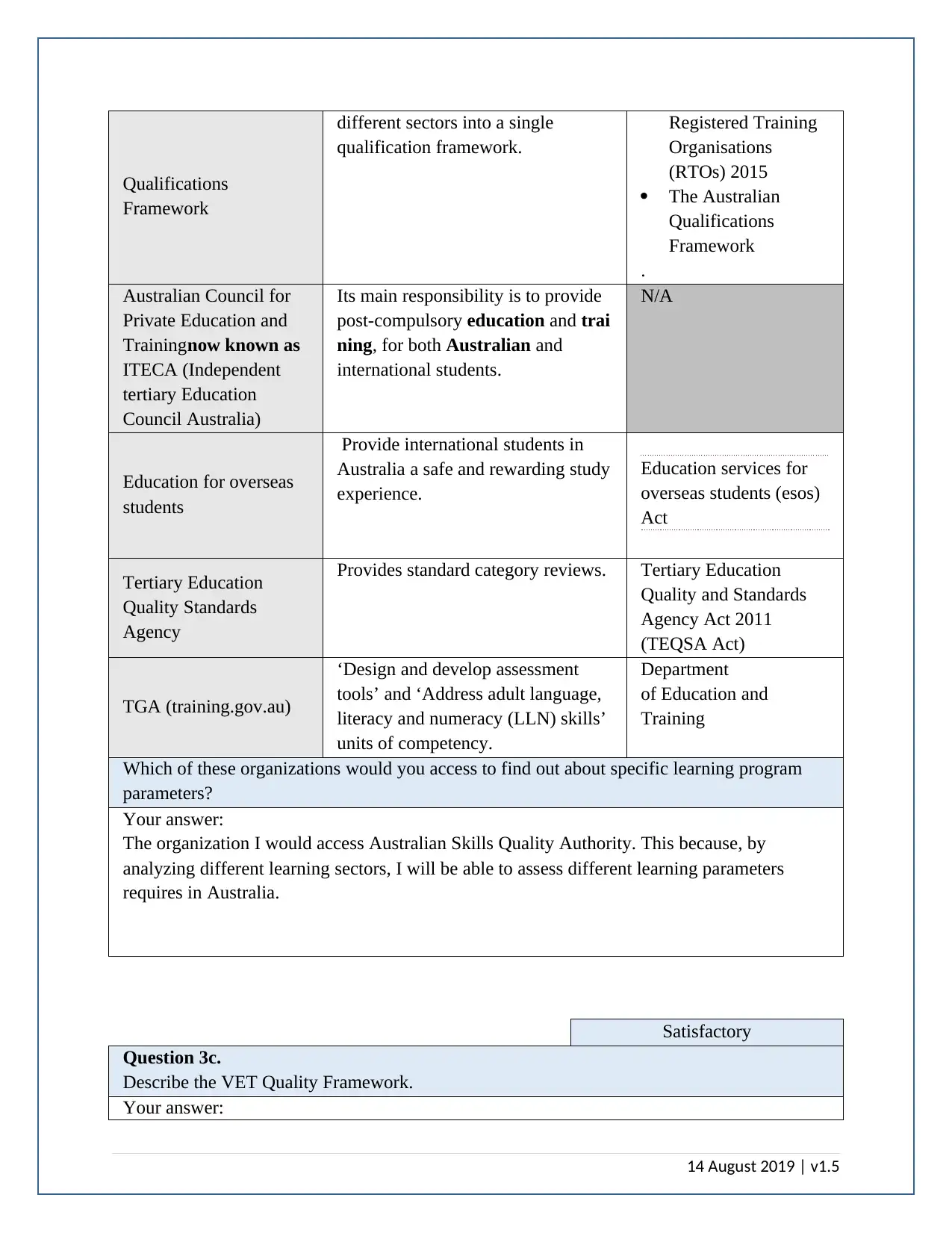
Qualifications
Framework
different sectors into a single
qualification framework.
Registered Training
Organisations
(RTOs) 2015
The Australian
Qualifications
Framework
.
Australian Council for
Private Education and
Trainingnow known as
ITECA (Independent
tertiary Education
Council Australia)
Its main responsibility is to provide
post-compulsory education and trai
ning, for both Australian and
international students.
N/A
Education for overseas
students
Provide international students in
Australia a safe and rewarding study
experience.
Education services for
overseas students (esos)
Act
Tertiary Education
Quality Standards
Agency
Provides standard category reviews. Tertiary Education
Quality and Standards
Agency Act 2011
(TEQSA Act)
TGA (training.gov.au)
‘Design and develop assessment
tools’ and ‘Address adult language,
literacy and numeracy (LLN) skills’
units of competency.
Department
of Education and
Training
Which of these organizations would you access to find out about specific learning program
parameters?
Your answer:
The organization I would access Australian Skills Quality Authority. This because, by
analyzing different learning sectors, I will be able to assess different learning parameters
requires in Australia.
Satisfactory
Question 3c.
Describe the VET Quality Framework.
Your answer:
14 August 2019 | v1.5
Framework
different sectors into a single
qualification framework.
Registered Training
Organisations
(RTOs) 2015
The Australian
Qualifications
Framework
.
Australian Council for
Private Education and
Trainingnow known as
ITECA (Independent
tertiary Education
Council Australia)
Its main responsibility is to provide
post-compulsory education and trai
ning, for both Australian and
international students.
N/A
Education for overseas
students
Provide international students in
Australia a safe and rewarding study
experience.
Education services for
overseas students (esos)
Act
Tertiary Education
Quality Standards
Agency
Provides standard category reviews. Tertiary Education
Quality and Standards
Agency Act 2011
(TEQSA Act)
TGA (training.gov.au)
‘Design and develop assessment
tools’ and ‘Address adult language,
literacy and numeracy (LLN) skills’
units of competency.
Department
of Education and
Training
Which of these organizations would you access to find out about specific learning program
parameters?
Your answer:
The organization I would access Australian Skills Quality Authority. This because, by
analyzing different learning sectors, I will be able to assess different learning parameters
requires in Australia.
Satisfactory
Question 3c.
Describe the VET Quality Framework.
Your answer:
14 August 2019 | v1.5
Secure Best Marks with AI Grader
Need help grading? Try our AI Grader for instant feedback on your assignments.
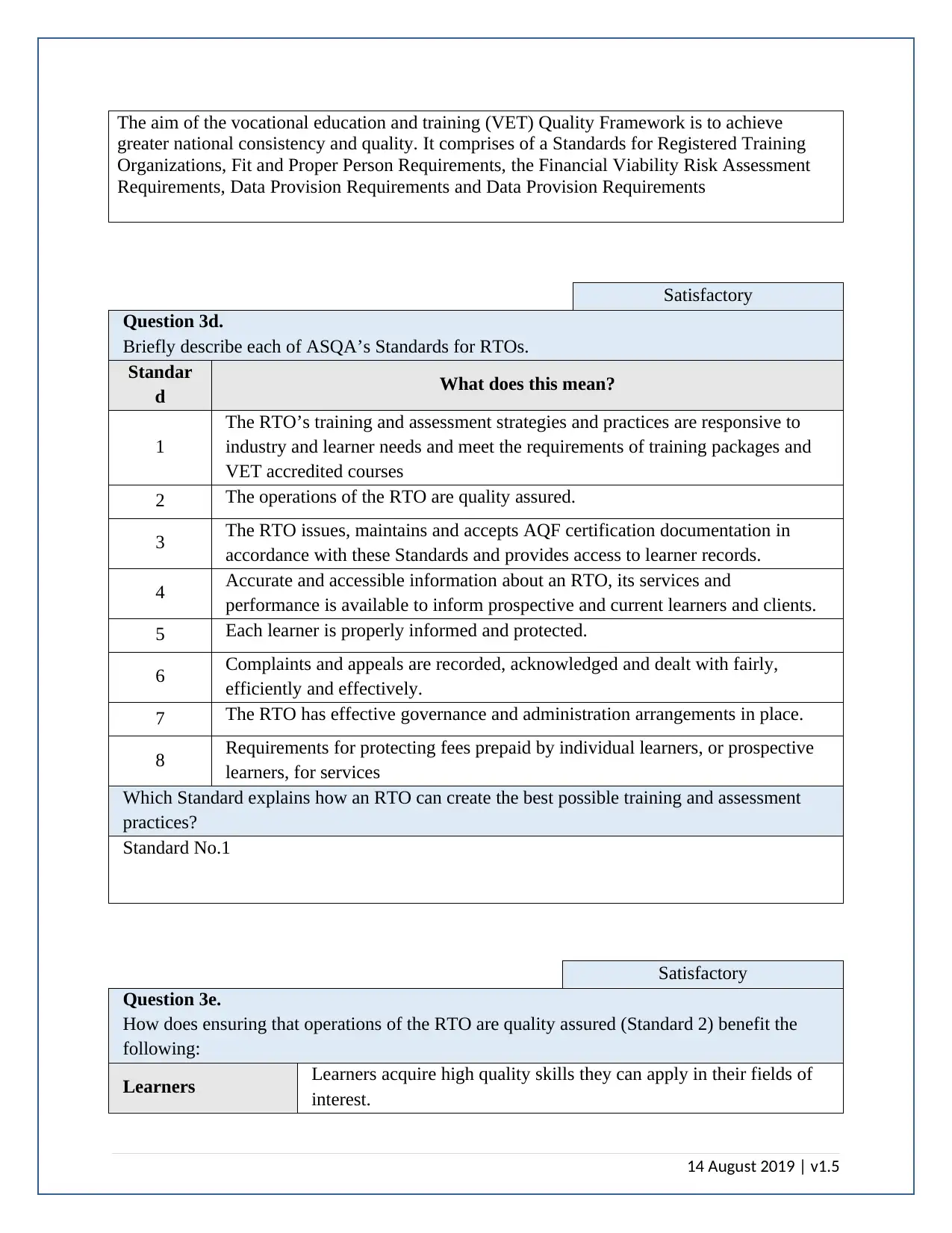
The aim of the vocational education and training (VET) Quality Framework is to achieve
greater national consistency and quality. It comprises of a Standards for Registered Training
Organizations, Fit and Proper Person Requirements, the Financial Viability Risk Assessment
Requirements, Data Provision Requirements and Data Provision Requirements
Satisfactory
Question 3d.
Briefly describe each of ASQA’s Standards for RTOs.
Standar
d What does this mean?
1
The RTO’s training and assessment strategies and practices are responsive to
industry and learner needs and meet the requirements of training packages and
VET accredited courses
2 The operations of the RTO are quality assured.
3 The RTO issues, maintains and accepts AQF certification documentation in
accordance with these Standards and provides access to learner records.
4 Accurate and accessible information about an RTO, its services and
performance is available to inform prospective and current learners and clients.
5 Each learner is properly informed and protected.
6 Complaints and appeals are recorded, acknowledged and dealt with fairly,
efficiently and effectively.
7 The RTO has effective governance and administration arrangements in place.
8 Requirements for protecting fees prepaid by individual learners, or prospective
learners, for services
Which Standard explains how an RTO can create the best possible training and assessment
practices?
Standard No.1
Satisfactory
Question 3e.
How does ensuring that operations of the RTO are quality assured (Standard 2) benefit the
following:
Learners Learners acquire high quality skills they can apply in their fields of
interest.
14 August 2019 | v1.5
greater national consistency and quality. It comprises of a Standards for Registered Training
Organizations, Fit and Proper Person Requirements, the Financial Viability Risk Assessment
Requirements, Data Provision Requirements and Data Provision Requirements
Satisfactory
Question 3d.
Briefly describe each of ASQA’s Standards for RTOs.
Standar
d What does this mean?
1
The RTO’s training and assessment strategies and practices are responsive to
industry and learner needs and meet the requirements of training packages and
VET accredited courses
2 The operations of the RTO are quality assured.
3 The RTO issues, maintains and accepts AQF certification documentation in
accordance with these Standards and provides access to learner records.
4 Accurate and accessible information about an RTO, its services and
performance is available to inform prospective and current learners and clients.
5 Each learner is properly informed and protected.
6 Complaints and appeals are recorded, acknowledged and dealt with fairly,
efficiently and effectively.
7 The RTO has effective governance and administration arrangements in place.
8 Requirements for protecting fees prepaid by individual learners, or prospective
learners, for services
Which Standard explains how an RTO can create the best possible training and assessment
practices?
Standard No.1
Satisfactory
Question 3e.
How does ensuring that operations of the RTO are quality assured (Standard 2) benefit the
following:
Learners Learners acquire high quality skills they can apply in their fields of
interest.
14 August 2019 | v1.5
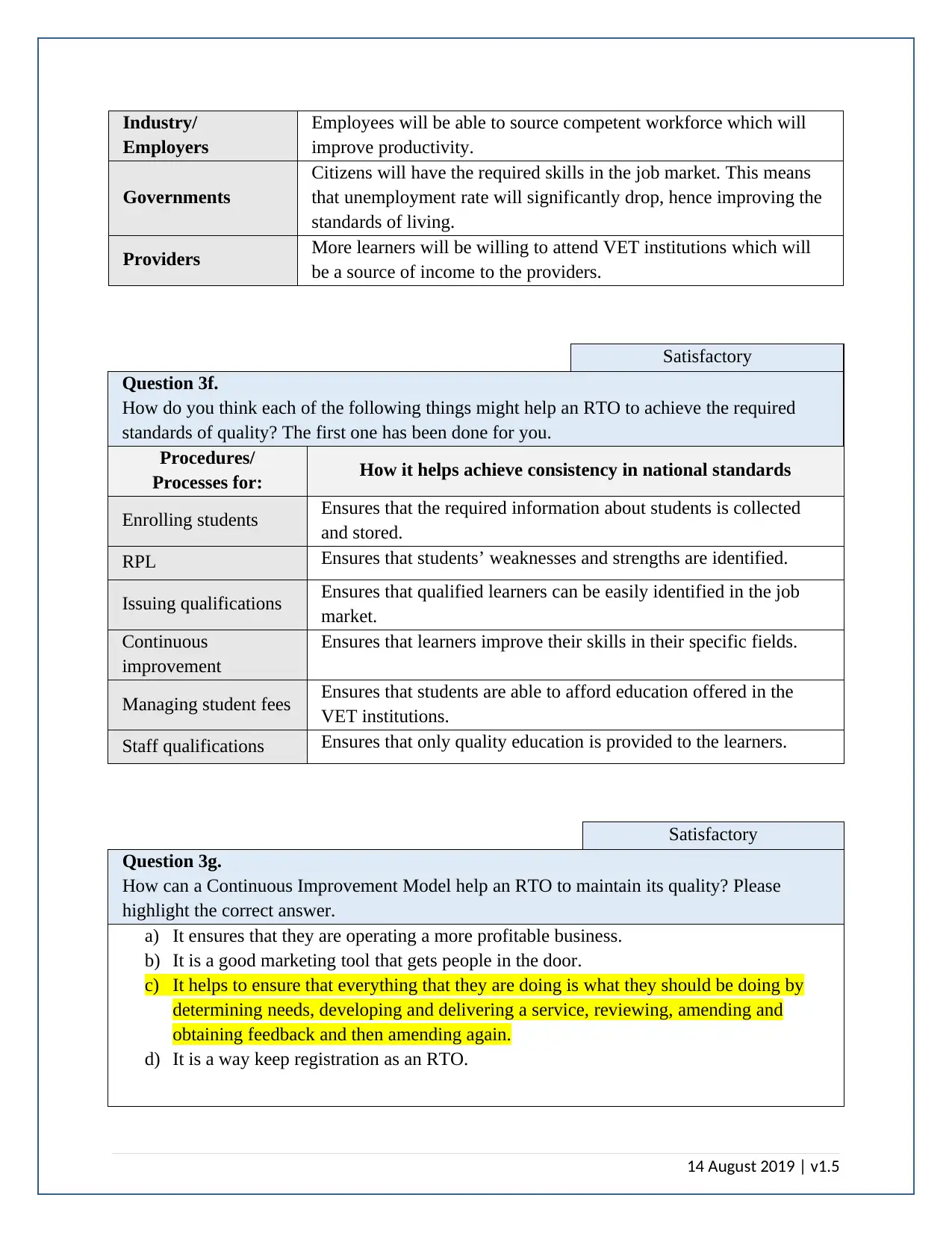
Industry/
Employers
Employees will be able to source competent workforce which will
improve productivity.
Governments
Citizens will have the required skills in the job market. This means
that unemployment rate will significantly drop, hence improving the
standards of living.
Providers More learners will be willing to attend VET institutions which will
be a source of income to the providers.
Satisfactory
Question 3f.
How do you think each of the following things might help an RTO to achieve the required
standards of quality? The first one has been done for you.
Procedures/
Processes for: How it helps achieve consistency in national standards
Enrolling students Ensures that the required information about students is collected
and stored.
RPL Ensures that students’ weaknesses and strengths are identified.
Issuing qualifications Ensures that qualified learners can be easily identified in the job
market.
Continuous
improvement
Ensures that learners improve their skills in their specific fields.
Managing student fees Ensures that students are able to afford education offered in the
VET institutions.
Staff qualifications Ensures that only quality education is provided to the learners.
Satisfactory
Question 3g.
How can a Continuous Improvement Model help an RTO to maintain its quality? Please
highlight the correct answer.
a) It ensures that they are operating a more profitable business.
b) It is a good marketing tool that gets people in the door.
c) It helps to ensure that everything that they are doing is what they should be doing by
determining needs, developing and delivering a service, reviewing, amending and
obtaining feedback and then amending again.
d) It is a way keep registration as an RTO.
14 August 2019 | v1.5
Employers
Employees will be able to source competent workforce which will
improve productivity.
Governments
Citizens will have the required skills in the job market. This means
that unemployment rate will significantly drop, hence improving the
standards of living.
Providers More learners will be willing to attend VET institutions which will
be a source of income to the providers.
Satisfactory
Question 3f.
How do you think each of the following things might help an RTO to achieve the required
standards of quality? The first one has been done for you.
Procedures/
Processes for: How it helps achieve consistency in national standards
Enrolling students Ensures that the required information about students is collected
and stored.
RPL Ensures that students’ weaknesses and strengths are identified.
Issuing qualifications Ensures that qualified learners can be easily identified in the job
market.
Continuous
improvement
Ensures that learners improve their skills in their specific fields.
Managing student fees Ensures that students are able to afford education offered in the
VET institutions.
Staff qualifications Ensures that only quality education is provided to the learners.
Satisfactory
Question 3g.
How can a Continuous Improvement Model help an RTO to maintain its quality? Please
highlight the correct answer.
a) It ensures that they are operating a more profitable business.
b) It is a good marketing tool that gets people in the door.
c) It helps to ensure that everything that they are doing is what they should be doing by
determining needs, developing and delivering a service, reviewing, amending and
obtaining feedback and then amending again.
d) It is a way keep registration as an RTO.
14 August 2019 | v1.5
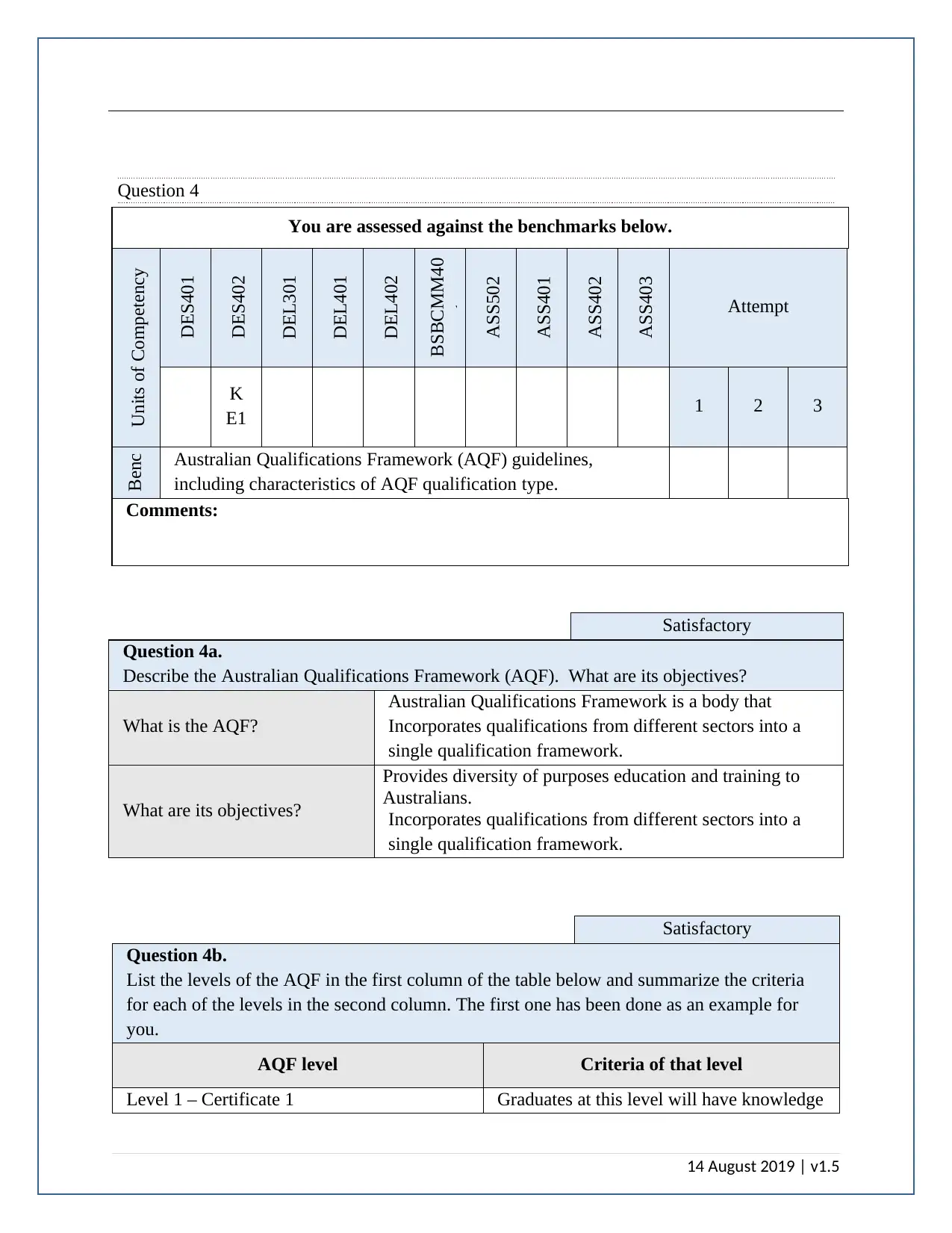
Question 4
You are assessed against the benchmarks below.
Units of Competency
DES401
DES402
DEL301
DEL401
DEL402
BSBCMM40
1
ASS502
ASS401
ASS402
ASS403
Attempt
K
E1 1 2 3
Benc
hmar Australian Qualifications Framework (AQF) guidelines,
including characteristics of AQF qualification type.
Comments:
Satisfactory
Question 4a.
Describe the Australian Qualifications Framework (AQF). What are its objectives?
What is the AQF?
Australian Qualifications Framework is a body that
Incorporates qualifications from different sectors into a
single qualification framework.
What are its objectives?
Provides diversity of purposes education and training to
Australians.
Incorporates qualifications from different sectors into a
single qualification framework.
Satisfactory
Question 4b.
List the levels of the AQF in the first column of the table below and summarize the criteria
for each of the levels in the second column. The first one has been done as an example for
you.
AQF level Criteria of that level
Level 1 – Certificate 1 Graduates at this level will have knowledge
14 August 2019 | v1.5
You are assessed against the benchmarks below.
Units of Competency
DES401
DES402
DEL301
DEL401
DEL402
BSBCMM40
1
ASS502
ASS401
ASS402
ASS403
Attempt
K
E1 1 2 3
Benc
hmar Australian Qualifications Framework (AQF) guidelines,
including characteristics of AQF qualification type.
Comments:
Satisfactory
Question 4a.
Describe the Australian Qualifications Framework (AQF). What are its objectives?
What is the AQF?
Australian Qualifications Framework is a body that
Incorporates qualifications from different sectors into a
single qualification framework.
What are its objectives?
Provides diversity of purposes education and training to
Australians.
Incorporates qualifications from different sectors into a
single qualification framework.
Satisfactory
Question 4b.
List the levels of the AQF in the first column of the table below and summarize the criteria
for each of the levels in the second column. The first one has been done as an example for
you.
AQF level Criteria of that level
Level 1 – Certificate 1 Graduates at this level will have knowledge
14 August 2019 | v1.5
Paraphrase This Document
Need a fresh take? Get an instant paraphrase of this document with our AI Paraphraser
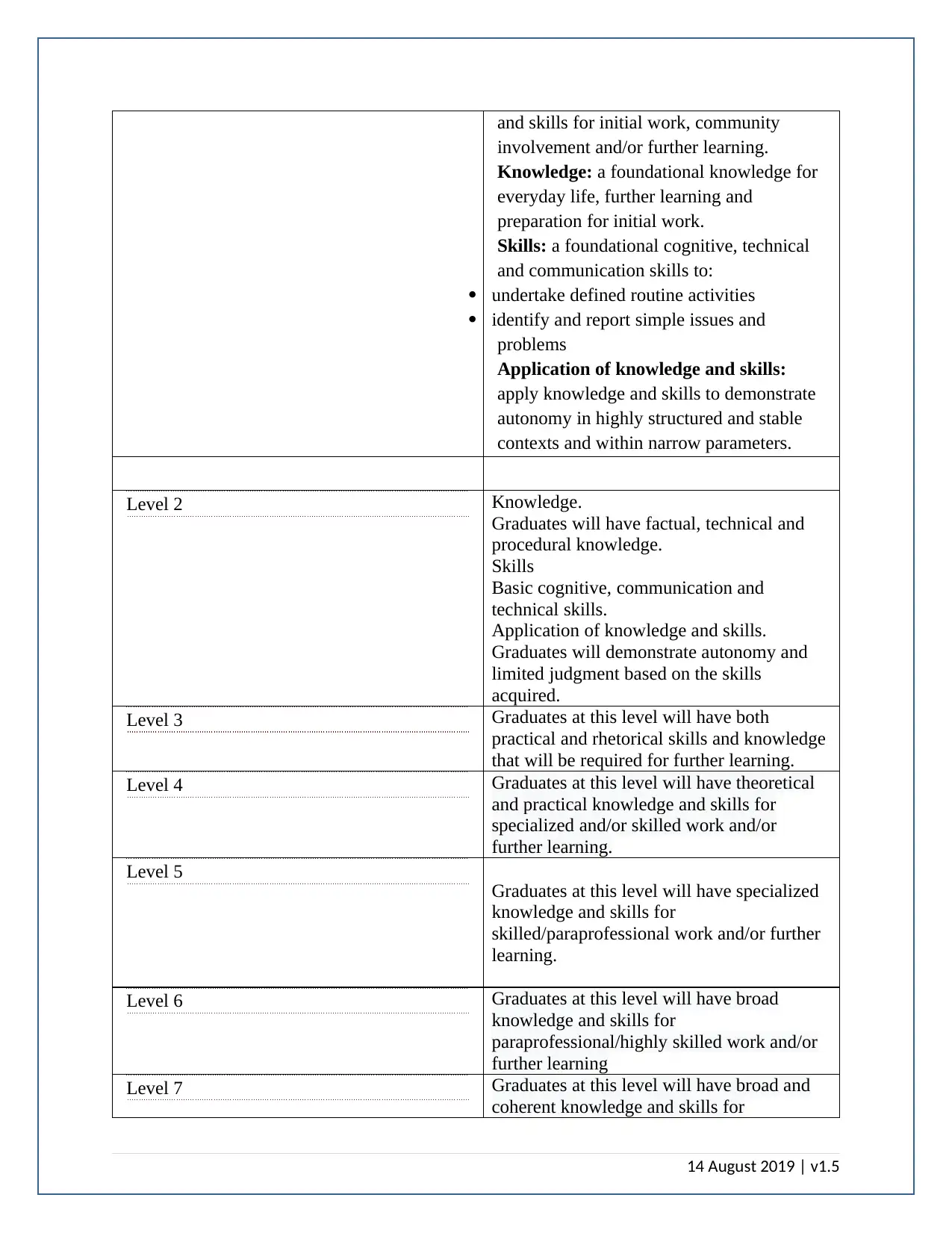
and skills for initial work, community
involvement and/or further learning.
Knowledge: a foundational knowledge for
everyday life, further learning and
preparation for initial work.
Skills: a foundational cognitive, technical
and communication skills to:
undertake defined routine activities
identify and report simple issues and
problems
Application of knowledge and skills:
apply knowledge and skills to demonstrate
autonomy in highly structured and stable
contexts and within narrow parameters.
Level 2 Knowledge.
Graduates will have factual, technical and
procedural knowledge.
Skills
Basic cognitive, communication and
technical skills.
Application of knowledge and skills.
Graduates will demonstrate autonomy and
limited judgment based on the skills
acquired.
Level 3 Graduates at this level will have both
practical and rhetorical skills and knowledge
that will be required for further learning.
Level 4 Graduates at this level will have theoretical
and practical knowledge and skills for
specialized and/or skilled work and/or
further learning.
Level 5
Graduates at this level will have specialized
knowledge and skills for
skilled/paraprofessional work and/or further
learning.
Level 6 Graduates at this level will have broad
knowledge and skills for
paraprofessional/highly skilled work and/or
further learning
Level 7 Graduates at this level will have broad and
coherent knowledge and skills for
14 August 2019 | v1.5
involvement and/or further learning.
Knowledge: a foundational knowledge for
everyday life, further learning and
preparation for initial work.
Skills: a foundational cognitive, technical
and communication skills to:
undertake defined routine activities
identify and report simple issues and
problems
Application of knowledge and skills:
apply knowledge and skills to demonstrate
autonomy in highly structured and stable
contexts and within narrow parameters.
Level 2 Knowledge.
Graduates will have factual, technical and
procedural knowledge.
Skills
Basic cognitive, communication and
technical skills.
Application of knowledge and skills.
Graduates will demonstrate autonomy and
limited judgment based on the skills
acquired.
Level 3 Graduates at this level will have both
practical and rhetorical skills and knowledge
that will be required for further learning.
Level 4 Graduates at this level will have theoretical
and practical knowledge and skills for
specialized and/or skilled work and/or
further learning.
Level 5
Graduates at this level will have specialized
knowledge and skills for
skilled/paraprofessional work and/or further
learning.
Level 6 Graduates at this level will have broad
knowledge and skills for
paraprofessional/highly skilled work and/or
further learning
Level 7 Graduates at this level will have broad and
coherent knowledge and skills for
14 August 2019 | v1.5
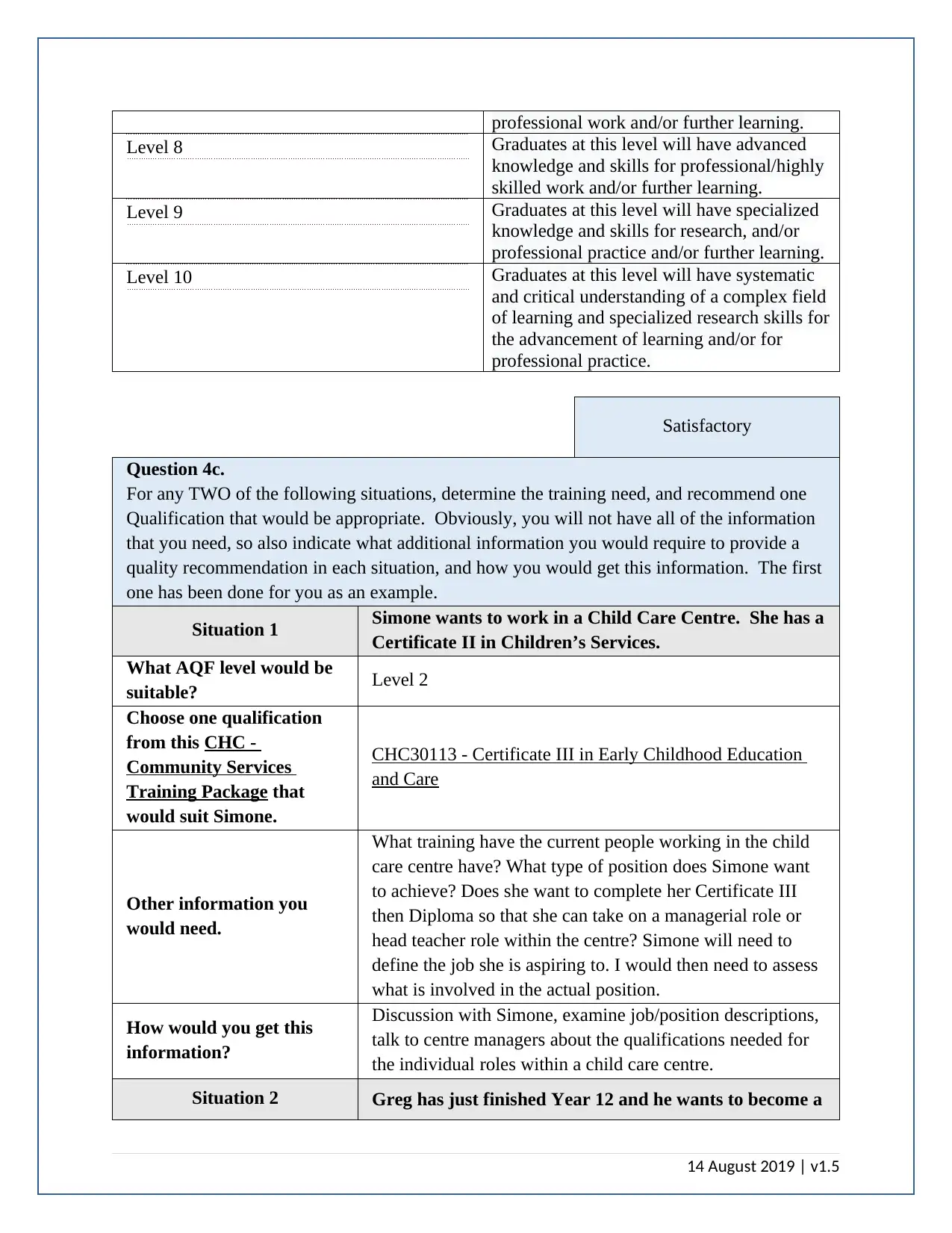
professional work and/or further learning.
Level 8 Graduates at this level will have advanced
knowledge and skills for professional/highly
skilled work and/or further learning.
Level 9 Graduates at this level will have specialized
knowledge and skills for research, and/or
professional practice and/or further learning.
Level 10 Graduates at this level will have systematic
and critical understanding of a complex field
of learning and specialized research skills for
the advancement of learning and/or for
professional practice.
Satisfactory
Question 4c.
For any TWO of the following situations, determine the training need, and recommend one
Qualification that would be appropriate. Obviously, you will not have all of the information
that you need, so also indicate what additional information you would require to provide a
quality recommendation in each situation, and how you would get this information. The first
one has been done for you as an example.
Situation 1 Simone wants to work in a Child Care Centre. She has a
Certificate II in Children’s Services.
What AQF level would be
suitable? Level 2
Choose one qualification
from this CHC -
Community Services
Training Package that
would suit Simone.
CHC30113 - Certificate III in Early Childhood Education
and Care
Other information you
would need.
What training have the current people working in the child
care centre have? What type of position does Simone want
to achieve? Does she want to complete her Certificate III
then Diploma so that she can take on a managerial role or
head teacher role within the centre? Simone will need to
define the job she is aspiring to. I would then need to assess
what is involved in the actual position.
How would you get this
information?
Discussion with Simone, examine job/position descriptions,
talk to centre managers about the qualifications needed for
the individual roles within a child care centre.
Situation 2 Greg has just finished Year 12 and he wants to become a
14 August 2019 | v1.5
Level 8 Graduates at this level will have advanced
knowledge and skills for professional/highly
skilled work and/or further learning.
Level 9 Graduates at this level will have specialized
knowledge and skills for research, and/or
professional practice and/or further learning.
Level 10 Graduates at this level will have systematic
and critical understanding of a complex field
of learning and specialized research skills for
the advancement of learning and/or for
professional practice.
Satisfactory
Question 4c.
For any TWO of the following situations, determine the training need, and recommend one
Qualification that would be appropriate. Obviously, you will not have all of the information
that you need, so also indicate what additional information you would require to provide a
quality recommendation in each situation, and how you would get this information. The first
one has been done for you as an example.
Situation 1 Simone wants to work in a Child Care Centre. She has a
Certificate II in Children’s Services.
What AQF level would be
suitable? Level 2
Choose one qualification
from this CHC -
Community Services
Training Package that
would suit Simone.
CHC30113 - Certificate III in Early Childhood Education
and Care
Other information you
would need.
What training have the current people working in the child
care centre have? What type of position does Simone want
to achieve? Does she want to complete her Certificate III
then Diploma so that she can take on a managerial role or
head teacher role within the centre? Simone will need to
define the job she is aspiring to. I would then need to assess
what is involved in the actual position.
How would you get this
information?
Discussion with Simone, examine job/position descriptions,
talk to centre managers about the qualifications needed for
the individual roles within a child care centre.
Situation 2 Greg has just finished Year 12 and he wants to become a
14 August 2019 | v1.5
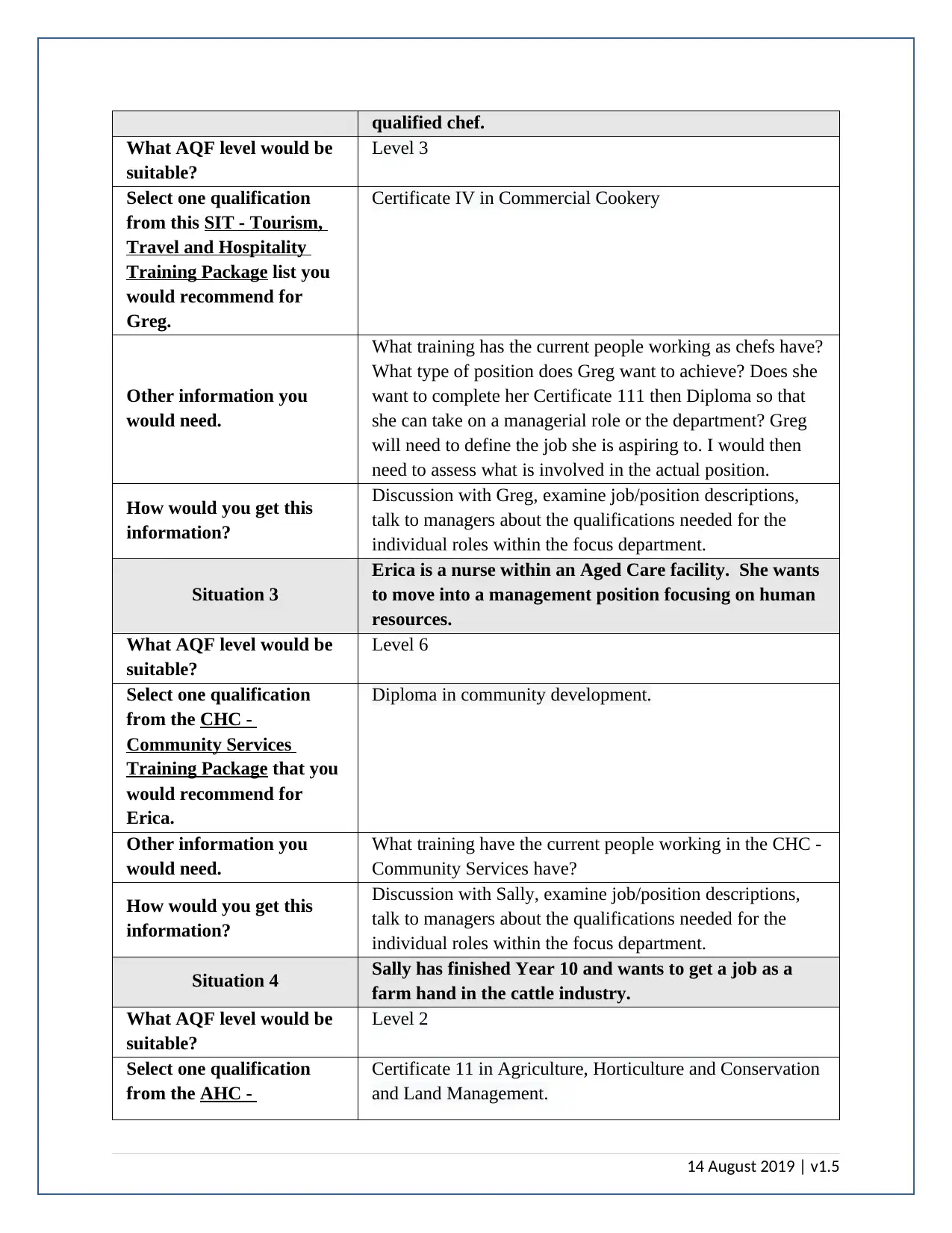
qualified chef.
What AQF level would be
suitable?
Level 3
Select one qualification
from this SIT - Tourism,
Travel and Hospitality
Training Package list you
would recommend for
Greg.
Certificate IV in Commercial Cookery
Other information you
would need.
What training has the current people working as chefs have?
What type of position does Greg want to achieve? Does she
want to complete her Certificate 111 then Diploma so that
she can take on a managerial role or the department? Greg
will need to define the job she is aspiring to. I would then
need to assess what is involved in the actual position.
How would you get this
information?
Discussion with Greg, examine job/position descriptions,
talk to managers about the qualifications needed for the
individual roles within the focus department.
Situation 3
Erica is a nurse within an Aged Care facility. She wants
to move into a management position focusing on human
resources.
What AQF level would be
suitable?
Level 6
Select one qualification
from the CHC -
Community Services
Training Package that you
would recommend for
Erica.
Diploma in community development.
Other information you
would need.
What training have the current people working in the CHC -
Community Services have?
How would you get this
information?
Discussion with Sally, examine job/position descriptions,
talk to managers about the qualifications needed for the
individual roles within the focus department.
Situation 4 Sally has finished Year 10 and wants to get a job as a
farm hand in the cattle industry.
What AQF level would be
suitable?
Level 2
Select one qualification
from the AHC -
Certificate 11 in Agriculture, Horticulture and Conservation
and Land Management.
14 August 2019 | v1.5
What AQF level would be
suitable?
Level 3
Select one qualification
from this SIT - Tourism,
Travel and Hospitality
Training Package list you
would recommend for
Greg.
Certificate IV in Commercial Cookery
Other information you
would need.
What training has the current people working as chefs have?
What type of position does Greg want to achieve? Does she
want to complete her Certificate 111 then Diploma so that
she can take on a managerial role or the department? Greg
will need to define the job she is aspiring to. I would then
need to assess what is involved in the actual position.
How would you get this
information?
Discussion with Greg, examine job/position descriptions,
talk to managers about the qualifications needed for the
individual roles within the focus department.
Situation 3
Erica is a nurse within an Aged Care facility. She wants
to move into a management position focusing on human
resources.
What AQF level would be
suitable?
Level 6
Select one qualification
from the CHC -
Community Services
Training Package that you
would recommend for
Erica.
Diploma in community development.
Other information you
would need.
What training have the current people working in the CHC -
Community Services have?
How would you get this
information?
Discussion with Sally, examine job/position descriptions,
talk to managers about the qualifications needed for the
individual roles within the focus department.
Situation 4 Sally has finished Year 10 and wants to get a job as a
farm hand in the cattle industry.
What AQF level would be
suitable?
Level 2
Select one qualification
from the AHC -
Certificate 11 in Agriculture, Horticulture and Conservation
and Land Management.
14 August 2019 | v1.5
Secure Best Marks with AI Grader
Need help grading? Try our AI Grader for instant feedback on your assignments.
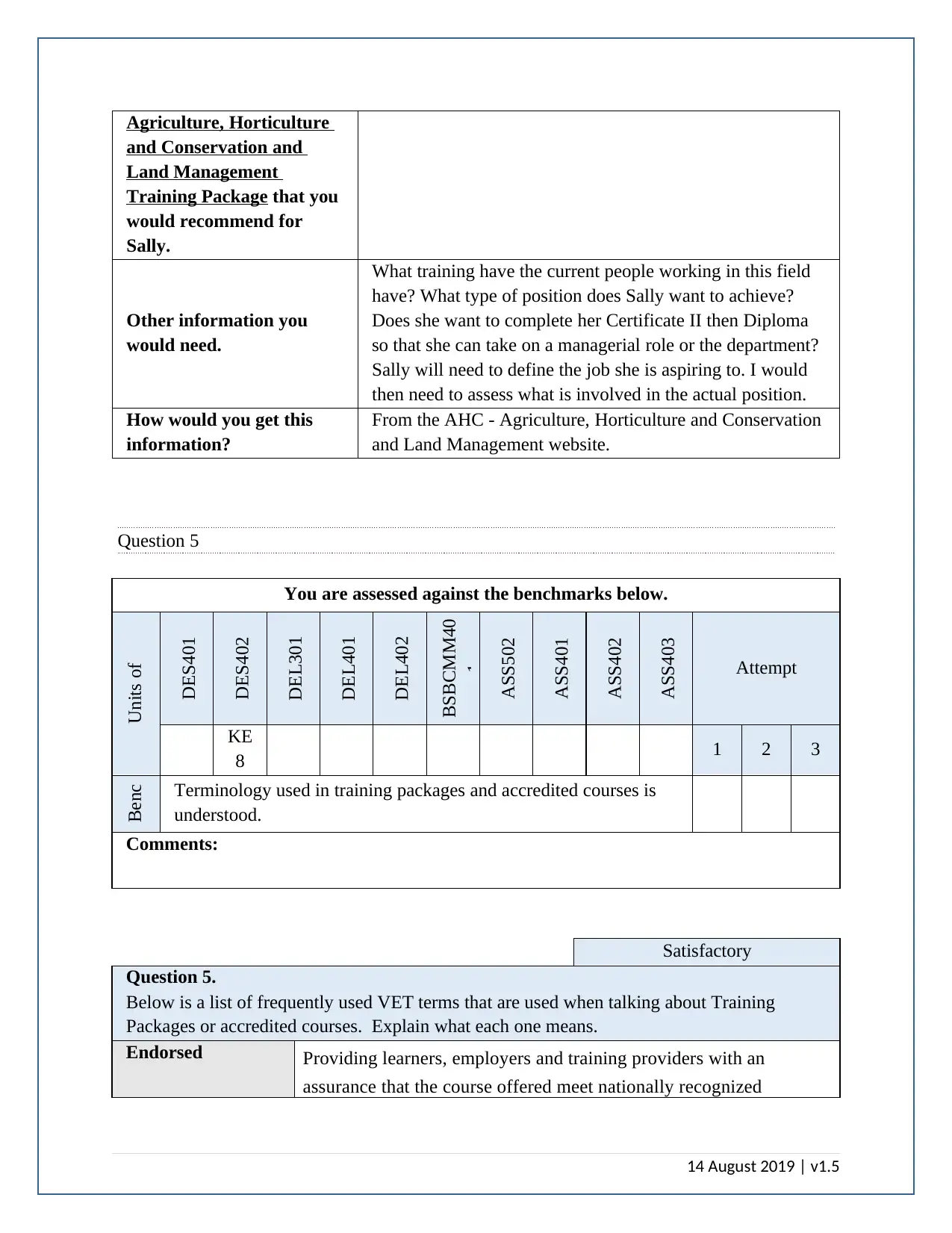
Agriculture, Horticulture
and Conservation and
Land Management
Training Package that you
would recommend for
Sally.
Other information you
would need.
What training have the current people working in this field
have? What type of position does Sally want to achieve?
Does she want to complete her Certificate II then Diploma
so that she can take on a managerial role or the department?
Sally will need to define the job she is aspiring to. I would
then need to assess what is involved in the actual position.
How would you get this
information?
From the AHC - Agriculture, Horticulture and Conservation
and Land Management website.
Question 5
You are assessed against the benchmarks below.
Units of
Competency
DES401
DES402
DEL301
DEL401
DEL402
BSBCMM40
1
ASS502
ASS401
ASS402
ASS403
Attempt
KE
8 1 2 3
Benc
hmar Terminology used in training packages and accredited courses is
understood.
Comments:
Satisfactory
Question 5.
Below is a list of frequently used VET terms that are used when talking about Training
Packages or accredited courses. Explain what each one means.
Endorsed Providing learners, employers and training providers with an
assurance that the course offered meet nationally recognized
14 August 2019 | v1.5
and Conservation and
Land Management
Training Package that you
would recommend for
Sally.
Other information you
would need.
What training have the current people working in this field
have? What type of position does Sally want to achieve?
Does she want to complete her Certificate II then Diploma
so that she can take on a managerial role or the department?
Sally will need to define the job she is aspiring to. I would
then need to assess what is involved in the actual position.
How would you get this
information?
From the AHC - Agriculture, Horticulture and Conservation
and Land Management website.
Question 5
You are assessed against the benchmarks below.
Units of
Competency
DES401
DES402
DEL301
DEL401
DEL402
BSBCMM40
1
ASS502
ASS401
ASS402
ASS403
Attempt
KE
8 1 2 3
Benc
hmar Terminology used in training packages and accredited courses is
understood.
Comments:
Satisfactory
Question 5.
Below is a list of frequently used VET terms that are used when talking about Training
Packages or accredited courses. Explain what each one means.
Endorsed Providing learners, employers and training providers with an
assurance that the course offered meet nationally recognized
14 August 2019 | v1.5
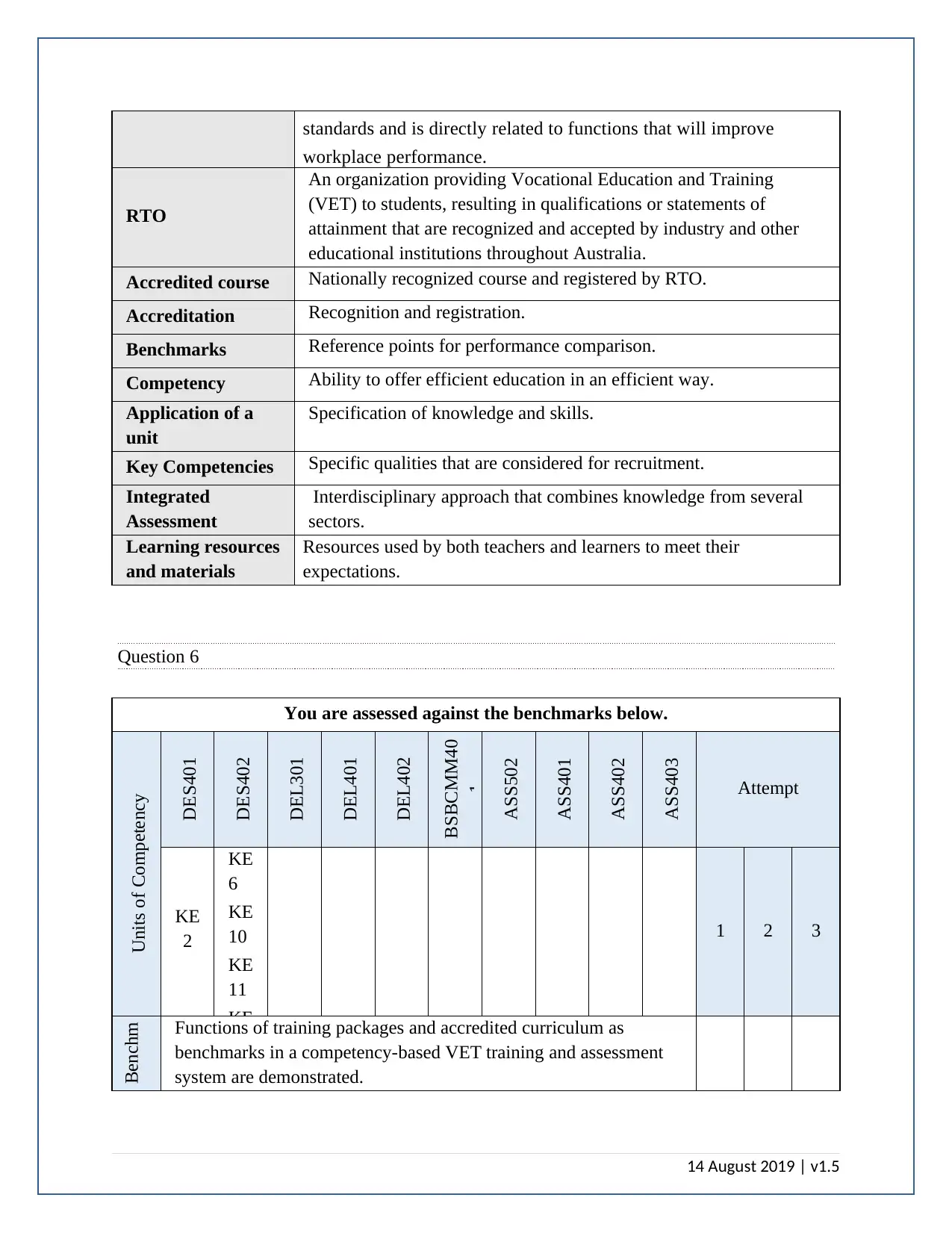
standards and is directly related to functions that will improve
workplace performance.
RTO
An organization providing Vocational Education and Training
(VET) to students, resulting in qualifications or statements of
attainment that are recognized and accepted by industry and other
educational institutions throughout Australia.
Accredited course Nationally recognized course and registered by RTO.
Accreditation Recognition and registration.
Benchmarks Reference points for performance comparison.
Competency Ability to offer efficient education in an efficient way.
Application of a
unit
Specification of knowledge and skills.
Key Competencies Specific qualities that are considered for recruitment.
Integrated
Assessment
Interdisciplinary approach that combines knowledge from several
sectors.
Learning resources
and materials
Resources used by both teachers and learners to meet their
expectations.
Question 6
You are assessed against the benchmarks below.
Units of Competency
DES401
DES402
DEL301
DEL401
DEL402
BSBCMM40
1
ASS502
ASS401
ASS402
ASS403
Attempt
KE
2
KE
6
KE
10
KE
11
KE
1 2 3
Benchm Functions of training packages and accredited curriculum as
benchmarks in a competency-based VET training and assessment
system are demonstrated.
14 August 2019 | v1.5
workplace performance.
RTO
An organization providing Vocational Education and Training
(VET) to students, resulting in qualifications or statements of
attainment that are recognized and accepted by industry and other
educational institutions throughout Australia.
Accredited course Nationally recognized course and registered by RTO.
Accreditation Recognition and registration.
Benchmarks Reference points for performance comparison.
Competency Ability to offer efficient education in an efficient way.
Application of a
unit
Specification of knowledge and skills.
Key Competencies Specific qualities that are considered for recruitment.
Integrated
Assessment
Interdisciplinary approach that combines knowledge from several
sectors.
Learning resources
and materials
Resources used by both teachers and learners to meet their
expectations.
Question 6
You are assessed against the benchmarks below.
Units of Competency
DES401
DES402
DEL301
DEL401
DEL402
BSBCMM40
1
ASS502
ASS401
ASS402
ASS403
Attempt
KE
2
KE
6
KE
10
KE
11
KE
1 2 3
Benchm Functions of training packages and accredited curriculum as
benchmarks in a competency-based VET training and assessment
system are demonstrated.
14 August 2019 | v1.5
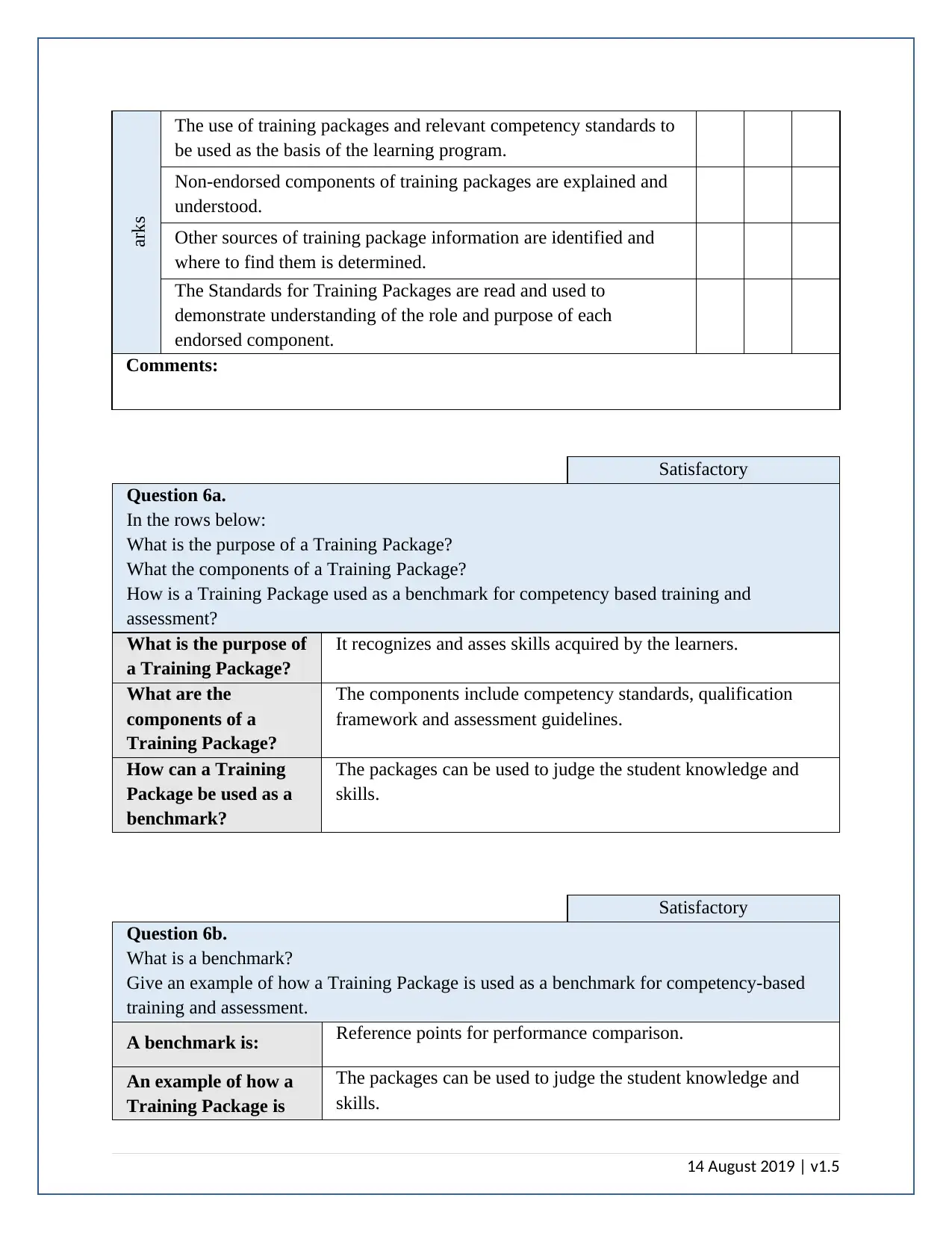
arks
The use of training packages and relevant competency standards to
be used as the basis of the learning program.
Non-endorsed components of training packages are explained and
understood.
Other sources of training package information are identified and
where to find them is determined.
The Standards for Training Packages are read and used to
demonstrate understanding of the role and purpose of each
endorsed component.
Comments:
Satisfactory
Question 6a.
In the rows below:
What is the purpose of a Training Package?
What the components of a Training Package?
How is a Training Package used as a benchmark for competency based training and
assessment?
What is the purpose of
a Training Package?
It recognizes and asses skills acquired by the learners.
What are the
components of a
Training Package?
The components include competency standards, qualification
framework and assessment guidelines.
How can a Training
Package be used as a
benchmark?
The packages can be used to judge the student knowledge and
skills.
Satisfactory
Question 6b.
What is a benchmark?
Give an example of how a Training Package is used as a benchmark for competency-based
training and assessment.
A benchmark is: Reference points for performance comparison.
An example of how a
Training Package is
The packages can be used to judge the student knowledge and
skills.
14 August 2019 | v1.5
The use of training packages and relevant competency standards to
be used as the basis of the learning program.
Non-endorsed components of training packages are explained and
understood.
Other sources of training package information are identified and
where to find them is determined.
The Standards for Training Packages are read and used to
demonstrate understanding of the role and purpose of each
endorsed component.
Comments:
Satisfactory
Question 6a.
In the rows below:
What is the purpose of a Training Package?
What the components of a Training Package?
How is a Training Package used as a benchmark for competency based training and
assessment?
What is the purpose of
a Training Package?
It recognizes and asses skills acquired by the learners.
What are the
components of a
Training Package?
The components include competency standards, qualification
framework and assessment guidelines.
How can a Training
Package be used as a
benchmark?
The packages can be used to judge the student knowledge and
skills.
Satisfactory
Question 6b.
What is a benchmark?
Give an example of how a Training Package is used as a benchmark for competency-based
training and assessment.
A benchmark is: Reference points for performance comparison.
An example of how a
Training Package is
The packages can be used to judge the student knowledge and
skills.
14 August 2019 | v1.5
Paraphrase This Document
Need a fresh take? Get an instant paraphrase of this document with our AI Paraphraser
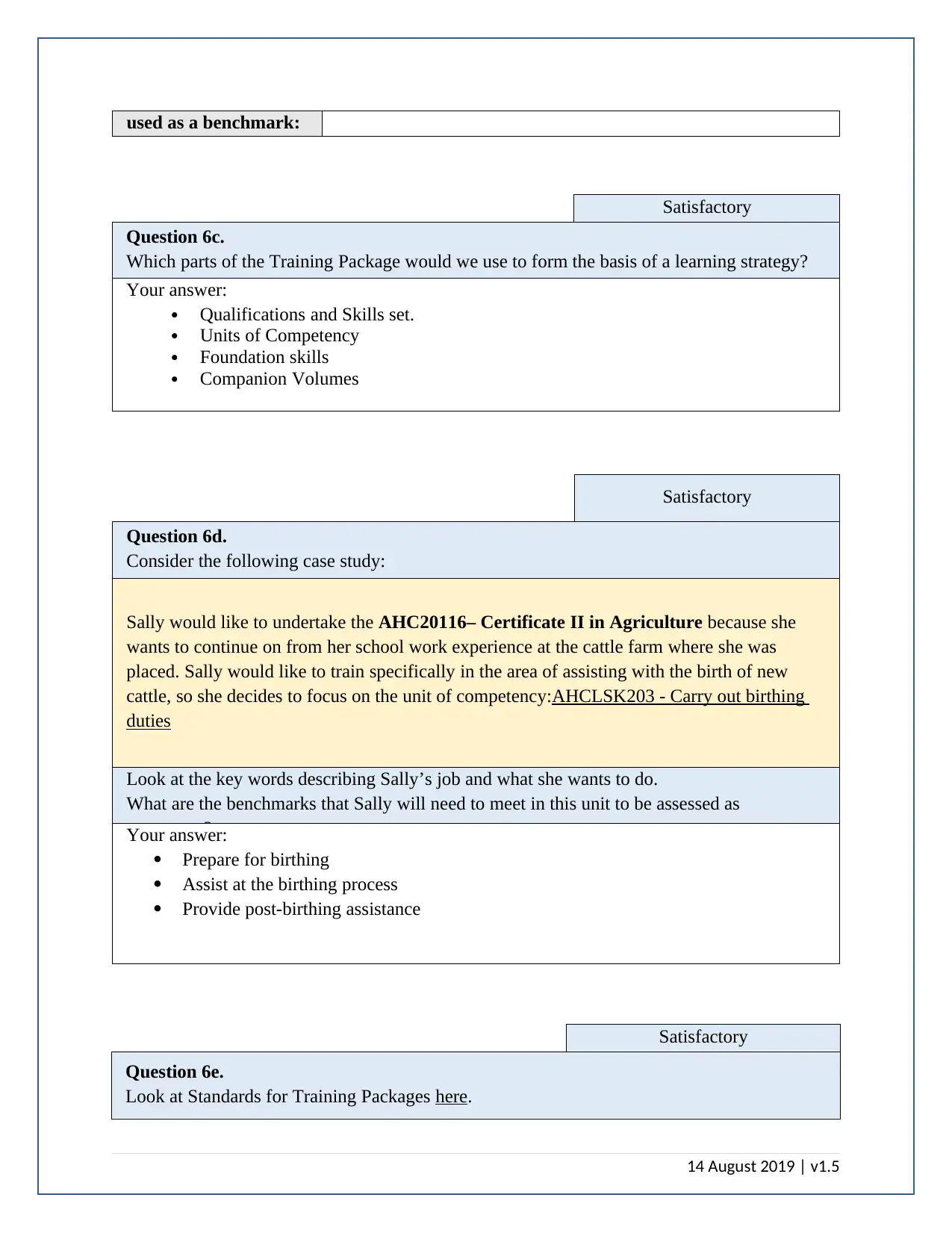
used as a benchmark:
Satisfactory
Question 6c.
Which parts of the Training Package would we use to form the basis of a learning strategy?
Your answer:
Qualifications and Skills set.
Units of Competency
Foundation skills
Companion Volumes
Satisfactory
Question 6d.
Consider the following case study:
Sally would like to undertake the AHC20116– Certificate II in Agriculture because she
wants to continue on from her school work experience at the cattle farm where she was
placed. Sally would like to train specifically in the area of assisting with the birth of new
cattle, so she decides to focus on the unit of competency:AHCLSK203 - Carry out birthing
duties
Look at the key words describing Sally’s job and what she wants to do.
What are the benchmarks that Sally will need to meet in this unit to be assessed as
competent?Your answer:
Prepare for birthing
Assist at the birthing process
Provide post-birthing assistance
Satisfactory
Question 6e.
Look at Standards for Training Packages here.
14 August 2019 | v1.5
Satisfactory
Question 6c.
Which parts of the Training Package would we use to form the basis of a learning strategy?
Your answer:
Qualifications and Skills set.
Units of Competency
Foundation skills
Companion Volumes
Satisfactory
Question 6d.
Consider the following case study:
Sally would like to undertake the AHC20116– Certificate II in Agriculture because she
wants to continue on from her school work experience at the cattle farm where she was
placed. Sally would like to train specifically in the area of assisting with the birth of new
cattle, so she decides to focus on the unit of competency:AHCLSK203 - Carry out birthing
duties
Look at the key words describing Sally’s job and what she wants to do.
What are the benchmarks that Sally will need to meet in this unit to be assessed as
competent?Your answer:
Prepare for birthing
Assist at the birthing process
Provide post-birthing assistance
Satisfactory
Question 6e.
Look at Standards for Training Packages here.
14 August 2019 | v1.5
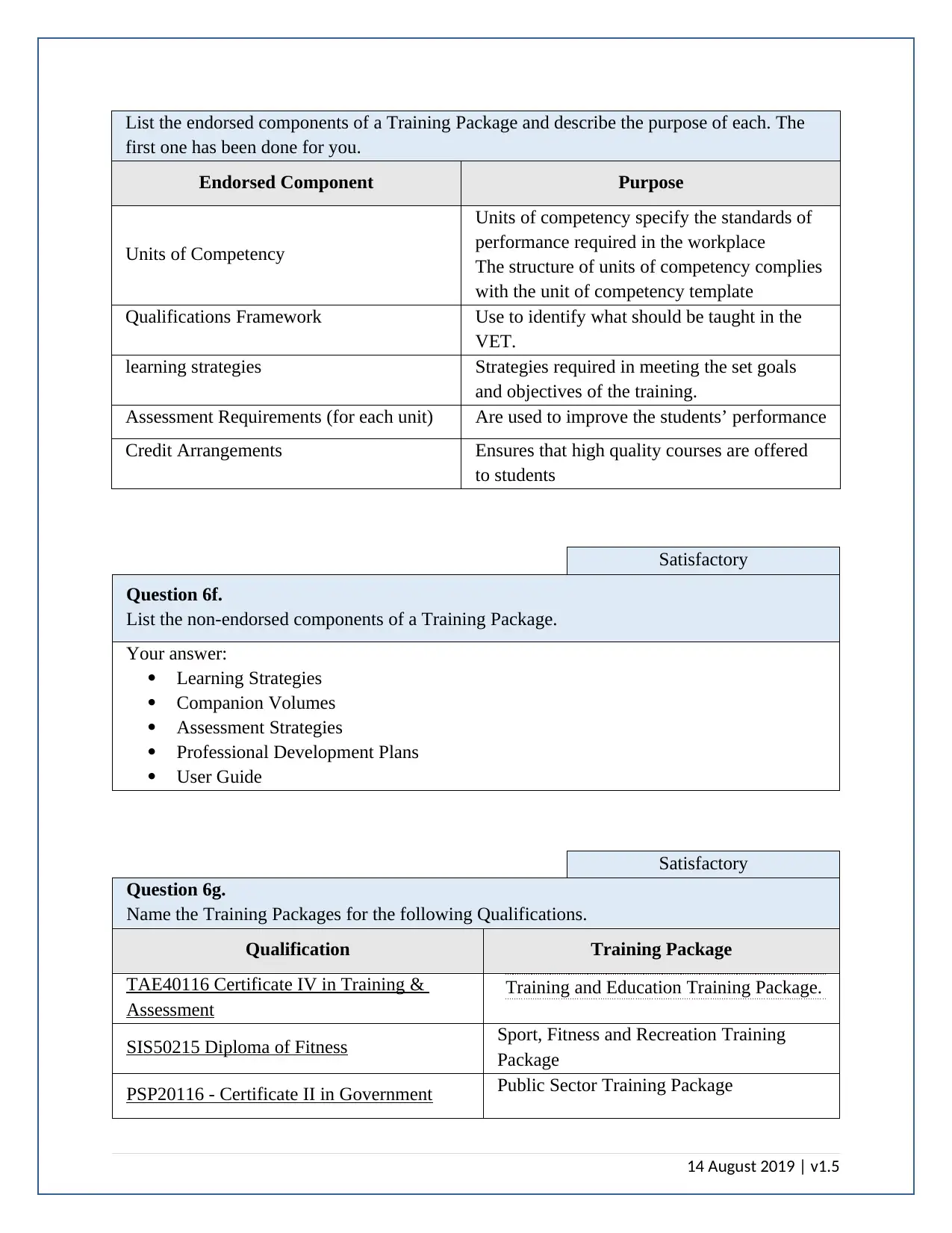
List the endorsed components of a Training Package and describe the purpose of each. The
first one has been done for you.
Endorsed Component Purpose
Units of Competency
Units of competency specify the standards of
performance required in the workplace
The structure of units of competency complies
with the unit of competency template
Qualifications Framework Use to identify what should be taught in the
VET.
learning strategies Strategies required in meeting the set goals
and objectives of the training.
Assessment Requirements (for each unit) Are used to improve the students’ performance
Credit Arrangements Ensures that high quality courses are offered
to students
Satisfactory
Question 6f.
List the non-endorsed components of a Training Package.
Your answer:
Learning Strategies
Companion Volumes
Assessment Strategies
Professional Development Plans
User Guide
Satisfactory
Question 6g.
Name the Training Packages for the following Qualifications.
Qualification Training Package
TAE40116 Certificate IV in Training &
Assessment
Training and Education Training Package.
SIS50215 Diploma of Fitness Sport, Fitness and Recreation Training
Package
PSP20116 - Certificate II in Government Public Sector Training Package
14 August 2019 | v1.5
first one has been done for you.
Endorsed Component Purpose
Units of Competency
Units of competency specify the standards of
performance required in the workplace
The structure of units of competency complies
with the unit of competency template
Qualifications Framework Use to identify what should be taught in the
VET.
learning strategies Strategies required in meeting the set goals
and objectives of the training.
Assessment Requirements (for each unit) Are used to improve the students’ performance
Credit Arrangements Ensures that high quality courses are offered
to students
Satisfactory
Question 6f.
List the non-endorsed components of a Training Package.
Your answer:
Learning Strategies
Companion Volumes
Assessment Strategies
Professional Development Plans
User Guide
Satisfactory
Question 6g.
Name the Training Packages for the following Qualifications.
Qualification Training Package
TAE40116 Certificate IV in Training &
Assessment
Training and Education Training Package.
SIS50215 Diploma of Fitness Sport, Fitness and Recreation Training
Package
PSP20116 - Certificate II in Government Public Sector Training Package
14 August 2019 | v1.5
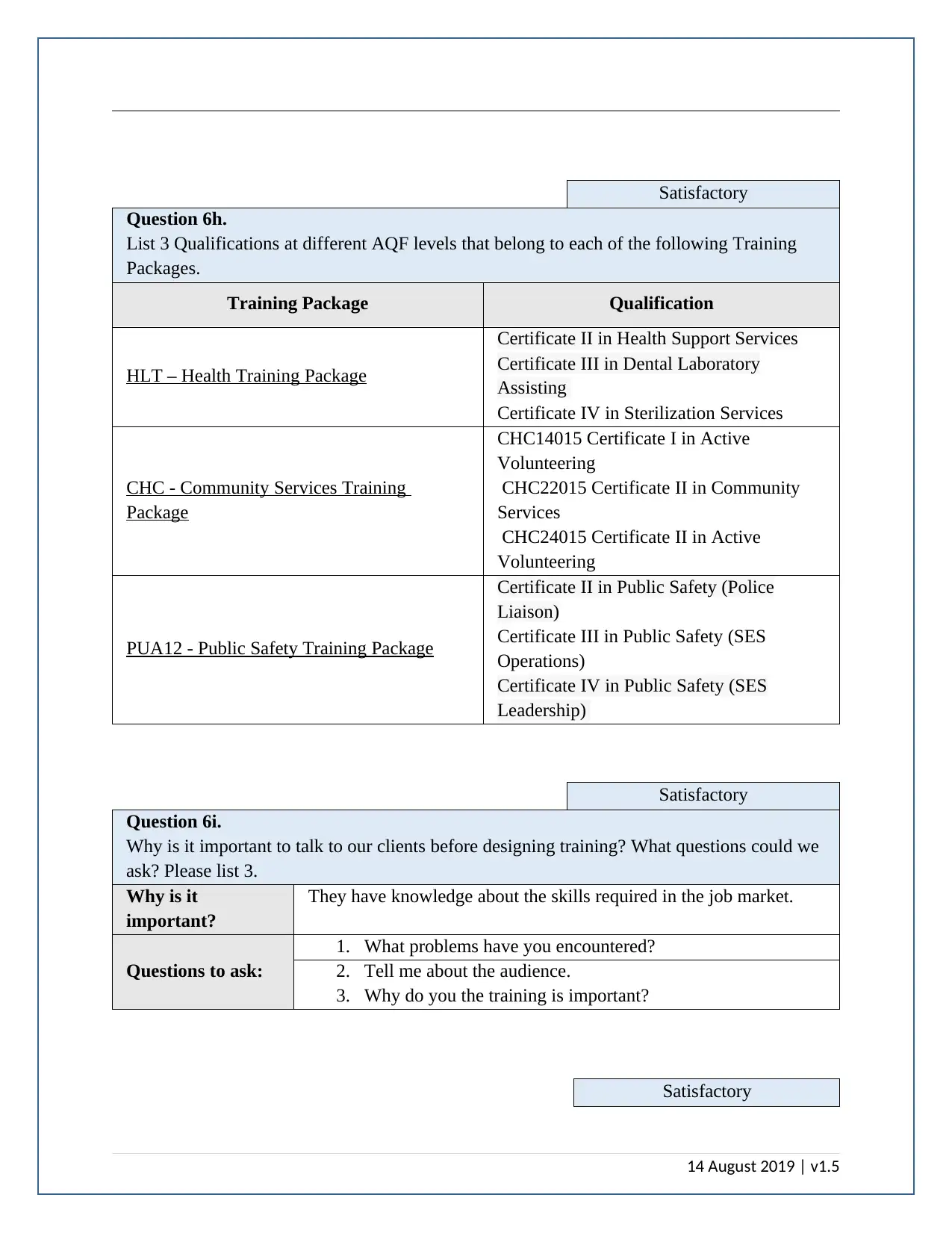
Satisfactory
Question 6h.
List 3 Qualifications at different AQF levels that belong to each of the following Training
Packages.
Training Package Qualification
HLT – Health Training Package
Certificate II in Health Support Services
Certificate III in Dental Laboratory
Assisting
Certificate IV in Sterilization Services
CHC - Community Services Training
Package
CHC14015 Certificate I in Active
Volunteering
CHC22015 Certificate II in Community
Services
CHC24015 Certificate II in Active
Volunteering
PUA12 - Public Safety Training Package
Certificate II in Public Safety (Police
Liaison)
Certificate III in Public Safety (SES
Operations)
Certificate IV in Public Safety (SES
Leadership)
Satisfactory
Question 6i.
Why is it important to talk to our clients before designing training? What questions could we
ask? Please list 3.
Why is it
important?
They have knowledge about the skills required in the job market.
Questions to ask:
1. What problems have you encountered?
2. Tell me about the audience.
3. Why do you the training is important?
Satisfactory
14 August 2019 | v1.5
Question 6h.
List 3 Qualifications at different AQF levels that belong to each of the following Training
Packages.
Training Package Qualification
HLT – Health Training Package
Certificate II in Health Support Services
Certificate III in Dental Laboratory
Assisting
Certificate IV in Sterilization Services
CHC - Community Services Training
Package
CHC14015 Certificate I in Active
Volunteering
CHC22015 Certificate II in Community
Services
CHC24015 Certificate II in Active
Volunteering
PUA12 - Public Safety Training Package
Certificate II in Public Safety (Police
Liaison)
Certificate III in Public Safety (SES
Operations)
Certificate IV in Public Safety (SES
Leadership)
Satisfactory
Question 6i.
Why is it important to talk to our clients before designing training? What questions could we
ask? Please list 3.
Why is it
important?
They have knowledge about the skills required in the job market.
Questions to ask:
1. What problems have you encountered?
2. Tell me about the audience.
3. Why do you the training is important?
Satisfactory
14 August 2019 | v1.5
Secure Best Marks with AI Grader
Need help grading? Try our AI Grader for instant feedback on your assignments.
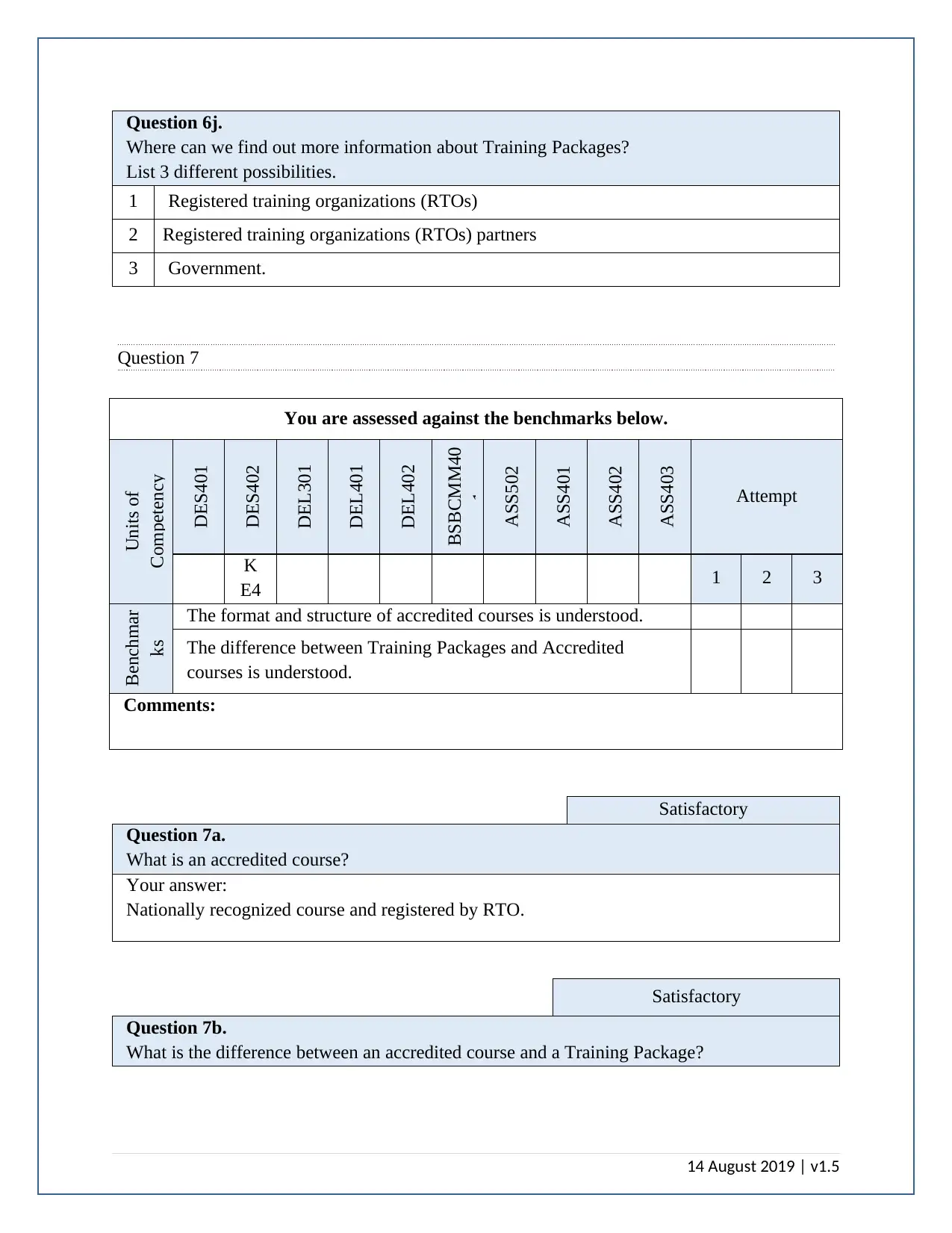
Question 6j.
Where can we find out more information about Training Packages?
List 3 different possibilities.
1 Registered training organizations (RTOs)
2 Registered training organizations (RTOs) partners
3 Government.
Question 7
You are assessed against the benchmarks below.
Units of
Competency
DES401
DES402
DEL301
DEL401
DEL402
BSBCMM40
1
ASS502
ASS401
ASS402
ASS403
Attempt
K
E4 1 2 3
Benchmar
ks
The format and structure of accredited courses is understood.
The difference between Training Packages and Accredited
courses is understood.
Comments:
Satisfactory
Question 7a.
What is an accredited course?
Your answer:
Nationally recognized course and registered by RTO.
Satisfactory
Question 7b.
What is the difference between an accredited course and a Training Package?
14 August 2019 | v1.5
Where can we find out more information about Training Packages?
List 3 different possibilities.
1 Registered training organizations (RTOs)
2 Registered training organizations (RTOs) partners
3 Government.
Question 7
You are assessed against the benchmarks below.
Units of
Competency
DES401
DES402
DEL301
DEL401
DEL402
BSBCMM40
1
ASS502
ASS401
ASS402
ASS403
Attempt
K
E4 1 2 3
Benchmar
ks
The format and structure of accredited courses is understood.
The difference between Training Packages and Accredited
courses is understood.
Comments:
Satisfactory
Question 7a.
What is an accredited course?
Your answer:
Nationally recognized course and registered by RTO.
Satisfactory
Question 7b.
What is the difference between an accredited course and a Training Package?
14 August 2019 | v1.5
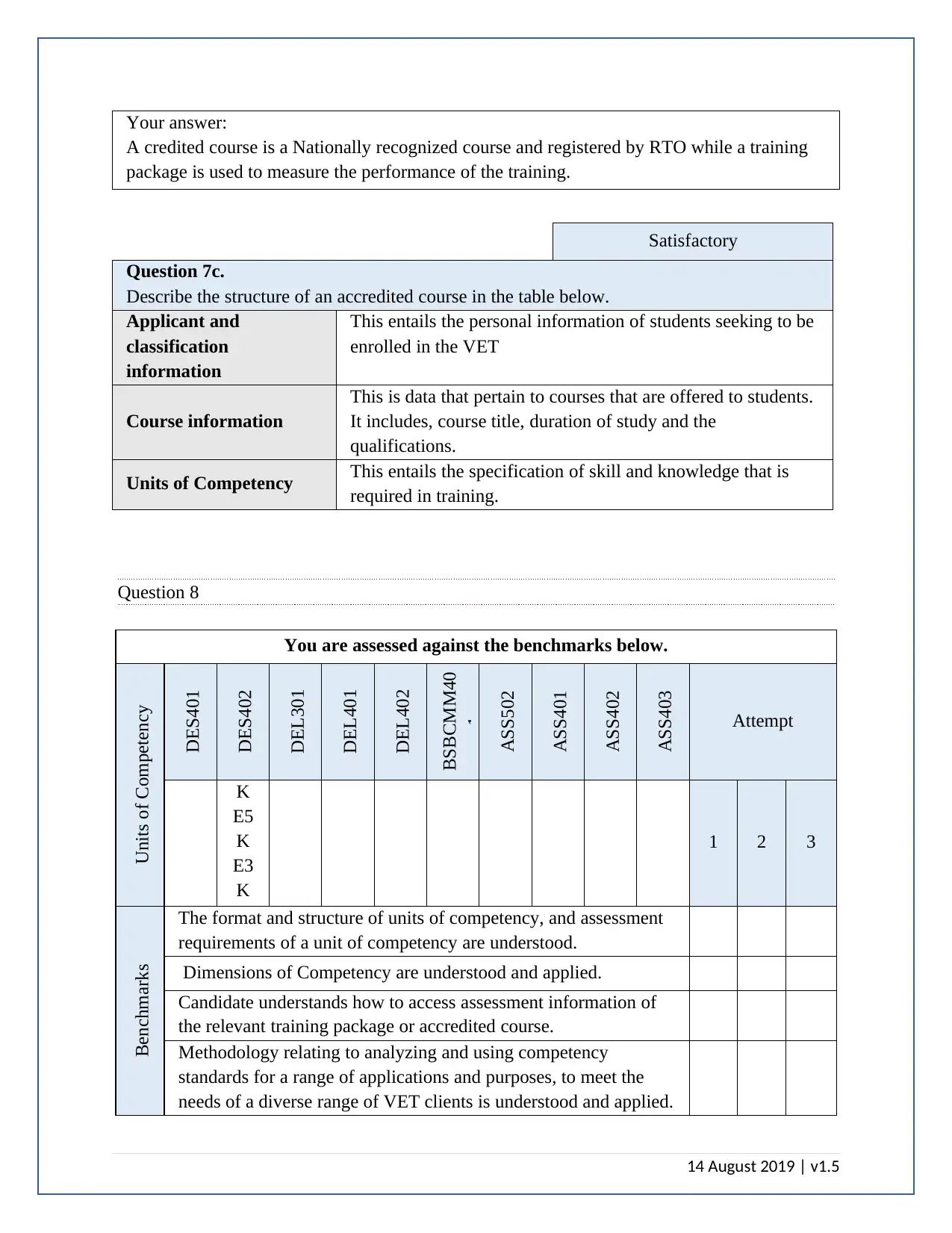
Your answer:
A credited course is a Nationally recognized course and registered by RTO while a training
package is used to measure the performance of the training.
Satisfactory
Question 7c.
Describe the structure of an accredited course in the table below.
Applicant and
classification
information
This entails the personal information of students seeking to be
enrolled in the VET
Course information
This is data that pertain to courses that are offered to students.
It includes, course title, duration of study and the
qualifications.
Units of Competency This entails the specification of skill and knowledge that is
required in training.
Question 8
You are assessed against the benchmarks below.
Units of Competency
DES401
DES402
DEL301
DEL401
DEL402
BSBCMM40
1
ASS502
ASS401
ASS402
ASS403
Attempt
K
E5
K
E3
K
E7
1 2 3
Benchmarks
The format and structure of units of competency, and assessment
requirements of a unit of competency are understood.
Dimensions of Competency are understood and applied.
Candidate understands how to access assessment information of
the relevant training package or accredited course.
Methodology relating to analyzing and using competency
standards for a range of applications and purposes, to meet the
needs of a diverse range of VET clients is understood and applied.
14 August 2019 | v1.5
A credited course is a Nationally recognized course and registered by RTO while a training
package is used to measure the performance of the training.
Satisfactory
Question 7c.
Describe the structure of an accredited course in the table below.
Applicant and
classification
information
This entails the personal information of students seeking to be
enrolled in the VET
Course information
This is data that pertain to courses that are offered to students.
It includes, course title, duration of study and the
qualifications.
Units of Competency This entails the specification of skill and knowledge that is
required in training.
Question 8
You are assessed against the benchmarks below.
Units of Competency
DES401
DES402
DEL301
DEL401
DEL402
BSBCMM40
1
ASS502
ASS401
ASS402
ASS403
Attempt
K
E5
K
E3
K
E7
1 2 3
Benchmarks
The format and structure of units of competency, and assessment
requirements of a unit of competency are understood.
Dimensions of Competency are understood and applied.
Candidate understands how to access assessment information of
the relevant training package or accredited course.
Methodology relating to analyzing and using competency
standards for a range of applications and purposes, to meet the
needs of a diverse range of VET clients is understood and applied.
14 August 2019 | v1.5
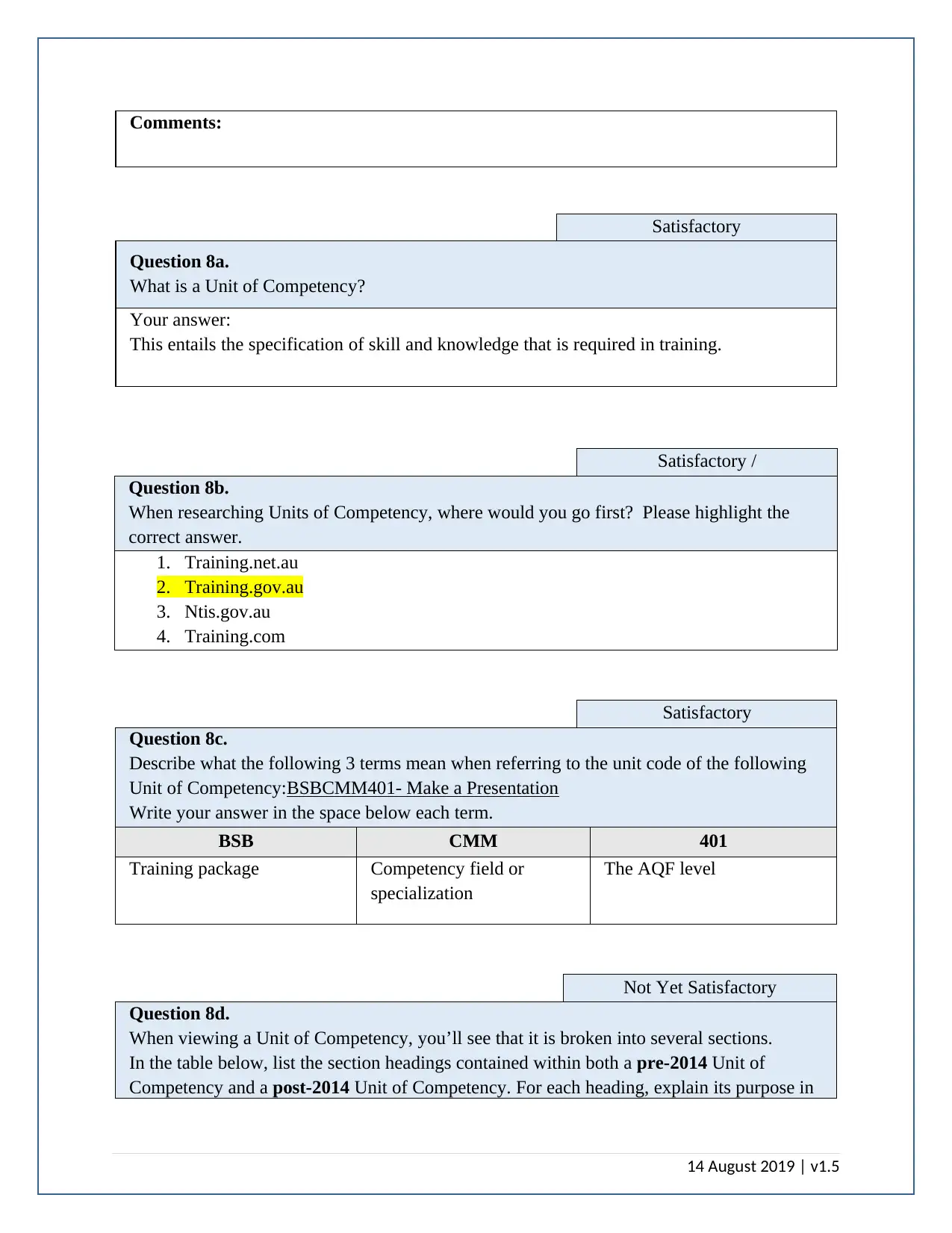
Comments:
Satisfactory
Question 8a.
What is a Unit of Competency?
Your answer:
This entails the specification of skill and knowledge that is required in training.
Satisfactory /
Question 8b.
When researching Units of Competency, where would you go first? Please highlight the
correct answer.
1. Training.net.au
2. Training.gov.au
3. Ntis.gov.au
4. Training.com
Satisfactory
Question 8c.
Describe what the following 3 terms mean when referring to the unit code of the following
Unit of Competency:BSBCMM401- Make a Presentation
Write your answer in the space below each term.
BSB CMM 401
Training package Competency field or
specialization
The AQF level
Not Yet Satisfactory
Question 8d.
When viewing a Unit of Competency, you’ll see that it is broken into several sections.
In the table below, list the section headings contained within both a pre-2014 Unit of
Competency and a post-2014 Unit of Competency. For each heading, explain its purpose in
14 August 2019 | v1.5
Satisfactory
Question 8a.
What is a Unit of Competency?
Your answer:
This entails the specification of skill and knowledge that is required in training.
Satisfactory /
Question 8b.
When researching Units of Competency, where would you go first? Please highlight the
correct answer.
1. Training.net.au
2. Training.gov.au
3. Ntis.gov.au
4. Training.com
Satisfactory
Question 8c.
Describe what the following 3 terms mean when referring to the unit code of the following
Unit of Competency:BSBCMM401- Make a Presentation
Write your answer in the space below each term.
BSB CMM 401
Training package Competency field or
specialization
The AQF level
Not Yet Satisfactory
Question 8d.
When viewing a Unit of Competency, you’ll see that it is broken into several sections.
In the table below, list the section headings contained within both a pre-2014 Unit of
Competency and a post-2014 Unit of Competency. For each heading, explain its purpose in
14 August 2019 | v1.5
Paraphrase This Document
Need a fresh take? Get an instant paraphrase of this document with our AI Paraphraser
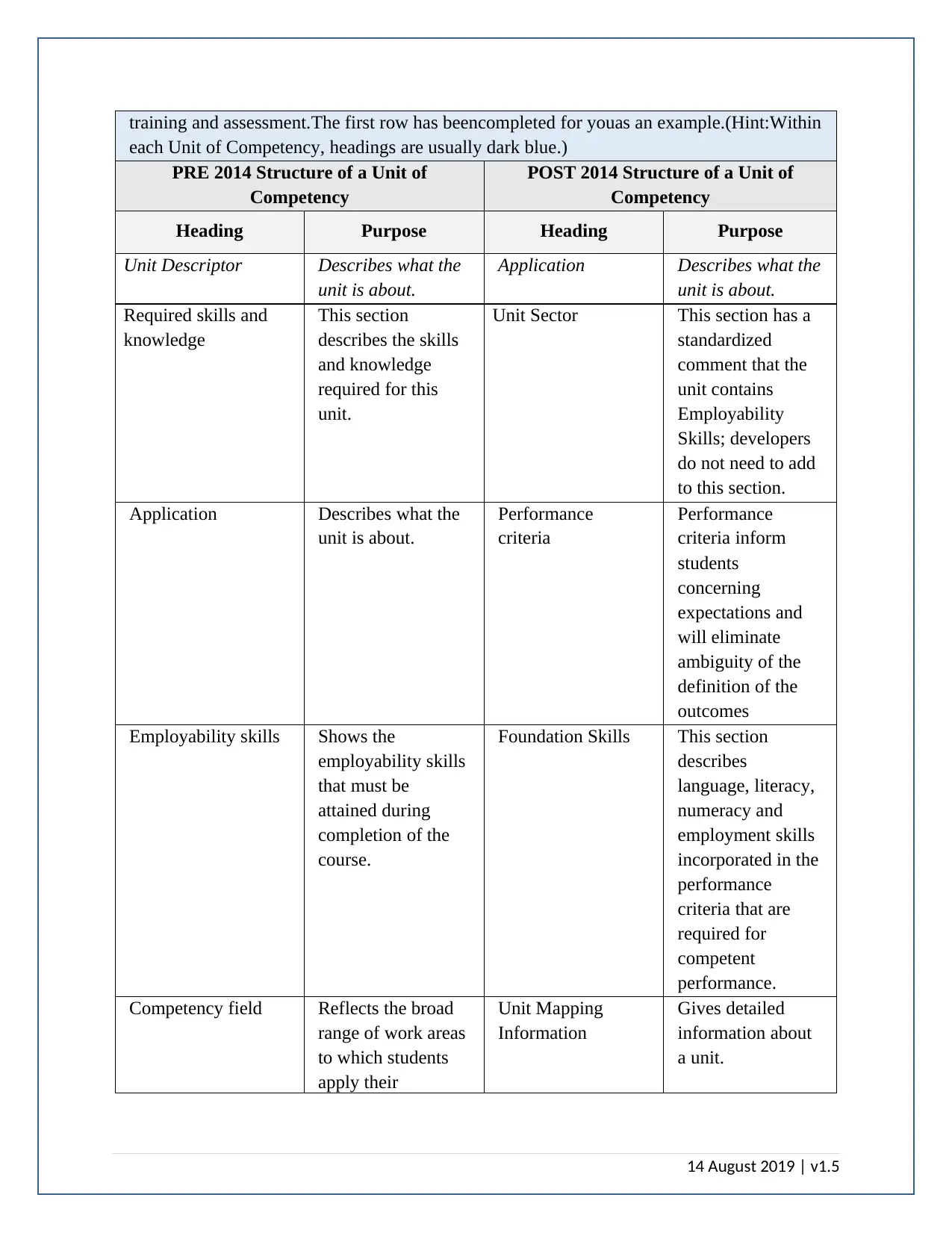
training and assessment.The first row has beencompleted for youas an example.(Hint:Within
each Unit of Competency, headings are usually dark blue.)
PRE 2014 Structure of a Unit of
Competency
POST 2014 Structure of a Unit of
Competency
Heading Purpose Heading Purpose
Unit Descriptor Describes what the
unit is about.
Application Describes what the
unit is about.
Required skills and
knowledge
This section
describes the skills
and knowledge
required for this
unit.
Unit Sector This section has a
standardized
comment that the
unit contains
Employability
Skills; developers
do not need to add
to this section.
Application Describes what the
unit is about.
Performance
criteria
Performance
criteria inform
students
concerning
expectations and
will eliminate
ambiguity of the
definition of the
outcomes
Employability skills Shows the
employability skills
that must be
attained during
completion of the
course.
Foundation Skills This section
describes
language, literacy,
numeracy and
employment skills
incorporated in the
performance
criteria that are
required for
competent
performance.
Competency field Reflects the broad
range of work areas
to which students
apply their
Unit Mapping
Information
Gives detailed
information about
a unit.
14 August 2019 | v1.5
each Unit of Competency, headings are usually dark blue.)
PRE 2014 Structure of a Unit of
Competency
POST 2014 Structure of a Unit of
Competency
Heading Purpose Heading Purpose
Unit Descriptor Describes what the
unit is about.
Application Describes what the
unit is about.
Required skills and
knowledge
This section
describes the skills
and knowledge
required for this
unit.
Unit Sector This section has a
standardized
comment that the
unit contains
Employability
Skills; developers
do not need to add
to this section.
Application Describes what the
unit is about.
Performance
criteria
Performance
criteria inform
students
concerning
expectations and
will eliminate
ambiguity of the
definition of the
outcomes
Employability skills Shows the
employability skills
that must be
attained during
completion of the
course.
Foundation Skills This section
describes
language, literacy,
numeracy and
employment skills
incorporated in the
performance
criteria that are
required for
competent
performance.
Competency field Reflects the broad
range of work areas
to which students
apply their
Unit Mapping
Information
Gives detailed
information about
a unit.
14 August 2019 | v1.5
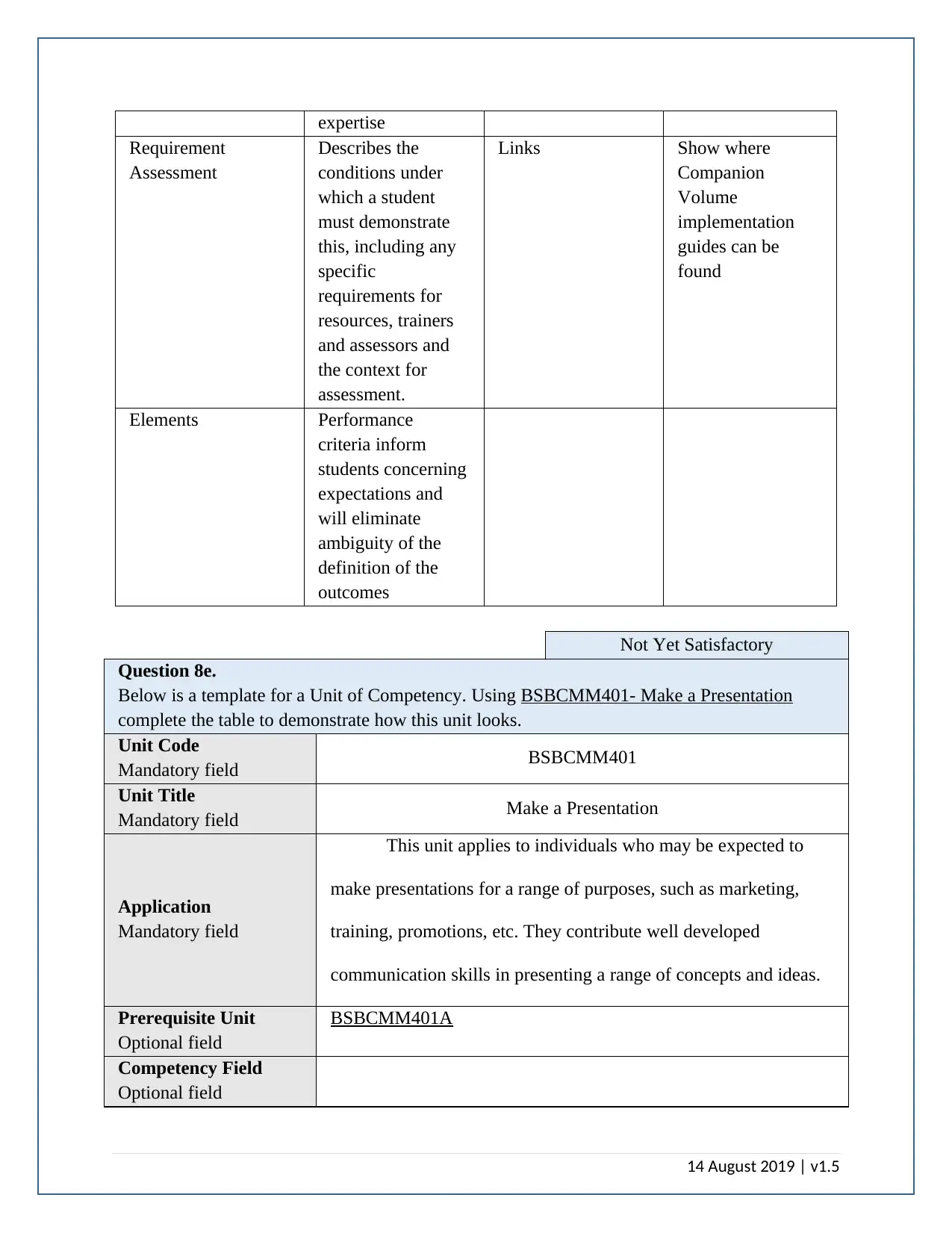
expertise
Requirement
Assessment
Describes the
conditions under
which a student
must demonstrate
this, including any
specific
requirements for
resources, trainers
and assessors and
the context for
assessment.
Links Show where
Companion
Volume
implementation
guides can be
found
Elements Performance
criteria inform
students concerning
expectations and
will eliminate
ambiguity of the
definition of the
outcomes
Not Yet Satisfactory
Question 8e.
Below is a template for a Unit of Competency. Using BSBCMM401- Make a Presentation
complete the table to demonstrate how this unit looks.
Unit Code
Mandatory field BSBCMM401
Unit Title
Mandatory field Make a Presentation
Application
Mandatory field
This unit applies to individuals who may be expected to
make presentations for a range of purposes, such as marketing,
training, promotions, etc. They contribute well developed
communication skills in presenting a range of concepts and ideas.
Prerequisite Unit
Optional field
BSBCMM401A
Competency Field
Optional field
14 August 2019 | v1.5
Requirement
Assessment
Describes the
conditions under
which a student
must demonstrate
this, including any
specific
requirements for
resources, trainers
and assessors and
the context for
assessment.
Links Show where
Companion
Volume
implementation
guides can be
found
Elements Performance
criteria inform
students concerning
expectations and
will eliminate
ambiguity of the
definition of the
outcomes
Not Yet Satisfactory
Question 8e.
Below is a template for a Unit of Competency. Using BSBCMM401- Make a Presentation
complete the table to demonstrate how this unit looks.
Unit Code
Mandatory field BSBCMM401
Unit Title
Mandatory field Make a Presentation
Application
Mandatory field
This unit applies to individuals who may be expected to
make presentations for a range of purposes, such as marketing,
training, promotions, etc. They contribute well developed
communication skills in presenting a range of concepts and ideas.
Prerequisite Unit
Optional field
BSBCMM401A
Competency Field
Optional field
14 August 2019 | v1.5
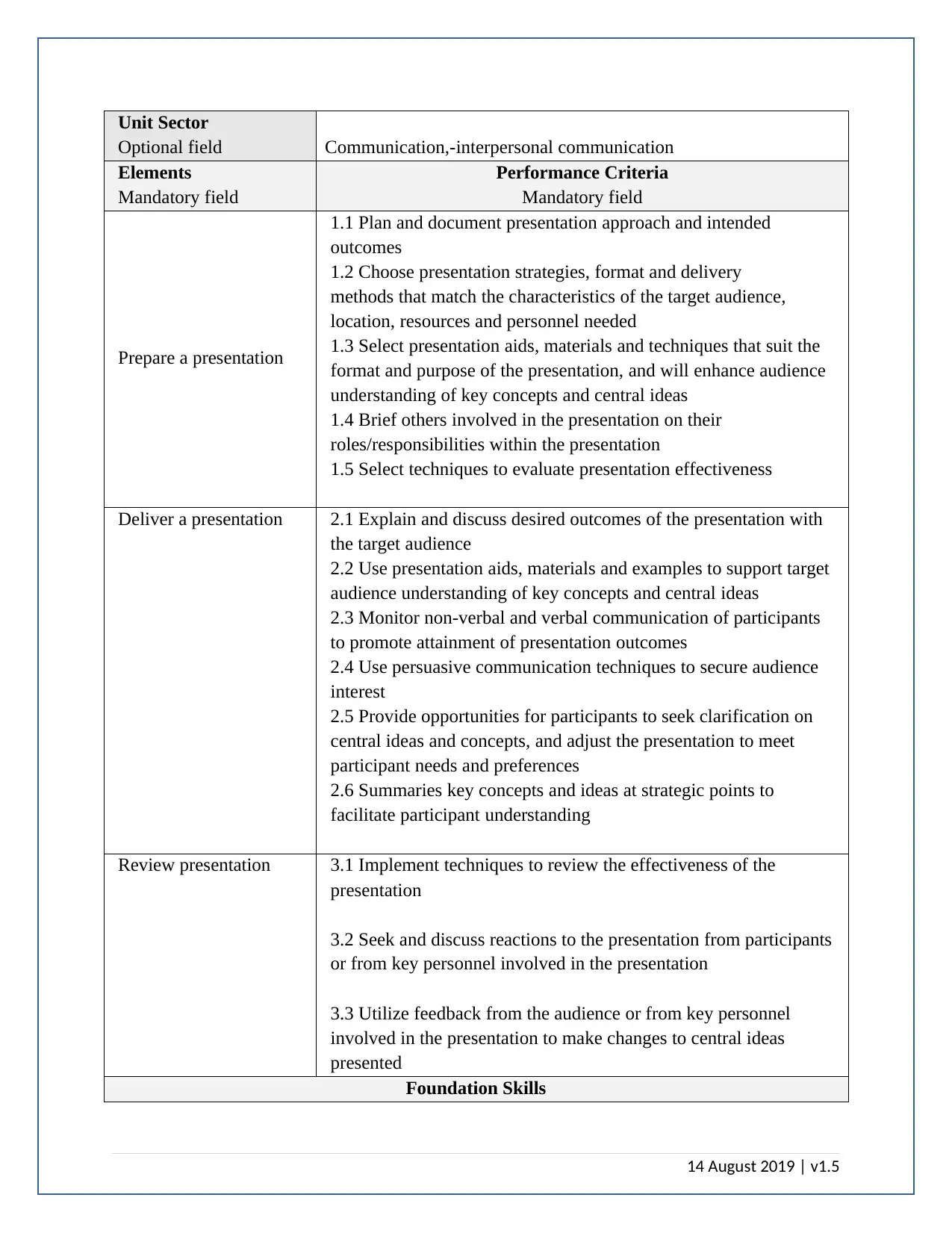
Unit Sector
Optional field Communication,-interpersonal communication
Elements
Mandatory field
Performance Criteria
Mandatory field
Prepare a presentation
1.1 Plan and document presentation approach and intended
outcomes
1.2 Choose presentation strategies, format and delivery
methods that match the characteristics of the target audience,
location, resources and personnel needed
1.3 Select presentation aids, materials and techniques that suit the
format and purpose of the presentation, and will enhance audience
understanding of key concepts and central ideas
1.4 Brief others involved in the presentation on their
roles/responsibilities within the presentation
1.5 Select techniques to evaluate presentation effectiveness
Deliver a presentation 2.1 Explain and discuss desired outcomes of the presentation with
the target audience
2.2 Use presentation aids, materials and examples to support target
audience understanding of key concepts and central ideas
2.3 Monitor non-verbal and verbal communication of participants
to promote attainment of presentation outcomes
2.4 Use persuasive communication techniques to secure audience
interest
2.5 Provide opportunities for participants to seek clarification on
central ideas and concepts, and adjust the presentation to meet
participant needs and preferences
2.6 Summaries key concepts and ideas at strategic points to
facilitate participant understanding
Review presentation 3.1 Implement techniques to review the effectiveness of the
presentation
3.2 Seek and discuss reactions to the presentation from participants
or from key personnel involved in the presentation
3.3 Utilize feedback from the audience or from key personnel
involved in the presentation to make changes to central ideas
presented
Foundation Skills
14 August 2019 | v1.5
Optional field Communication,-interpersonal communication
Elements
Mandatory field
Performance Criteria
Mandatory field
Prepare a presentation
1.1 Plan and document presentation approach and intended
outcomes
1.2 Choose presentation strategies, format and delivery
methods that match the characteristics of the target audience,
location, resources and personnel needed
1.3 Select presentation aids, materials and techniques that suit the
format and purpose of the presentation, and will enhance audience
understanding of key concepts and central ideas
1.4 Brief others involved in the presentation on their
roles/responsibilities within the presentation
1.5 Select techniques to evaluate presentation effectiveness
Deliver a presentation 2.1 Explain and discuss desired outcomes of the presentation with
the target audience
2.2 Use presentation aids, materials and examples to support target
audience understanding of key concepts and central ideas
2.3 Monitor non-verbal and verbal communication of participants
to promote attainment of presentation outcomes
2.4 Use persuasive communication techniques to secure audience
interest
2.5 Provide opportunities for participants to seek clarification on
central ideas and concepts, and adjust the presentation to meet
participant needs and preferences
2.6 Summaries key concepts and ideas at strategic points to
facilitate participant understanding
Review presentation 3.1 Implement techniques to review the effectiveness of the
presentation
3.2 Seek and discuss reactions to the presentation from participants
or from key personnel involved in the presentation
3.3 Utilize feedback from the audience or from key personnel
involved in the presentation to make changes to central ideas
presented
Foundation Skills
14 August 2019 | v1.5
Secure Best Marks with AI Grader
Need help grading? Try our AI Grader for instant feedback on your assignments.
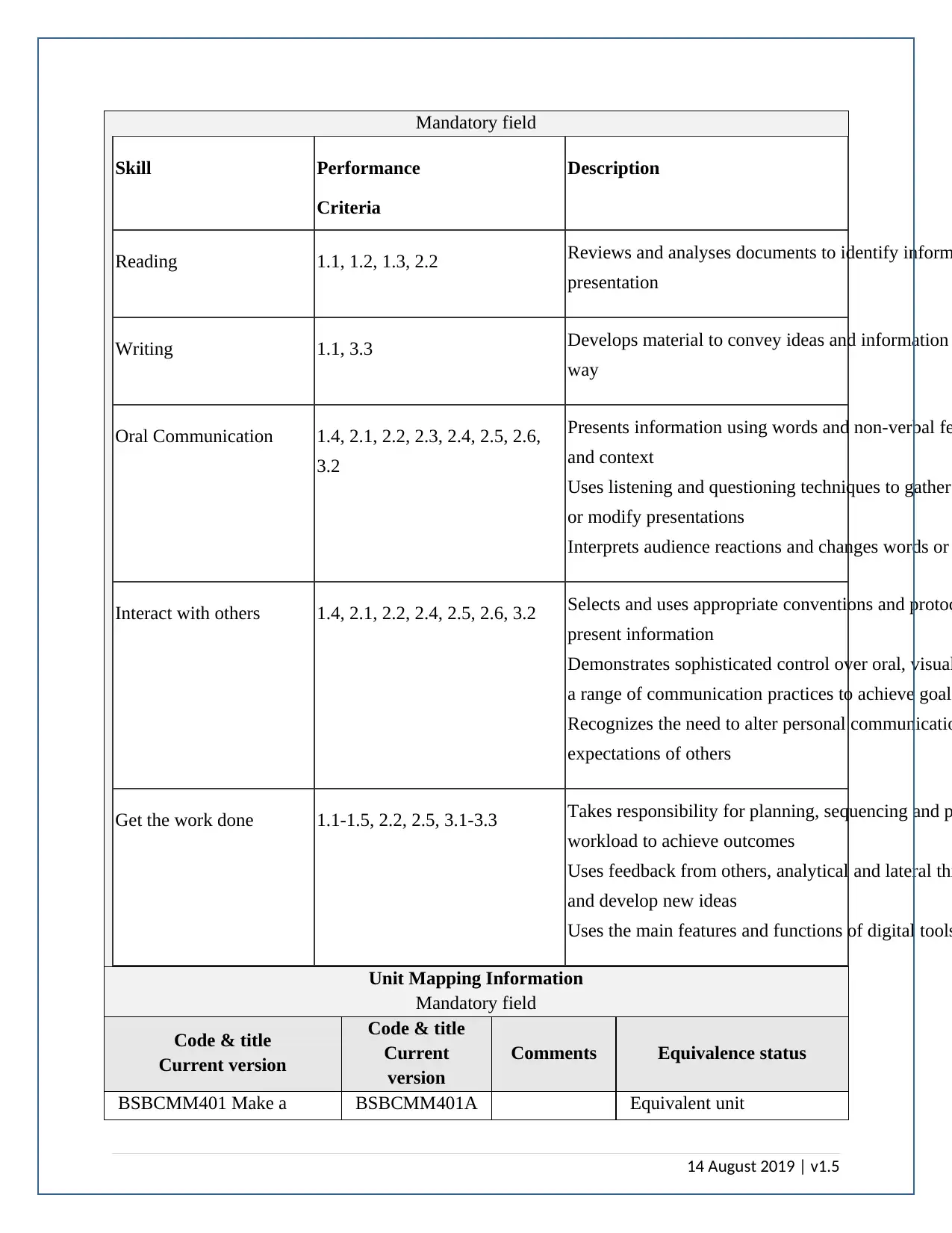
Mandatory field
Skill Performance
Criteria
Description
Reading 1.1, 1.2, 1.3, 2.2 Reviews and analyses documents to identify inform
presentation
Writing 1.1, 3.3 Develops material to convey ideas and information
way
Oral Communication 1.4, 2.1, 2.2, 2.3, 2.4, 2.5, 2.6,
3.2
Presents information using words and non-verbal fe
and context
Uses listening and questioning techniques to gather
or modify presentations
Interprets audience reactions and changes words or
Interact with others 1.4, 2.1, 2.2, 2.4, 2.5, 2.6, 3.2 Selects and uses appropriate conventions and protoc
present information
Demonstrates sophisticated control over oral, visual
a range of communication practices to achieve goals
Recognizes the need to alter personal communicatio
expectations of others
Get the work done 1.1-1.5, 2.2, 2.5, 3.1-3.3 Takes responsibility for planning, sequencing and p
workload to achieve outcomes
Uses feedback from others, analytical and lateral thi
and develop new ideas
Uses the main features and functions of digital tools
Unit Mapping Information
Mandatory field
Code & title
Current version
Code & title
Current
version
Comments Equivalence status
BSBCMM401 Make a BSBCMM401A Equivalent unit
14 August 2019 | v1.5
Skill Performance
Criteria
Description
Reading 1.1, 1.2, 1.3, 2.2 Reviews and analyses documents to identify inform
presentation
Writing 1.1, 3.3 Develops material to convey ideas and information
way
Oral Communication 1.4, 2.1, 2.2, 2.3, 2.4, 2.5, 2.6,
3.2
Presents information using words and non-verbal fe
and context
Uses listening and questioning techniques to gather
or modify presentations
Interprets audience reactions and changes words or
Interact with others 1.4, 2.1, 2.2, 2.4, 2.5, 2.6, 3.2 Selects and uses appropriate conventions and protoc
present information
Demonstrates sophisticated control over oral, visual
a range of communication practices to achieve goals
Recognizes the need to alter personal communicatio
expectations of others
Get the work done 1.1-1.5, 2.2, 2.5, 3.1-3.3 Takes responsibility for planning, sequencing and p
workload to achieve outcomes
Uses feedback from others, analytical and lateral thi
and develop new ideas
Uses the main features and functions of digital tools
Unit Mapping Information
Mandatory field
Code & title
Current version
Code & title
Current
version
Comments Equivalence status
BSBCMM401 Make a BSBCMM401A Equivalent unit
14 August 2019 | v1.5
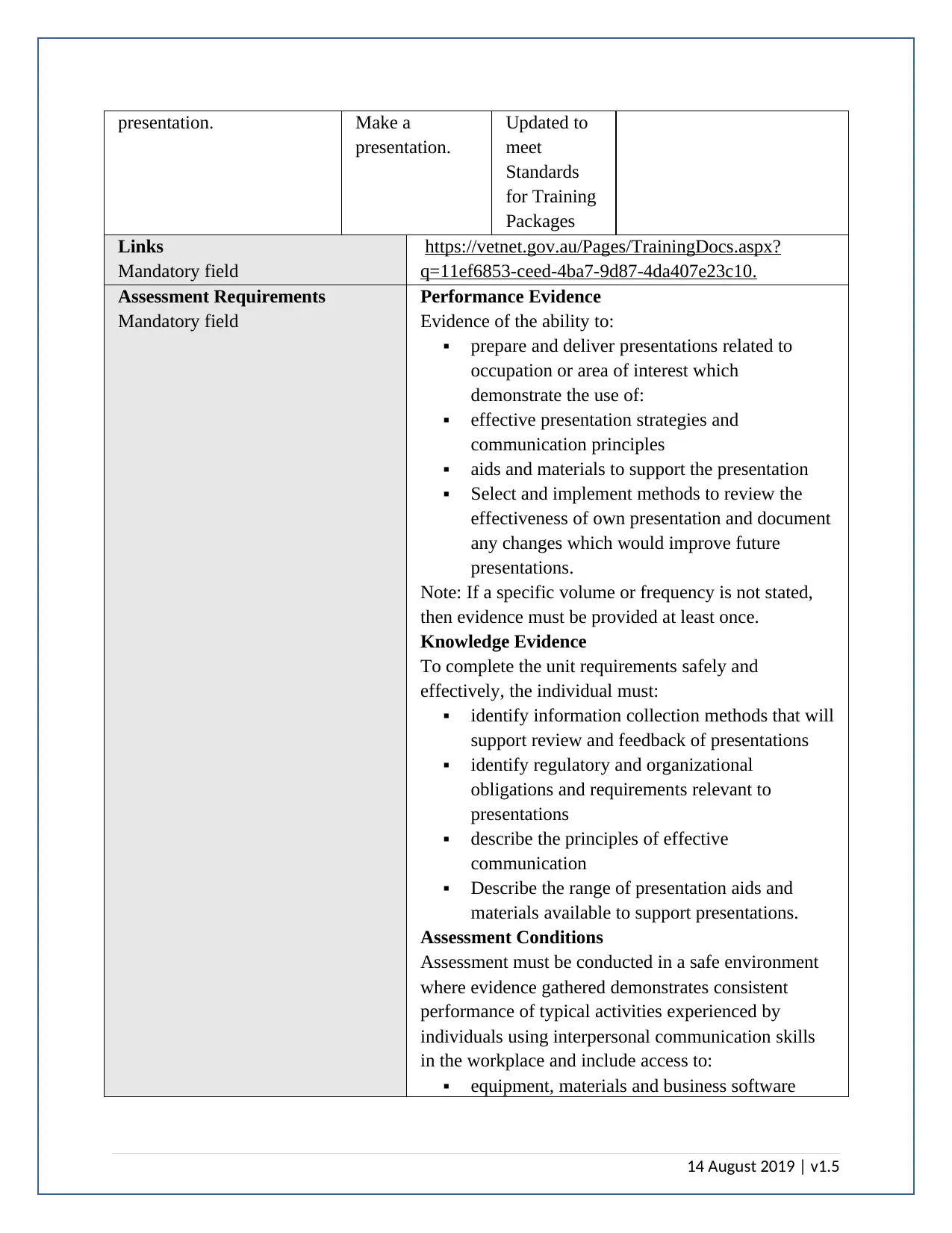
presentation. Make a
presentation.
Updated to
meet
Standards
for Training
Packages
Links
Mandatory field
https://vetnet.gov.au/Pages/TrainingDocs.aspx?
q=11ef6853-ceed-4ba7-9d87-4da407e23c10.
Assessment Requirements
Mandatory field
Performance Evidence
Evidence of the ability to:
prepare and deliver presentations related to
occupation or area of interest which
demonstrate the use of:
effective presentation strategies and
communication principles
aids and materials to support the presentation
Select and implement methods to review the
effectiveness of own presentation and document
any changes which would improve future
presentations.
Note: If a specific volume or frequency is not stated,
then evidence must be provided at least once.
Knowledge Evidence
To complete the unit requirements safely and
effectively, the individual must:
identify information collection methods that will
support review and feedback of presentations
identify regulatory and organizational
obligations and requirements relevant to
presentations
describe the principles of effective
communication
Describe the range of presentation aids and
materials available to support presentations.
Assessment Conditions
Assessment must be conducted in a safe environment
where evidence gathered demonstrates consistent
performance of typical activities experienced by
individuals using interpersonal communication skills
in the workplace and include access to:
equipment, materials and business software
14 August 2019 | v1.5
presentation.
Updated to
meet
Standards
for Training
Packages
Links
Mandatory field
https://vetnet.gov.au/Pages/TrainingDocs.aspx?
q=11ef6853-ceed-4ba7-9d87-4da407e23c10.
Assessment Requirements
Mandatory field
Performance Evidence
Evidence of the ability to:
prepare and deliver presentations related to
occupation or area of interest which
demonstrate the use of:
effective presentation strategies and
communication principles
aids and materials to support the presentation
Select and implement methods to review the
effectiveness of own presentation and document
any changes which would improve future
presentations.
Note: If a specific volume or frequency is not stated,
then evidence must be provided at least once.
Knowledge Evidence
To complete the unit requirements safely and
effectively, the individual must:
identify information collection methods that will
support review and feedback of presentations
identify regulatory and organizational
obligations and requirements relevant to
presentations
describe the principles of effective
communication
Describe the range of presentation aids and
materials available to support presentations.
Assessment Conditions
Assessment must be conducted in a safe environment
where evidence gathered demonstrates consistent
performance of typical activities experienced by
individuals using interpersonal communication skills
in the workplace and include access to:
equipment, materials and business software
14 August 2019 | v1.5
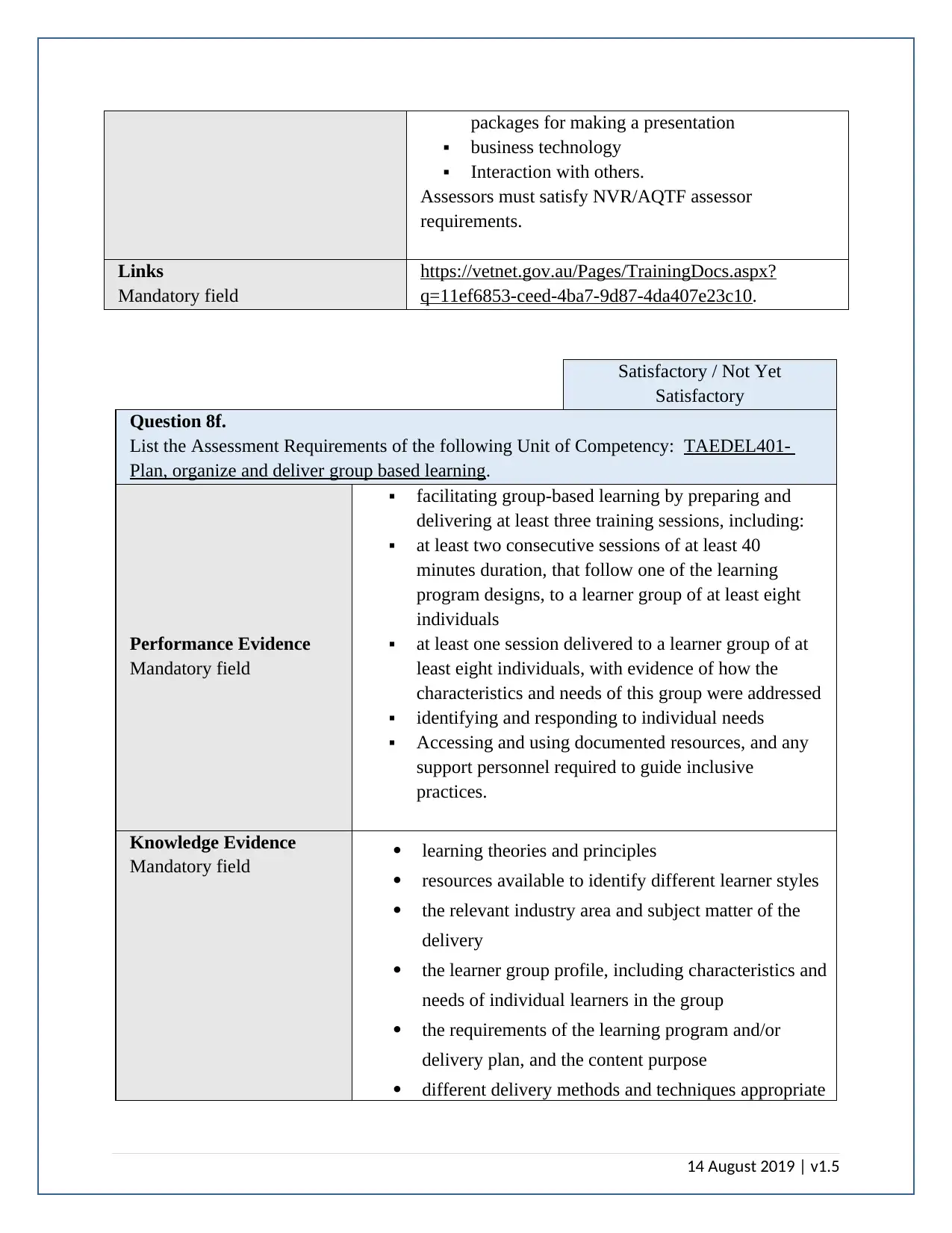
packages for making a presentation
business technology
Interaction with others.
Assessors must satisfy NVR/AQTF assessor
requirements.
Links
Mandatory field
https://vetnet.gov.au/Pages/TrainingDocs.aspx?
q=11ef6853-ceed-4ba7-9d87-4da407e23c10.
Satisfactory / Not Yet
Satisfactory
Question 8f.
List the Assessment Requirements of the following Unit of Competency: TAEDEL401-
Plan, organize and deliver group based learning.
Performance Evidence
Mandatory field
facilitating group-based learning by preparing and
delivering at least three training sessions, including:
at least two consecutive sessions of at least 40
minutes duration, that follow one of the learning
program designs, to a learner group of at least eight
individuals
at least one session delivered to a learner group of at
least eight individuals, with evidence of how the
characteristics and needs of this group were addressed
identifying and responding to individual needs
Accessing and using documented resources, and any
support personnel required to guide inclusive
practices.
Knowledge Evidence
Mandatory field learning theories and principles
resources available to identify different learner styles
the relevant industry area and subject matter of the
delivery
the learner group profile, including characteristics and
needs of individual learners in the group
the requirements of the learning program and/or
delivery plan, and the content purpose
different delivery methods and techniques appropriate
14 August 2019 | v1.5
business technology
Interaction with others.
Assessors must satisfy NVR/AQTF assessor
requirements.
Links
Mandatory field
https://vetnet.gov.au/Pages/TrainingDocs.aspx?
q=11ef6853-ceed-4ba7-9d87-4da407e23c10.
Satisfactory / Not Yet
Satisfactory
Question 8f.
List the Assessment Requirements of the following Unit of Competency: TAEDEL401-
Plan, organize and deliver group based learning.
Performance Evidence
Mandatory field
facilitating group-based learning by preparing and
delivering at least three training sessions, including:
at least two consecutive sessions of at least 40
minutes duration, that follow one of the learning
program designs, to a learner group of at least eight
individuals
at least one session delivered to a learner group of at
least eight individuals, with evidence of how the
characteristics and needs of this group were addressed
identifying and responding to individual needs
Accessing and using documented resources, and any
support personnel required to guide inclusive
practices.
Knowledge Evidence
Mandatory field learning theories and principles
resources available to identify different learner styles
the relevant industry area and subject matter of the
delivery
the learner group profile, including characteristics and
needs of individual learners in the group
the requirements of the learning program and/or
delivery plan, and the content purpose
different delivery methods and techniques appropriate
14 August 2019 | v1.5
Paraphrase This Document
Need a fresh take? Get an instant paraphrase of this document with our AI Paraphraser
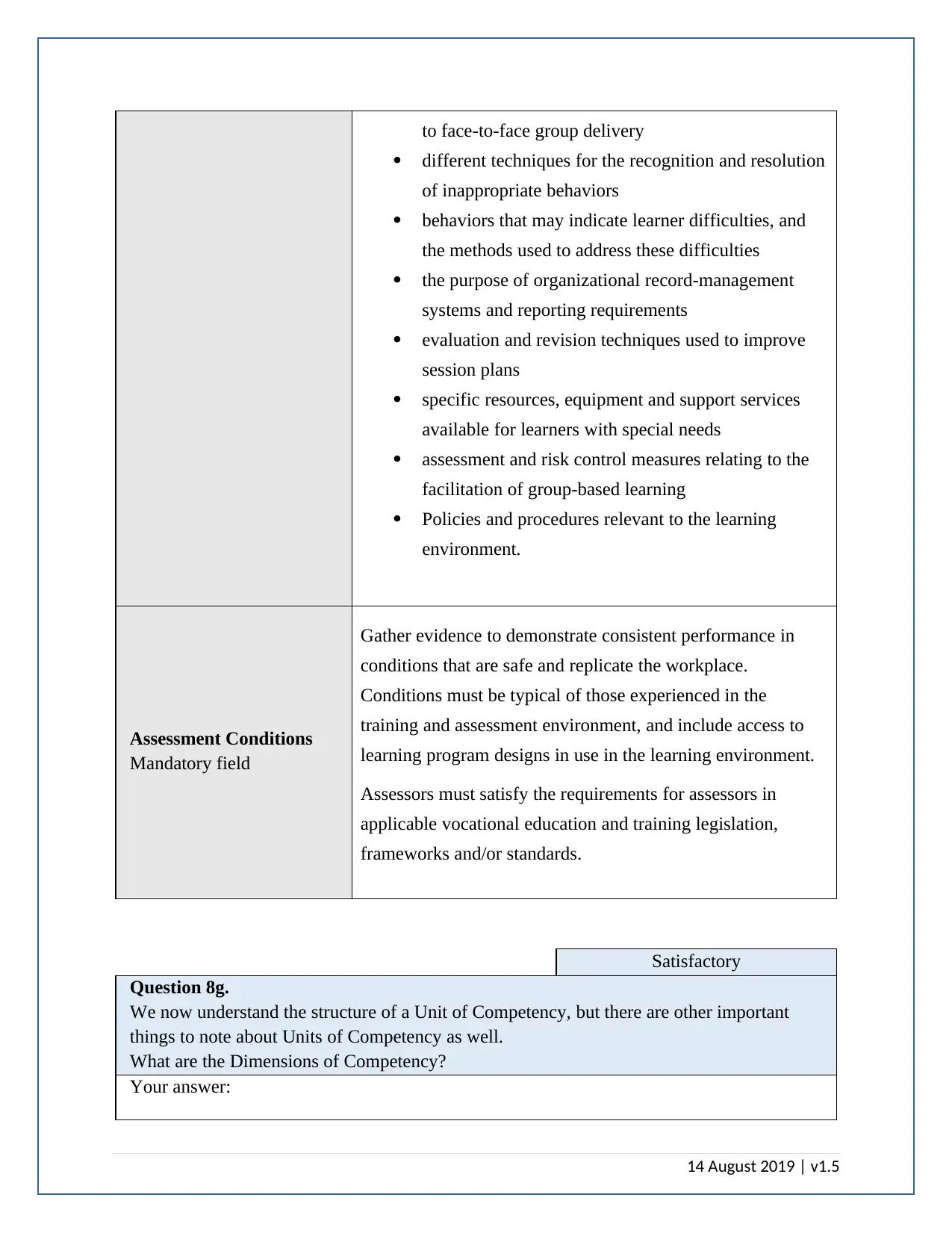
to face-to-face group delivery
different techniques for the recognition and resolution
of inappropriate behaviors
behaviors that may indicate learner difficulties, and
the methods used to address these difficulties
the purpose of organizational record-management
systems and reporting requirements
evaluation and revision techniques used to improve
session plans
specific resources, equipment and support services
available for learners with special needs
assessment and risk control measures relating to the
facilitation of group-based learning
Policies and procedures relevant to the learning
environment.
Assessment Conditions
Mandatory field
Gather evidence to demonstrate consistent performance in
conditions that are safe and replicate the workplace.
Conditions must be typical of those experienced in the
training and assessment environment, and include access to
learning program designs in use in the learning environment.
Assessors must satisfy the requirements for assessors in
applicable vocational education and training legislation,
frameworks and/or standards.
Satisfactory
Question 8g.
We now understand the structure of a Unit of Competency, but there are other important
things to note about Units of Competency as well.
What are the Dimensions of Competency?
Your answer:
14 August 2019 | v1.5
different techniques for the recognition and resolution
of inappropriate behaviors
behaviors that may indicate learner difficulties, and
the methods used to address these difficulties
the purpose of organizational record-management
systems and reporting requirements
evaluation and revision techniques used to improve
session plans
specific resources, equipment and support services
available for learners with special needs
assessment and risk control measures relating to the
facilitation of group-based learning
Policies and procedures relevant to the learning
environment.
Assessment Conditions
Mandatory field
Gather evidence to demonstrate consistent performance in
conditions that are safe and replicate the workplace.
Conditions must be typical of those experienced in the
training and assessment environment, and include access to
learning program designs in use in the learning environment.
Assessors must satisfy the requirements for assessors in
applicable vocational education and training legislation,
frameworks and/or standards.
Satisfactory
Question 8g.
We now understand the structure of a Unit of Competency, but there are other important
things to note about Units of Competency as well.
What are the Dimensions of Competency?
Your answer:
14 August 2019 | v1.5
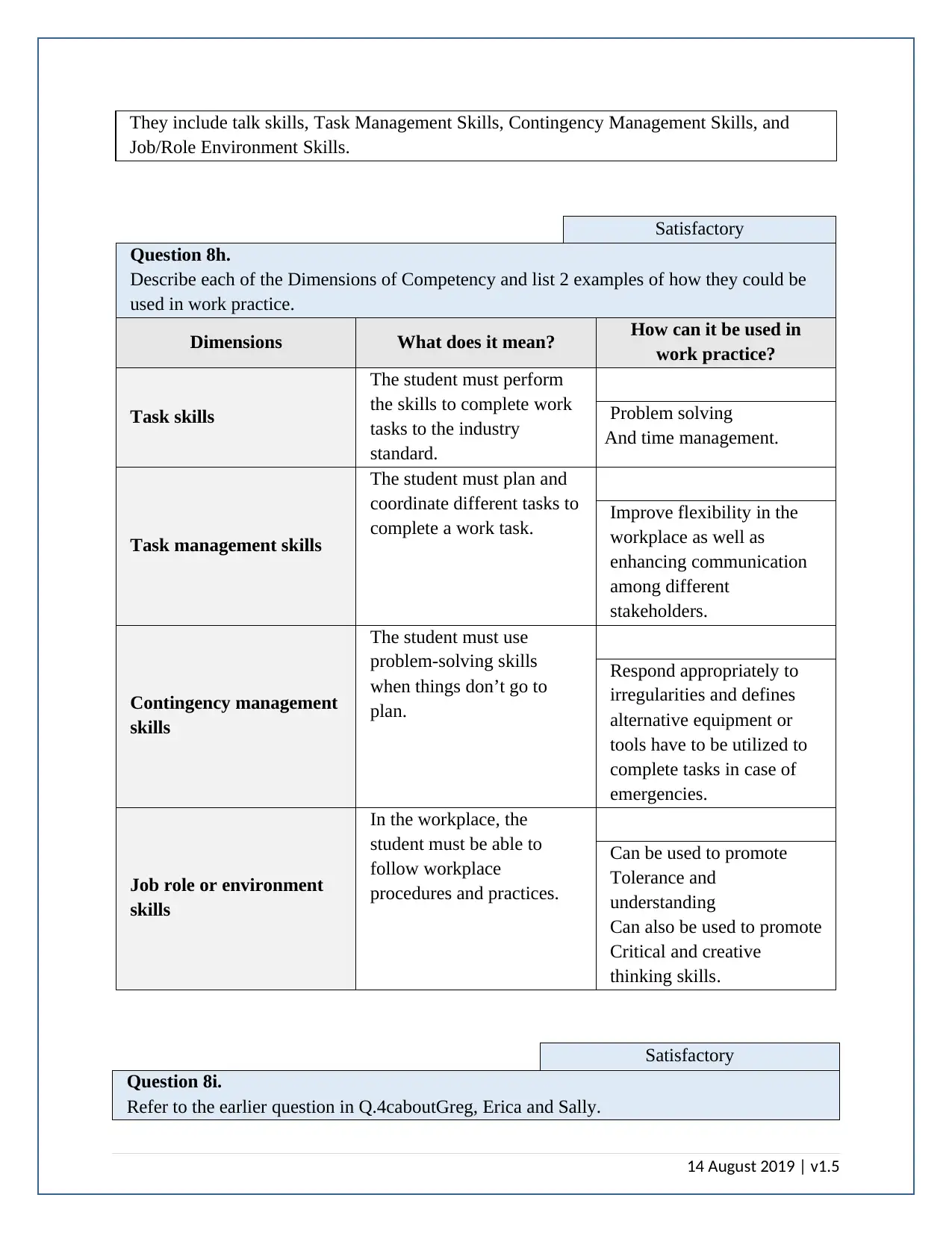
They include talk skills, Task Management Skills, Contingency Management Skills, and
Job/Role Environment Skills.
Satisfactory
Question 8h.
Describe each of the Dimensions of Competency and list 2 examples of how they could be
used in work practice.
Dimensions What does it mean? How can it be used in
work practice?
Task skills
The student must perform
the skills to complete work
tasks to the industry
standard.
Problem solving
And time management.
Task management skills
The student must plan and
coordinate different tasks to
complete a work task. Improve flexibility in the
workplace as well as
enhancing communication
among different
stakeholders.
Contingency management
skills
The student must use
problem-solving skills
when things don’t go to
plan.
Respond appropriately to
irregularities and defines
alternative equipment or
tools have to be utilized to
complete tasks in case of
emergencies.
Job role or environment
skills
In the workplace, the
student must be able to
follow workplace
procedures and practices.
Can be used to promote
Tolerance and
understanding
Can also be used to promote
Critical and creative
thinking skills.
Satisfactory
Question 8i.
Refer to the earlier question in Q.4caboutGreg, Erica and Sally.
14 August 2019 | v1.5
Job/Role Environment Skills.
Satisfactory
Question 8h.
Describe each of the Dimensions of Competency and list 2 examples of how they could be
used in work practice.
Dimensions What does it mean? How can it be used in
work practice?
Task skills
The student must perform
the skills to complete work
tasks to the industry
standard.
Problem solving
And time management.
Task management skills
The student must plan and
coordinate different tasks to
complete a work task. Improve flexibility in the
workplace as well as
enhancing communication
among different
stakeholders.
Contingency management
skills
The student must use
problem-solving skills
when things don’t go to
plan.
Respond appropriately to
irregularities and defines
alternative equipment or
tools have to be utilized to
complete tasks in case of
emergencies.
Job role or environment
skills
In the workplace, the
student must be able to
follow workplace
procedures and practices.
Can be used to promote
Tolerance and
understanding
Can also be used to promote
Critical and creative
thinking skills.
Satisfactory
Question 8i.
Refer to the earlier question in Q.4caboutGreg, Erica and Sally.
14 August 2019 | v1.5
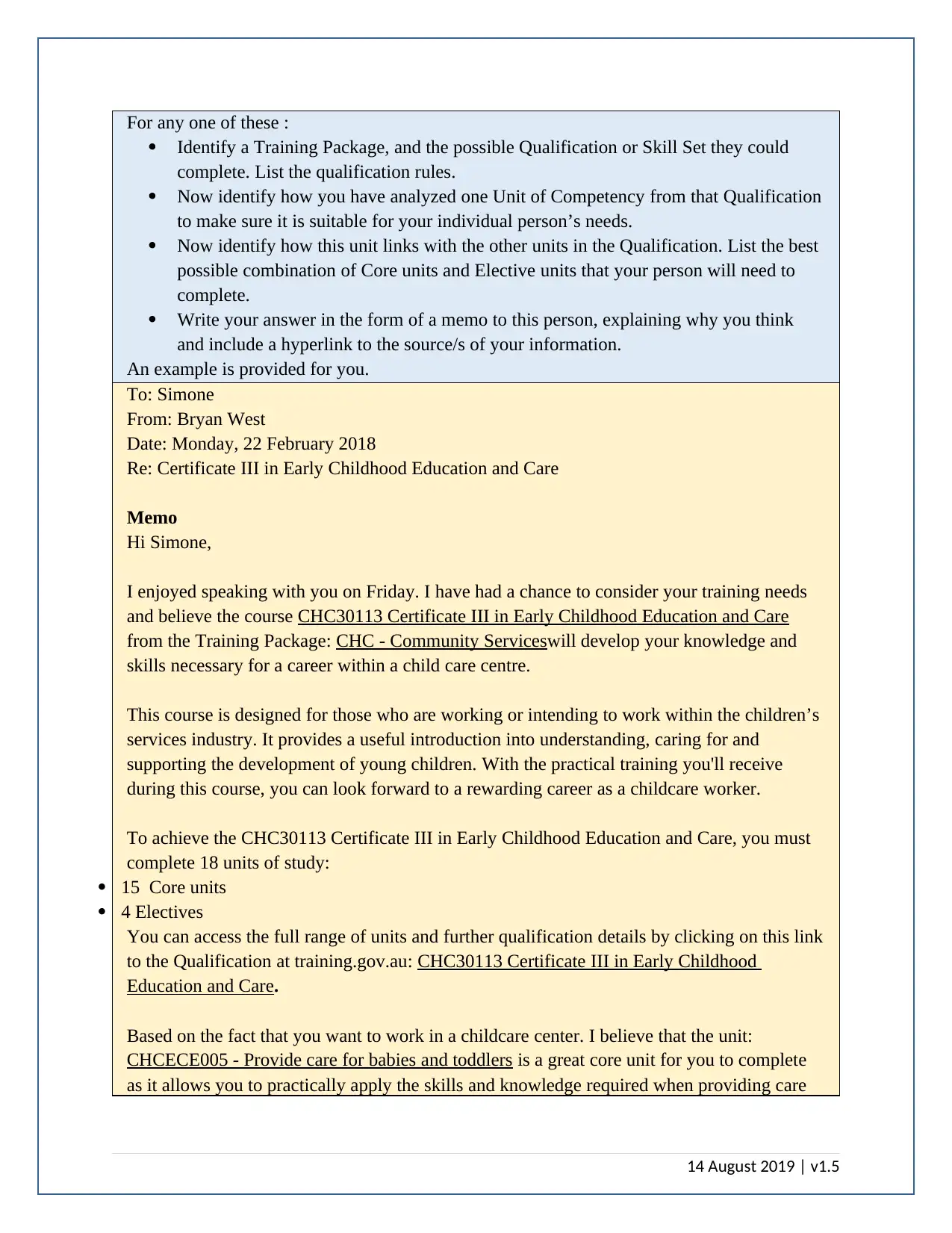
For any one of these :
Identify a Training Package, and the possible Qualification or Skill Set they could
complete. List the qualification rules.
Now identify how you have analyzed one Unit of Competency from that Qualification
to make sure it is suitable for your individual person’s needs.
Now identify how this unit links with the other units in the Qualification. List the best
possible combination of Core units and Elective units that your person will need to
complete.
Write your answer in the form of a memo to this person, explaining why you think
and include a hyperlink to the source/s of your information.
An example is provided for you.
To: Simone
From: Bryan West
Date: Monday, 22 February 2018
Re: Certificate III in Early Childhood Education and Care
Memo
Hi Simone,
I enjoyed speaking with you on Friday. I have had a chance to consider your training needs
and believe the course CHC30113 Certificate III in Early Childhood Education and Care
from the Training Package: CHC - Community Serviceswill develop your knowledge and
skills necessary for a career within a child care centre.
This course is designed for those who are working or intending to work within the children’s
services industry. It provides a useful introduction into understanding, caring for and
supporting the development of young children. With the practical training you'll receive
during this course, you can look forward to a rewarding career as a childcare worker.
To achieve the CHC30113 Certificate III in Early Childhood Education and Care, you must
complete 18 units of study:
15 Core units
4 Electives
You can access the full range of units and further qualification details by clicking on this link
to the Qualification at training.gov.au: CHC30113 Certificate III in Early Childhood
Education and Care.
Based on the fact that you want to work in a childcare center. I believe that the unit:
CHCECE005 - Provide care for babies and toddlers is a great core unit for you to complete
as it allows you to practically apply the skills and knowledge required when providing care
14 August 2019 | v1.5
Identify a Training Package, and the possible Qualification or Skill Set they could
complete. List the qualification rules.
Now identify how you have analyzed one Unit of Competency from that Qualification
to make sure it is suitable for your individual person’s needs.
Now identify how this unit links with the other units in the Qualification. List the best
possible combination of Core units and Elective units that your person will need to
complete.
Write your answer in the form of a memo to this person, explaining why you think
and include a hyperlink to the source/s of your information.
An example is provided for you.
To: Simone
From: Bryan West
Date: Monday, 22 February 2018
Re: Certificate III in Early Childhood Education and Care
Memo
Hi Simone,
I enjoyed speaking with you on Friday. I have had a chance to consider your training needs
and believe the course CHC30113 Certificate III in Early Childhood Education and Care
from the Training Package: CHC - Community Serviceswill develop your knowledge and
skills necessary for a career within a child care centre.
This course is designed for those who are working or intending to work within the children’s
services industry. It provides a useful introduction into understanding, caring for and
supporting the development of young children. With the practical training you'll receive
during this course, you can look forward to a rewarding career as a childcare worker.
To achieve the CHC30113 Certificate III in Early Childhood Education and Care, you must
complete 18 units of study:
15 Core units
4 Electives
You can access the full range of units and further qualification details by clicking on this link
to the Qualification at training.gov.au: CHC30113 Certificate III in Early Childhood
Education and Care.
Based on the fact that you want to work in a childcare center. I believe that the unit:
CHCECE005 - Provide care for babies and toddlers is a great core unit for you to complete
as it allows you to practically apply the skills and knowledge required when providing care
14 August 2019 | v1.5
Secure Best Marks with AI Grader
Need help grading? Try our AI Grader for instant feedback on your assignments.
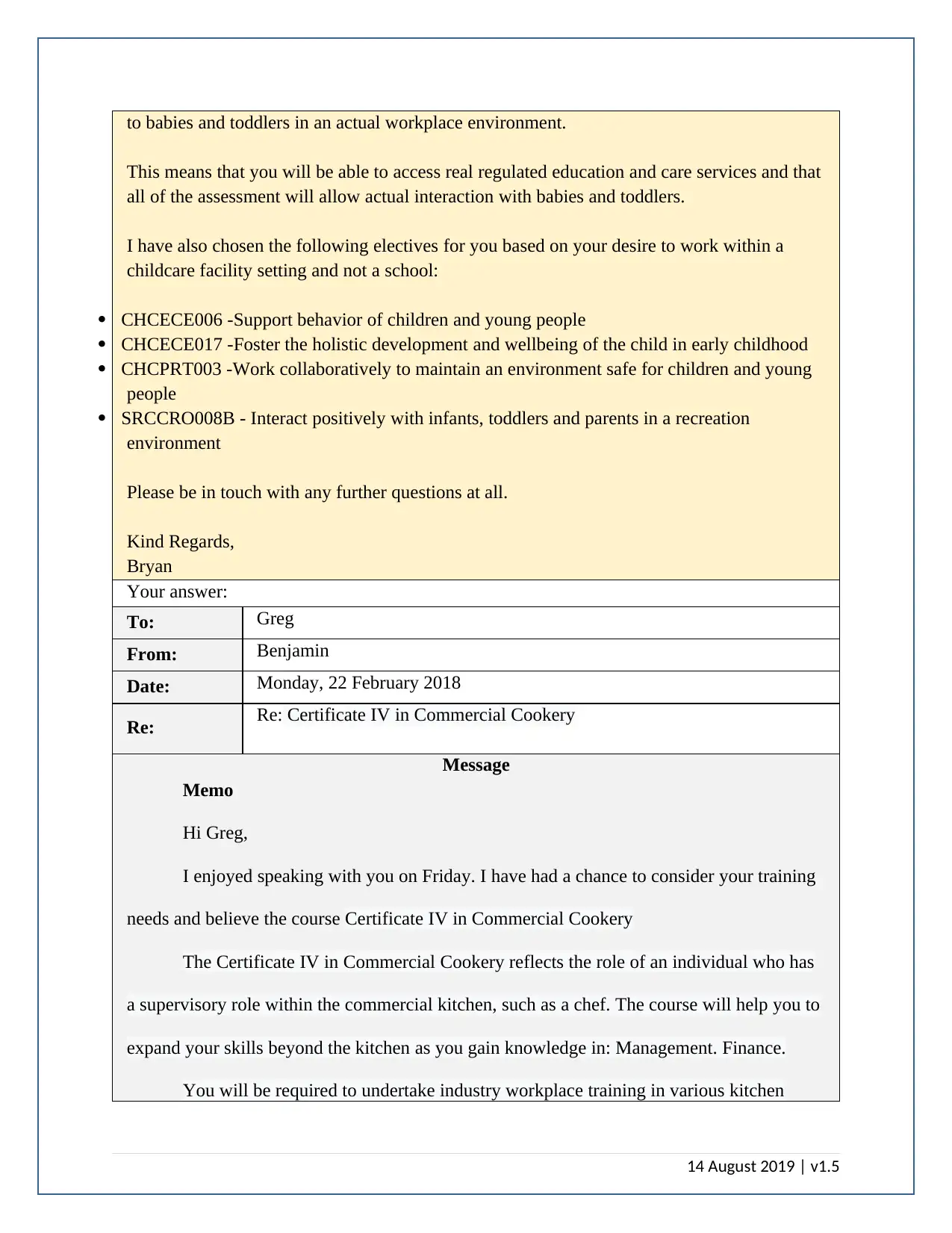
to babies and toddlers in an actual workplace environment.
This means that you will be able to access real regulated education and care services and that
all of the assessment will allow actual interaction with babies and toddlers.
I have also chosen the following electives for you based on your desire to work within a
childcare facility setting and not a school:
CHCECE006 -Support behavior of children and young people
CHCECE017 -Foster the holistic development and wellbeing of the child in early childhood
CHCPRT003 -Work collaboratively to maintain an environment safe for children and young
people
SRCCRO008B - Interact positively with infants, toddlers and parents in a recreation
environment
Please be in touch with any further questions at all.
Kind Regards,
Bryan
Your answer:
To: Greg
From: Benjamin
Date: Monday, 22 February 2018
Re: Re: Certificate IV in Commercial Cookery
Message
Memo
Hi Greg,
I enjoyed speaking with you on Friday. I have had a chance to consider your training
needs and believe the course Certificate IV in Commercial Cookery
The Certificate IV in Commercial Cookery reflects the role of an individual who has
a supervisory role within the commercial kitchen, such as a chef. The course will help you to
expand your skills beyond the kitchen as you gain knowledge in: Management. Finance.
You will be required to undertake industry workplace training in various kitchen
14 August 2019 | v1.5
This means that you will be able to access real regulated education and care services and that
all of the assessment will allow actual interaction with babies and toddlers.
I have also chosen the following electives for you based on your desire to work within a
childcare facility setting and not a school:
CHCECE006 -Support behavior of children and young people
CHCECE017 -Foster the holistic development and wellbeing of the child in early childhood
CHCPRT003 -Work collaboratively to maintain an environment safe for children and young
people
SRCCRO008B - Interact positively with infants, toddlers and parents in a recreation
environment
Please be in touch with any further questions at all.
Kind Regards,
Bryan
Your answer:
To: Greg
From: Benjamin
Date: Monday, 22 February 2018
Re: Re: Certificate IV in Commercial Cookery
Message
Memo
Hi Greg,
I enjoyed speaking with you on Friday. I have had a chance to consider your training
needs and believe the course Certificate IV in Commercial Cookery
The Certificate IV in Commercial Cookery reflects the role of an individual who has
a supervisory role within the commercial kitchen, such as a chef. The course will help you to
expand your skills beyond the kitchen as you gain knowledge in: Management. Finance.
You will be required to undertake industry workplace training in various kitchen
14 August 2019 | v1.5
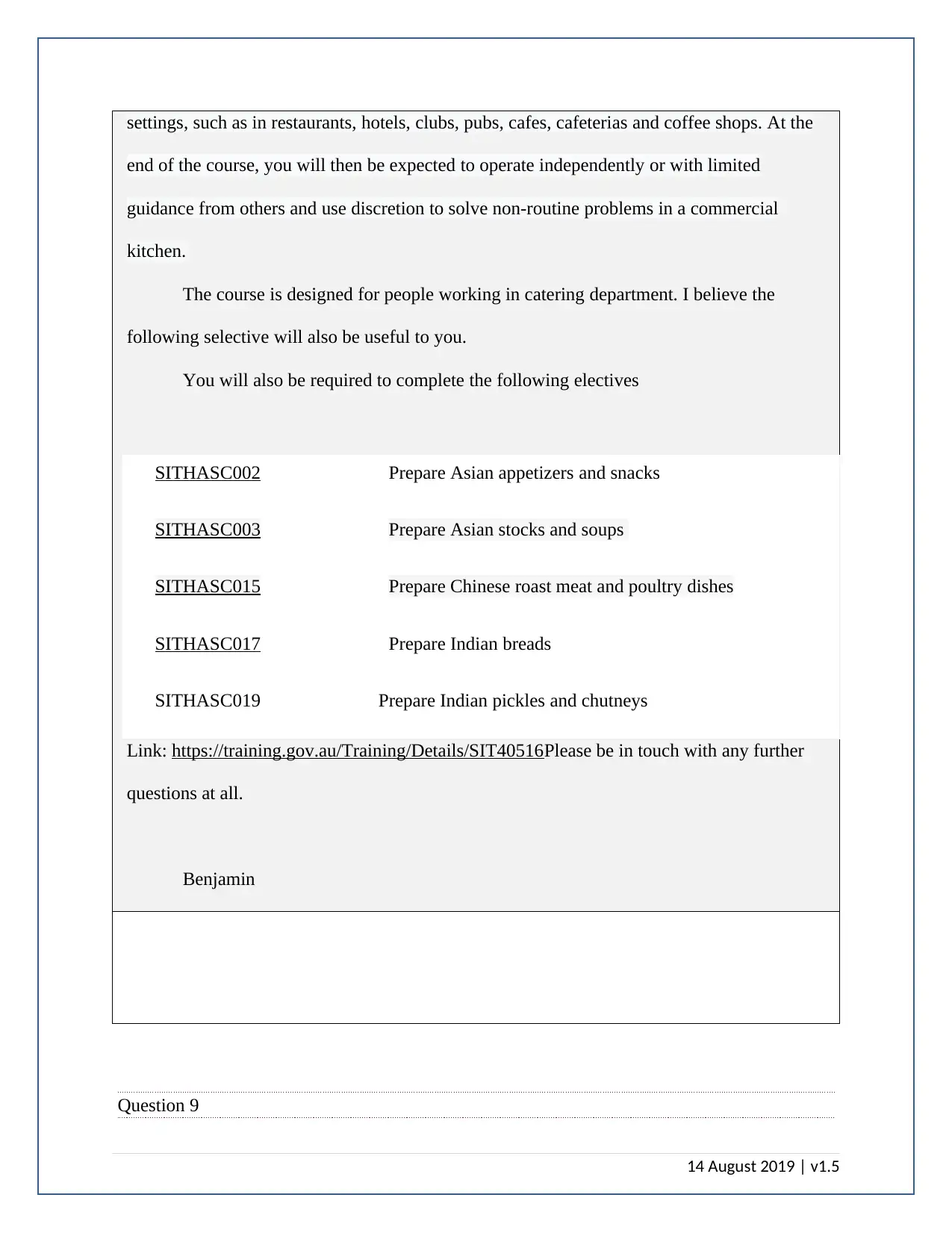
settings, such as in restaurants, hotels, clubs, pubs, cafes, cafeterias and coffee shops. At the
end of the course, you will then be expected to operate independently or with limited
guidance from others and use discretion to solve non-routine problems in a commercial
kitchen.
The course is designed for people working in catering department. I believe the
following selective will also be useful to you.
You will also be required to complete the following electives
SITHASC002 Prepare Asian appetizers and snacks
SITHASC003 Prepare Asian stocks and soups
SITHASC015 Prepare Chinese roast meat and poultry dishes
SITHASC017 Prepare Indian breads
SITHASC019 Prepare Indian pickles and chutneys
Link: https://training.gov.au/Training/Details/SIT40516Please be in touch with any further
questions at all.
Benjamin
Question 9
14 August 2019 | v1.5
end of the course, you will then be expected to operate independently or with limited
guidance from others and use discretion to solve non-routine problems in a commercial
kitchen.
The course is designed for people working in catering department. I believe the
following selective will also be useful to you.
You will also be required to complete the following electives
SITHASC002 Prepare Asian appetizers and snacks
SITHASC003 Prepare Asian stocks and soups
SITHASC015 Prepare Chinese roast meat and poultry dishes
SITHASC017 Prepare Indian breads
SITHASC019 Prepare Indian pickles and chutneys
Link: https://training.gov.au/Training/Details/SIT40516Please be in touch with any further
questions at all.
Benjamin
Question 9
14 August 2019 | v1.5
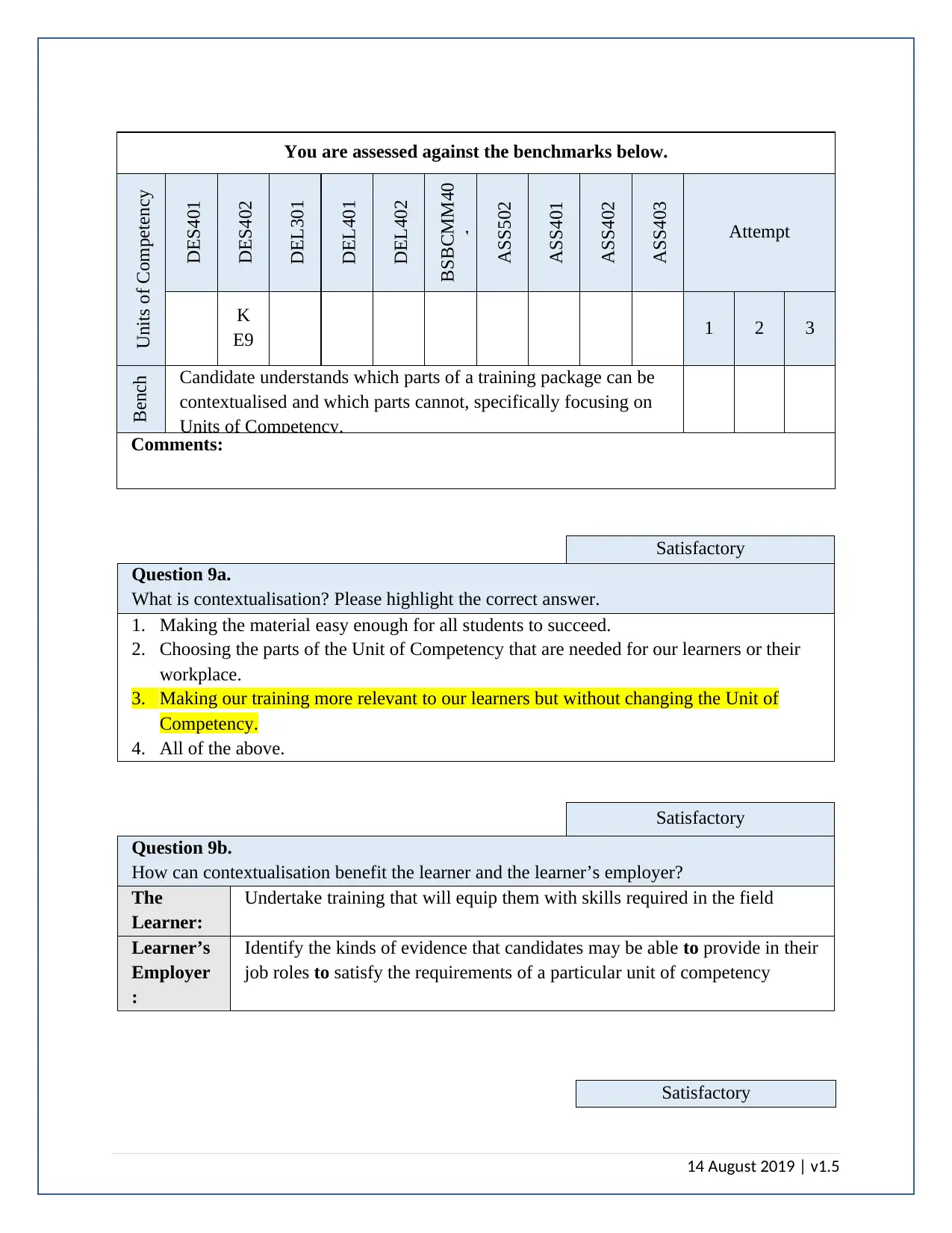
You are assessed against the benchmarks below.
Units of Competency
DES401
DES402
DEL301
DEL401
DEL402
BSBCMM40
1
ASS502
ASS401
ASS402
ASS403
Attempt
K
E9 1 2 3
Bench
marks Candidate understands which parts of a training package can be
contextualised and which parts cannot, specifically focusing on
Units of Competency.
Comments:
Satisfactory
Question 9a.
What is contextualisation? Please highlight the correct answer.
1. Making the material easy enough for all students to succeed.
2. Choosing the parts of the Unit of Competency that are needed for our learners or their
workplace.
3. Making our training more relevant to our learners but without changing the Unit of
Competency.
4. All of the above.
Satisfactory
Question 9b.
How can contextualisation benefit the learner and the learner’s employer?
The
Learner:
Undertake training that will equip them with skills required in the field
Learner’s
Employer
:
Identify the kinds of evidence that candidates may be able to provide in their
job roles to satisfy the requirements of a particular unit of competency
Satisfactory
14 August 2019 | v1.5
Units of Competency
DES401
DES402
DEL301
DEL401
DEL402
BSBCMM40
1
ASS502
ASS401
ASS402
ASS403
Attempt
K
E9 1 2 3
Bench
marks Candidate understands which parts of a training package can be
contextualised and which parts cannot, specifically focusing on
Units of Competency.
Comments:
Satisfactory
Question 9a.
What is contextualisation? Please highlight the correct answer.
1. Making the material easy enough for all students to succeed.
2. Choosing the parts of the Unit of Competency that are needed for our learners or their
workplace.
3. Making our training more relevant to our learners but without changing the Unit of
Competency.
4. All of the above.
Satisfactory
Question 9b.
How can contextualisation benefit the learner and the learner’s employer?
The
Learner:
Undertake training that will equip them with skills required in the field
Learner’s
Employer
:
Identify the kinds of evidence that candidates may be able to provide in their
job roles to satisfy the requirements of a particular unit of competency
Satisfactory
14 August 2019 | v1.5
Paraphrase This Document
Need a fresh take? Get an instant paraphrase of this document with our AI Paraphraser
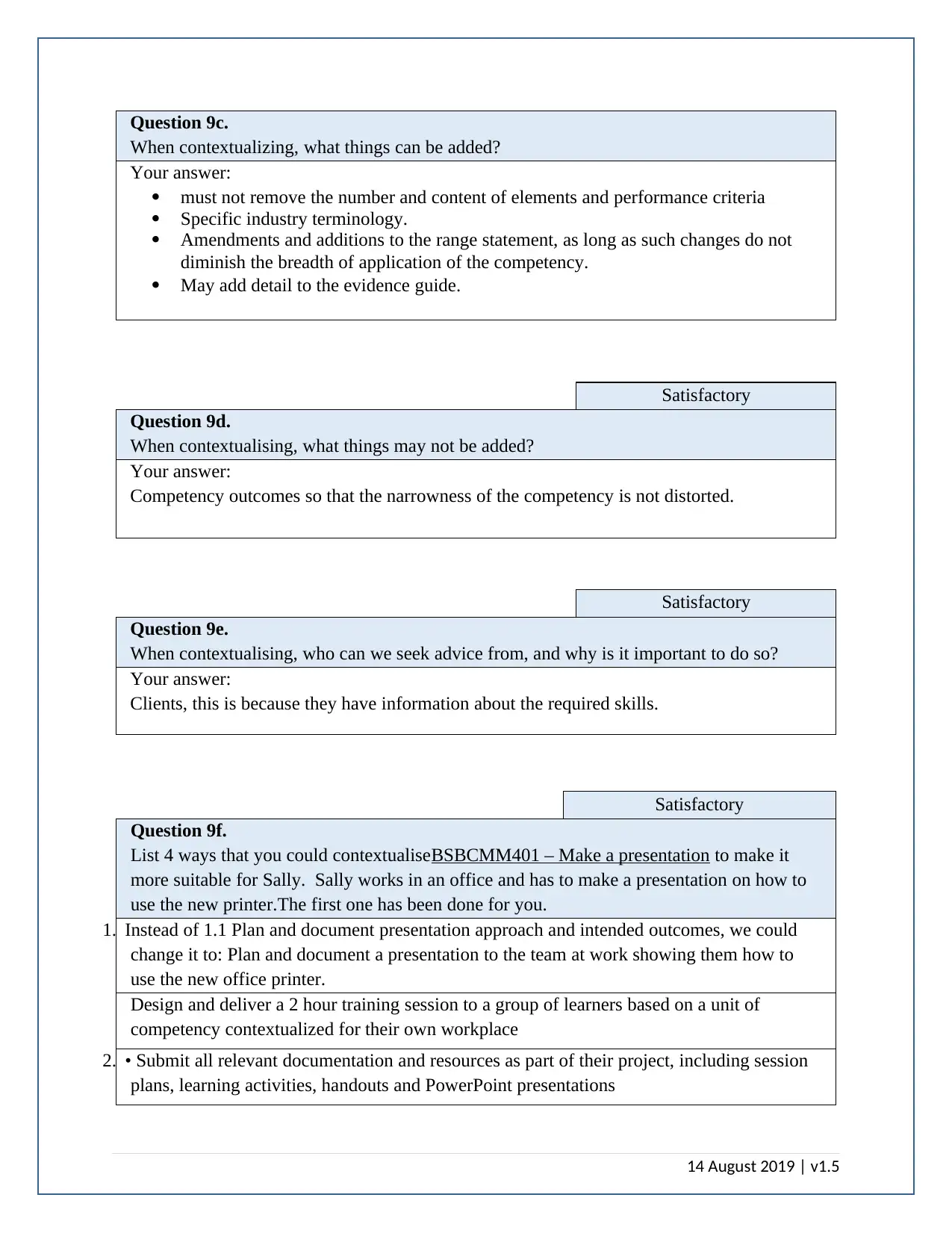
Question 9c.
When contextualizing, what things can be added?
Your answer:
must not remove the number and content of elements and performance criteria
Specific industry terminology.
Amendments and additions to the range statement, as long as such changes do not
diminish the breadth of application of the competency.
May add detail to the evidence guide.
Satisfactory
Question 9d.
When contextualising, what things may not be added?
Your answer:
Competency outcomes so that the narrowness of the competency is not distorted.
Satisfactory
Question 9e.
When contextualising, who can we seek advice from, and why is it important to do so?
Your answer:
Clients, this is because they have information about the required skills.
Satisfactory
Question 9f.
List 4 ways that you could contextualiseBSBCMM401 – Make a presentation to make it
more suitable for Sally. Sally works in an office and has to make a presentation on how to
use the new printer.The first one has been done for you.
1. Instead of 1.1 Plan and document presentation approach and intended outcomes, we could
change it to: Plan and document a presentation to the team at work showing them how to
use the new office printer.
Design and deliver a 2 hour training session to a group of learners based on a unit of
competency contextualized for their own workplace
2. • Submit all relevant documentation and resources as part of their project, including session
plans, learning activities, handouts and PowerPoint presentations
14 August 2019 | v1.5
When contextualizing, what things can be added?
Your answer:
must not remove the number and content of elements and performance criteria
Specific industry terminology.
Amendments and additions to the range statement, as long as such changes do not
diminish the breadth of application of the competency.
May add detail to the evidence guide.
Satisfactory
Question 9d.
When contextualising, what things may not be added?
Your answer:
Competency outcomes so that the narrowness of the competency is not distorted.
Satisfactory
Question 9e.
When contextualising, who can we seek advice from, and why is it important to do so?
Your answer:
Clients, this is because they have information about the required skills.
Satisfactory
Question 9f.
List 4 ways that you could contextualiseBSBCMM401 – Make a presentation to make it
more suitable for Sally. Sally works in an office and has to make a presentation on how to
use the new printer.The first one has been done for you.
1. Instead of 1.1 Plan and document presentation approach and intended outcomes, we could
change it to: Plan and document a presentation to the team at work showing them how to
use the new office printer.
Design and deliver a 2 hour training session to a group of learners based on a unit of
competency contextualized for their own workplace
2. • Submit all relevant documentation and resources as part of their project, including session
plans, learning activities, handouts and PowerPoint presentations
14 August 2019 | v1.5
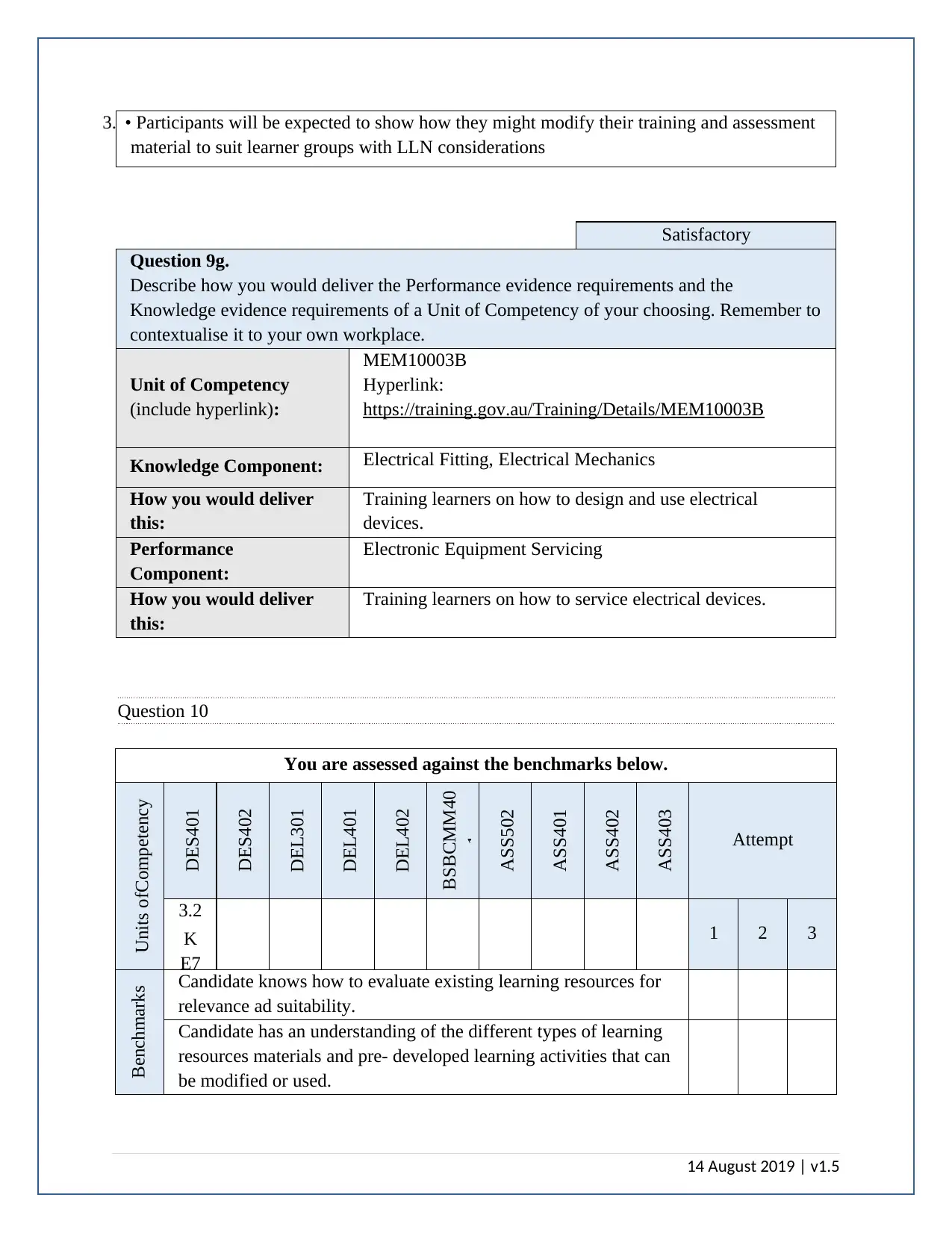
3. • Participants will be expected to show how they might modify their training and assessment
material to suit learner groups with LLN considerations
Satisfactory
Question 9g.
Describe how you would deliver the Performance evidence requirements and the
Knowledge evidence requirements of a Unit of Competency of your choosing. Remember to
contextualise it to your own workplace.
Unit of Competency
(include hyperlink):
MEM10003B
Hyperlink:
https://training.gov.au/Training/Details/MEM10003B
Knowledge Component: Electrical Fitting, Electrical Mechanics
How you would deliver
this:
Training learners on how to design and use electrical
devices.
Performance
Component:
Electronic Equipment Servicing
How you would deliver
this:
Training learners on how to service electrical devices.
Question 10
You are assessed against the benchmarks below.
Units ofCompetency
DES401
DES402
DEL301
DEL401
DEL402
BSBCMM40
1
ASS502
ASS401
ASS402
ASS403
Attempt
3.2
K
E7
1 2 3
Benchmarks Candidate knows how to evaluate existing learning resources for
relevance ad suitability.
Candidate has an understanding of the different types of learning
resources materials and pre- developed learning activities that can
be modified or used.
14 August 2019 | v1.5
material to suit learner groups with LLN considerations
Satisfactory
Question 9g.
Describe how you would deliver the Performance evidence requirements and the
Knowledge evidence requirements of a Unit of Competency of your choosing. Remember to
contextualise it to your own workplace.
Unit of Competency
(include hyperlink):
MEM10003B
Hyperlink:
https://training.gov.au/Training/Details/MEM10003B
Knowledge Component: Electrical Fitting, Electrical Mechanics
How you would deliver
this:
Training learners on how to design and use electrical
devices.
Performance
Component:
Electronic Equipment Servicing
How you would deliver
this:
Training learners on how to service electrical devices.
Question 10
You are assessed against the benchmarks below.
Units ofCompetency
DES401
DES402
DEL301
DEL401
DEL402
BSBCMM40
1
ASS502
ASS401
ASS402
ASS403
Attempt
3.2
K
E7
1 2 3
Benchmarks Candidate knows how to evaluate existing learning resources for
relevance ad suitability.
Candidate has an understanding of the different types of learning
resources materials and pre- developed learning activities that can
be modified or used.
14 August 2019 | v1.5
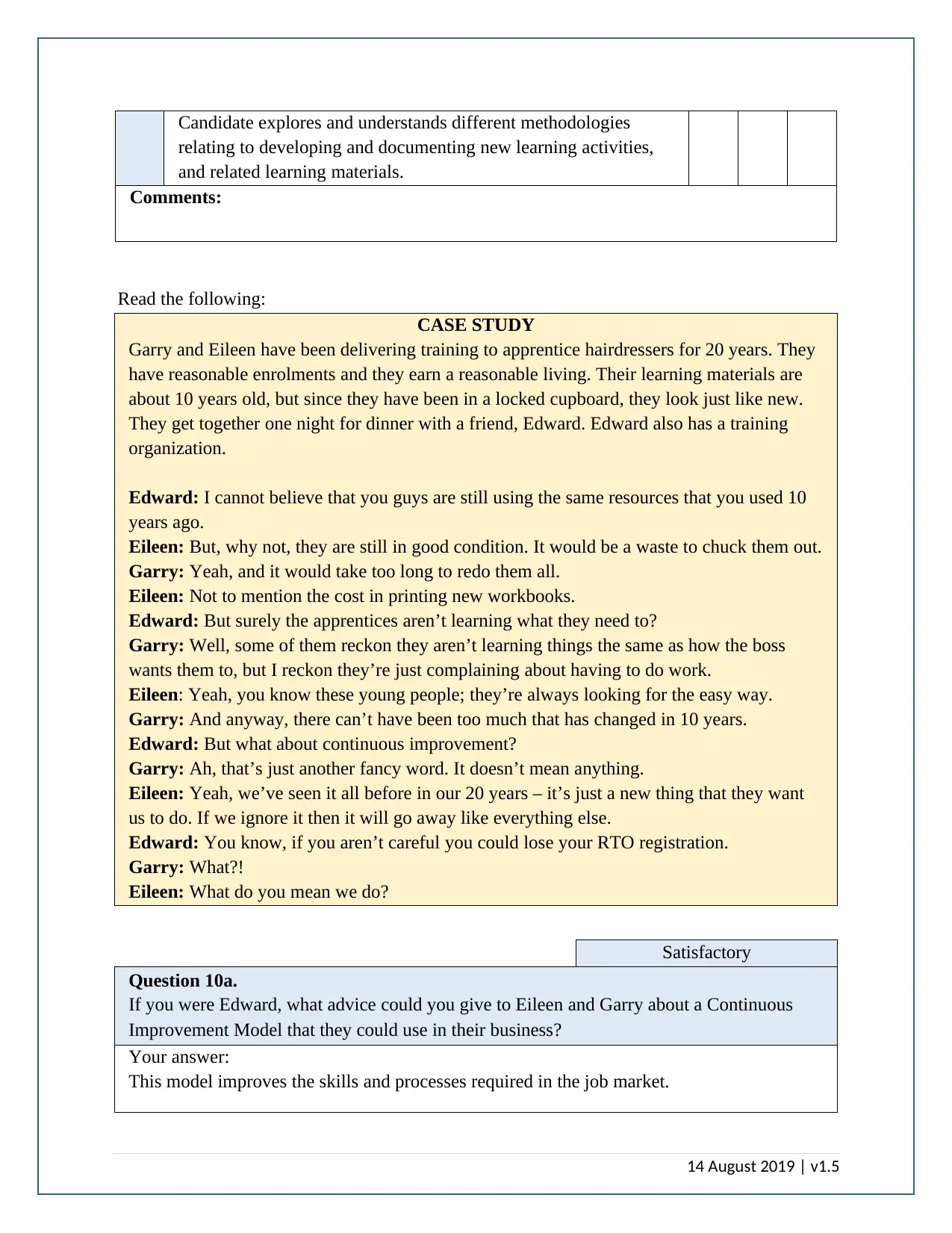
Candidate explores and understands different methodologies
relating to developing and documenting new learning activities,
and related learning materials.
Comments:
Read the following:
CASE STUDY
Garry and Eileen have been delivering training to apprentice hairdressers for 20 years. They
have reasonable enrolments and they earn a reasonable living. Their learning materials are
about 10 years old, but since they have been in a locked cupboard, they look just like new.
They get together one night for dinner with a friend, Edward. Edward also has a training
organization.
Edward: I cannot believe that you guys are still using the same resources that you used 10
years ago.
Eileen: But, why not, they are still in good condition. It would be a waste to chuck them out.
Garry: Yeah, and it would take too long to redo them all.
Eileen: Not to mention the cost in printing new workbooks.
Edward: But surely the apprentices aren’t learning what they need to?
Garry: Well, some of them reckon they aren’t learning things the same as how the boss
wants them to, but I reckon they’re just complaining about having to do work.
Eileen: Yeah, you know these young people; they’re always looking for the easy way.
Garry: And anyway, there can’t have been too much that has changed in 10 years.
Edward: But what about continuous improvement?
Garry: Ah, that’s just another fancy word. It doesn’t mean anything.
Eileen: Yeah, we’ve seen it all before in our 20 years – it’s just a new thing that they want
us to do. If we ignore it then it will go away like everything else.
Edward: You know, if you aren’t careful you could lose your RTO registration.
Garry: What?!
Eileen: What do you mean we do?
Satisfactory
Question 10a.
If you were Edward, what advice could you give to Eileen and Garry about a Continuous
Improvement Model that they could use in their business?
Your answer:
This model improves the skills and processes required in the job market.
14 August 2019 | v1.5
relating to developing and documenting new learning activities,
and related learning materials.
Comments:
Read the following:
CASE STUDY
Garry and Eileen have been delivering training to apprentice hairdressers for 20 years. They
have reasonable enrolments and they earn a reasonable living. Their learning materials are
about 10 years old, but since they have been in a locked cupboard, they look just like new.
They get together one night for dinner with a friend, Edward. Edward also has a training
organization.
Edward: I cannot believe that you guys are still using the same resources that you used 10
years ago.
Eileen: But, why not, they are still in good condition. It would be a waste to chuck them out.
Garry: Yeah, and it would take too long to redo them all.
Eileen: Not to mention the cost in printing new workbooks.
Edward: But surely the apprentices aren’t learning what they need to?
Garry: Well, some of them reckon they aren’t learning things the same as how the boss
wants them to, but I reckon they’re just complaining about having to do work.
Eileen: Yeah, you know these young people; they’re always looking for the easy way.
Garry: And anyway, there can’t have been too much that has changed in 10 years.
Edward: But what about continuous improvement?
Garry: Ah, that’s just another fancy word. It doesn’t mean anything.
Eileen: Yeah, we’ve seen it all before in our 20 years – it’s just a new thing that they want
us to do. If we ignore it then it will go away like everything else.
Edward: You know, if you aren’t careful you could lose your RTO registration.
Garry: What?!
Eileen: What do you mean we do?
Satisfactory
Question 10a.
If you were Edward, what advice could you give to Eileen and Garry about a Continuous
Improvement Model that they could use in their business?
Your answer:
This model improves the skills and processes required in the job market.
14 August 2019 | v1.5
Secure Best Marks with AI Grader
Need help grading? Try our AI Grader for instant feedback on your assignments.
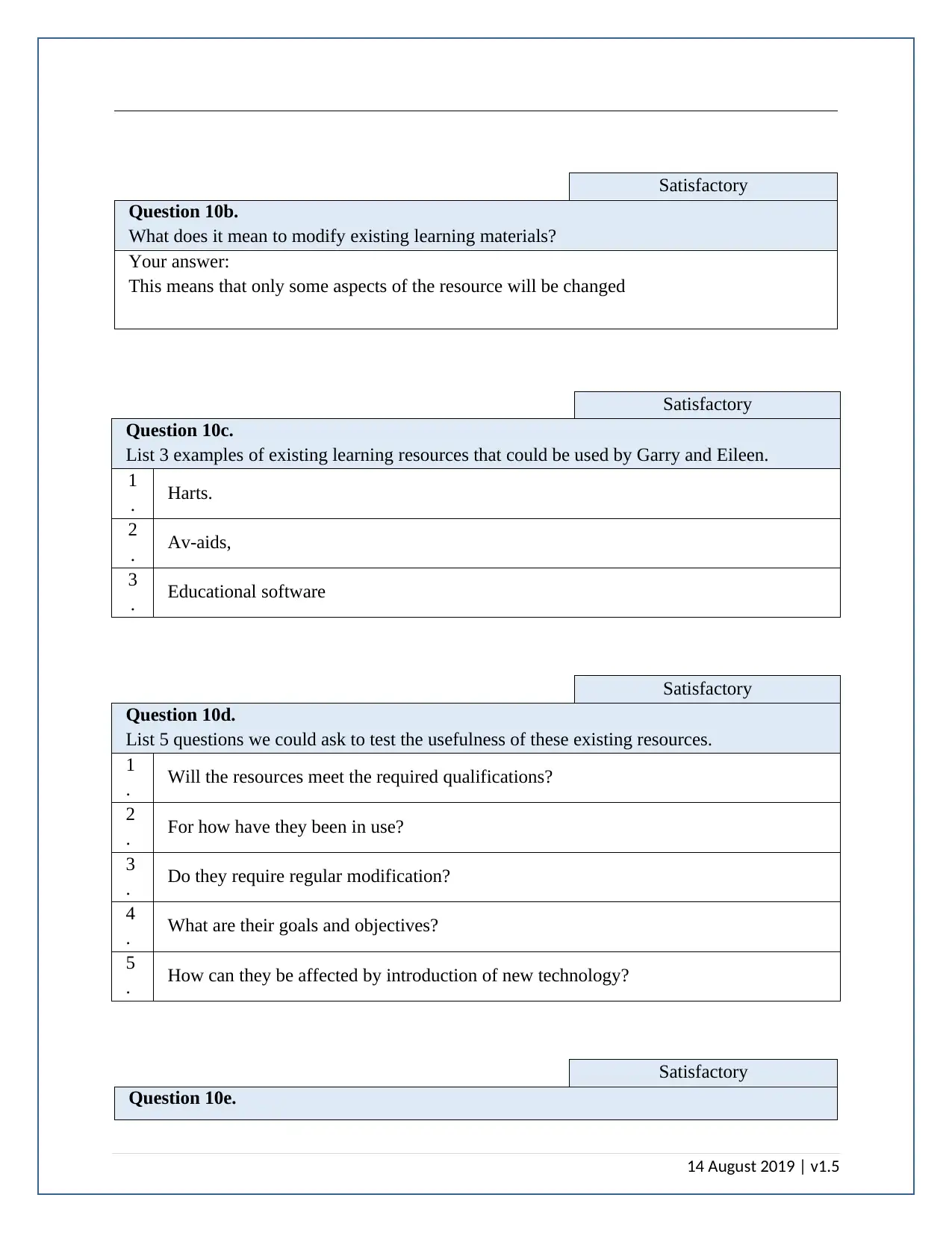
Satisfactory
Question 10b.
What does it mean to modify existing learning materials?
Your answer:
This means that only some aspects of the resource will be changed
Satisfactory
Question 10c.
List 3 examples of existing learning resources that could be used by Garry and Eileen.
1
. Harts.
2
. Av-aids,
3
. Educational software
Satisfactory
Question 10d.
List 5 questions we could ask to test the usefulness of these existing resources.
1
. Will the resources meet the required qualifications?
2
. For how have they been in use?
3
. Do they require regular modification?
4
. What are their goals and objectives?
5
. How can they be affected by introduction of new technology?
Satisfactory
Question 10e.
14 August 2019 | v1.5
Question 10b.
What does it mean to modify existing learning materials?
Your answer:
This means that only some aspects of the resource will be changed
Satisfactory
Question 10c.
List 3 examples of existing learning resources that could be used by Garry and Eileen.
1
. Harts.
2
. Av-aids,
3
. Educational software
Satisfactory
Question 10d.
List 5 questions we could ask to test the usefulness of these existing resources.
1
. Will the resources meet the required qualifications?
2
. For how have they been in use?
3
. Do they require regular modification?
4
. What are their goals and objectives?
5
. How can they be affected by introduction of new technology?
Satisfactory
Question 10e.
14 August 2019 | v1.5
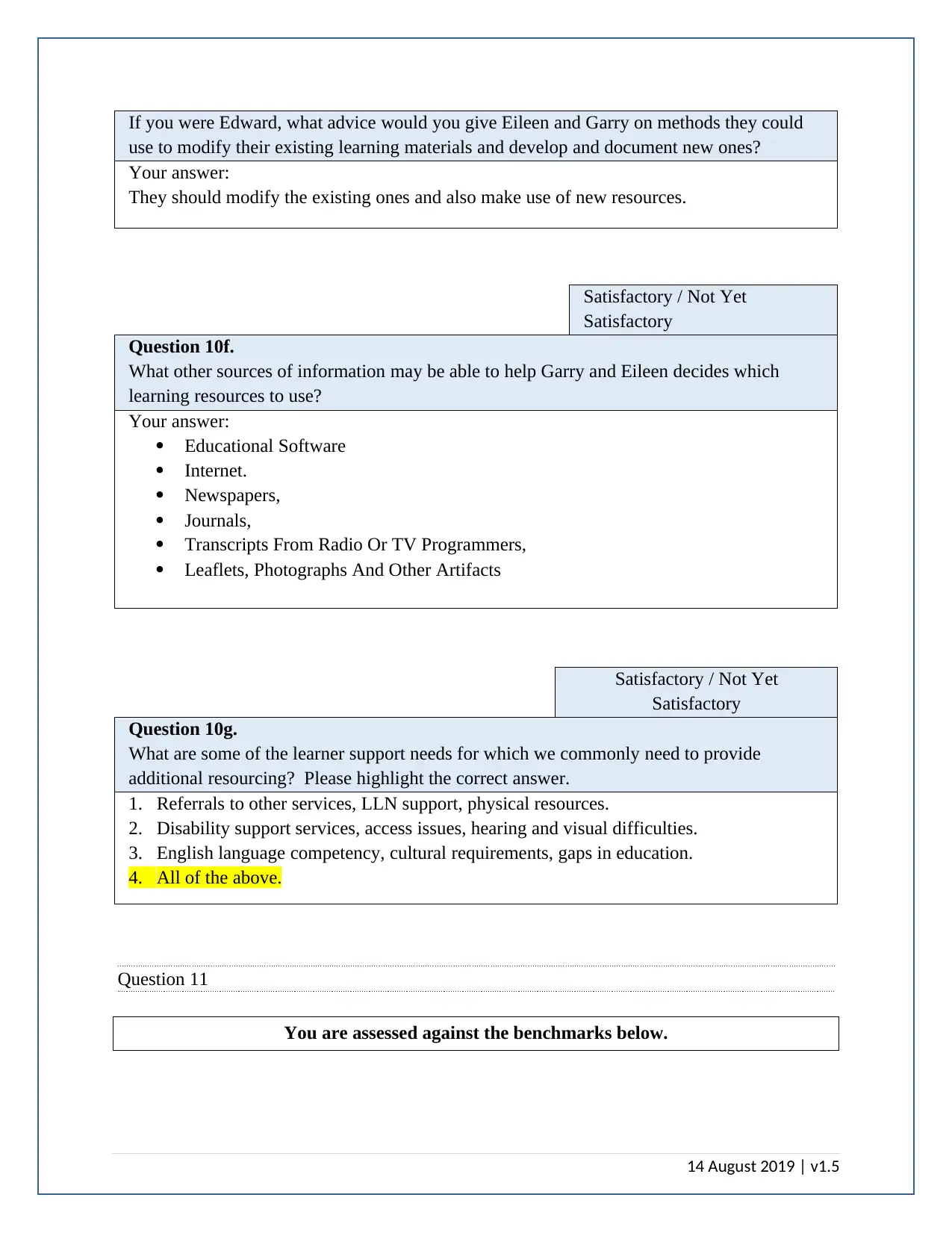
If you were Edward, what advice would you give Eileen and Garry on methods they could
use to modify their existing learning materials and develop and document new ones?
Your answer:
They should modify the existing ones and also make use of new resources.
Satisfactory / Not Yet
Satisfactory
Question 10f.
What other sources of information may be able to help Garry and Eileen decides which
learning resources to use?
Your answer:
Educational Software
Internet.
Newspapers,
Journals,
Transcripts From Radio Or TV Programmers,
Leaflets, Photographs And Other Artifacts
Satisfactory / Not Yet
Satisfactory
Question 10g.
What are some of the learner support needs for which we commonly need to provide
additional resourcing? Please highlight the correct answer.
1. Referrals to other services, LLN support, physical resources.
2. Disability support services, access issues, hearing and visual difficulties.
3. English language competency, cultural requirements, gaps in education.
4. All of the above.
Question 11
You are assessed against the benchmarks below.
14 August 2019 | v1.5
use to modify their existing learning materials and develop and document new ones?
Your answer:
They should modify the existing ones and also make use of new resources.
Satisfactory / Not Yet
Satisfactory
Question 10f.
What other sources of information may be able to help Garry and Eileen decides which
learning resources to use?
Your answer:
Educational Software
Internet.
Newspapers,
Journals,
Transcripts From Radio Or TV Programmers,
Leaflets, Photographs And Other Artifacts
Satisfactory / Not Yet
Satisfactory
Question 10g.
What are some of the learner support needs for which we commonly need to provide
additional resourcing? Please highlight the correct answer.
1. Referrals to other services, LLN support, physical resources.
2. Disability support services, access issues, hearing and visual difficulties.
3. English language competency, cultural requirements, gaps in education.
4. All of the above.
Question 11
You are assessed against the benchmarks below.
14 August 2019 | v1.5
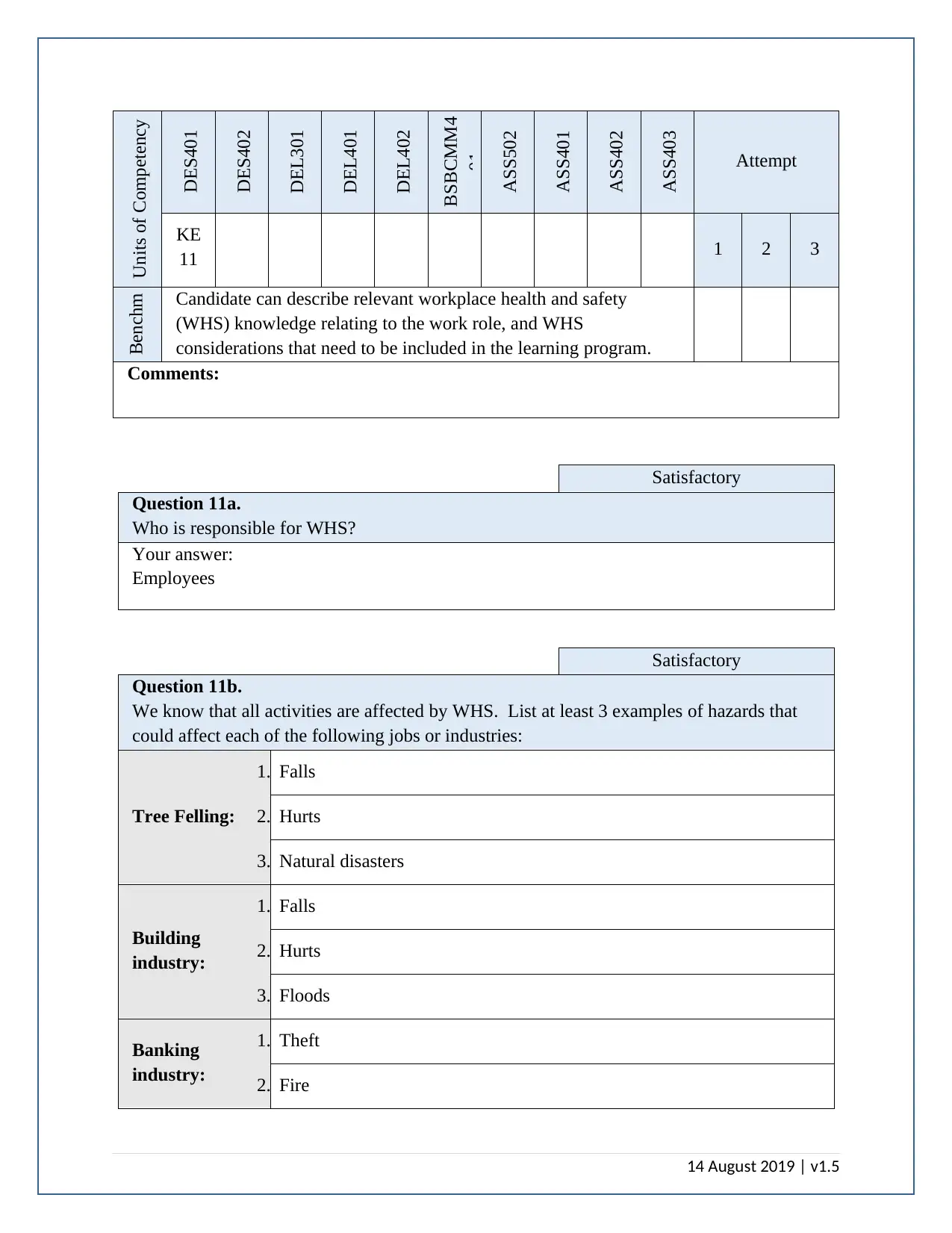
Units of Competency
DES401
DES402
DEL301
DEL401
DEL402
BSBCMM4
01
ASS502
ASS401
ASS402
ASS403
Attempt
KE
11 1 2 3
Benchm
arks Candidate can describe relevant workplace health and safety
(WHS) knowledge relating to the work role, and WHS
considerations that need to be included in the learning program.
Comments:
Satisfactory
Question 11a.
Who is responsible for WHS?
Your answer:
Employees
Satisfactory
Question 11b.
We know that all activities are affected by WHS. List at least 3 examples of hazards that
could affect each of the following jobs or industries:
Tree Felling:
1. Falls
2. Hurts
3. Natural disasters
Building
industry:
1. Falls
2. Hurts
3. Floods
Banking
industry:
1. Theft
2. Fire
14 August 2019 | v1.5
DES401
DES402
DEL301
DEL401
DEL402
BSBCMM4
01
ASS502
ASS401
ASS402
ASS403
Attempt
KE
11 1 2 3
Benchm
arks Candidate can describe relevant workplace health and safety
(WHS) knowledge relating to the work role, and WHS
considerations that need to be included in the learning program.
Comments:
Satisfactory
Question 11a.
Who is responsible for WHS?
Your answer:
Employees
Satisfactory
Question 11b.
We know that all activities are affected by WHS. List at least 3 examples of hazards that
could affect each of the following jobs or industries:
Tree Felling:
1. Falls
2. Hurts
3. Natural disasters
Building
industry:
1. Falls
2. Hurts
3. Floods
Banking
industry:
1. Theft
2. Fire
14 August 2019 | v1.5
Paraphrase This Document
Need a fresh take? Get an instant paraphrase of this document with our AI Paraphraser
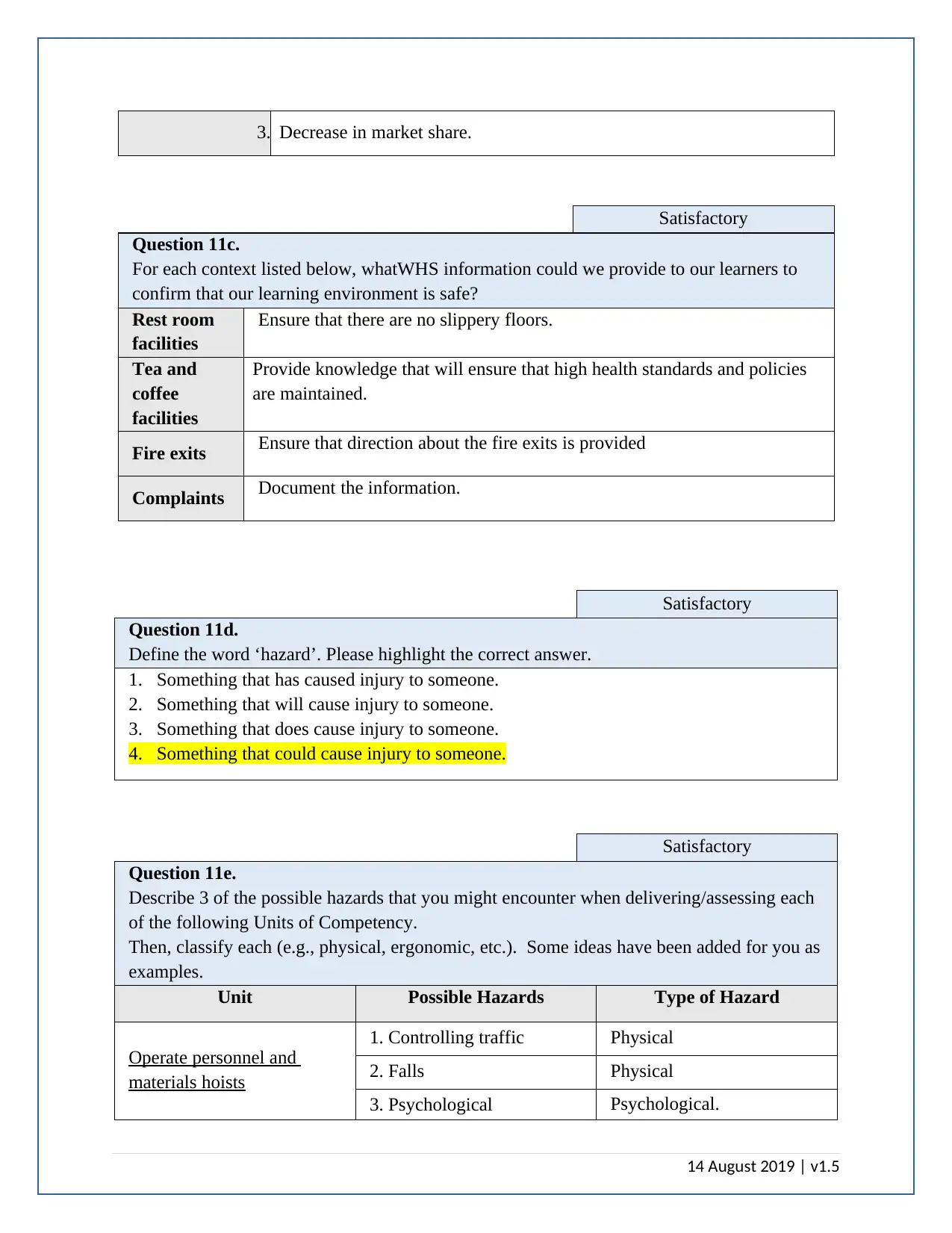
3. Decrease in market share.
Satisfactory
Question 11c.
For each context listed below, whatWHS information could we provide to our learners to
confirm that our learning environment is safe?
Rest room
facilities
Ensure that there are no slippery floors.
Tea and
coffee
facilities
Provide knowledge that will ensure that high health standards and policies
are maintained.
Fire exits Ensure that direction about the fire exits is provided
Complaints Document the information.
Satisfactory
Question 11d.
Define the word ‘hazard’. Please highlight the correct answer.
1. Something that has caused injury to someone.
2. Something that will cause injury to someone.
3. Something that does cause injury to someone.
4. Something that could cause injury to someone.
Satisfactory
Question 11e.
Describe 3 of the possible hazards that you might encounter when delivering/assessing each
of the following Units of Competency.
Then, classify each (e.g., physical, ergonomic, etc.). Some ideas have been added for you as
examples.
Unit Possible Hazards Type of Hazard
Operate personnel and
materials hoists
1. Controlling traffic Physical
2. Falls Physical
3. Psychological Psychological.
14 August 2019 | v1.5
Satisfactory
Question 11c.
For each context listed below, whatWHS information could we provide to our learners to
confirm that our learning environment is safe?
Rest room
facilities
Ensure that there are no slippery floors.
Tea and
coffee
facilities
Provide knowledge that will ensure that high health standards and policies
are maintained.
Fire exits Ensure that direction about the fire exits is provided
Complaints Document the information.
Satisfactory
Question 11d.
Define the word ‘hazard’. Please highlight the correct answer.
1. Something that has caused injury to someone.
2. Something that will cause injury to someone.
3. Something that does cause injury to someone.
4. Something that could cause injury to someone.
Satisfactory
Question 11e.
Describe 3 of the possible hazards that you might encounter when delivering/assessing each
of the following Units of Competency.
Then, classify each (e.g., physical, ergonomic, etc.). Some ideas have been added for you as
examples.
Unit Possible Hazards Type of Hazard
Operate personnel and
materials hoists
1. Controlling traffic Physical
2. Falls Physical
3. Psychological Psychological.
14 August 2019 | v1.5
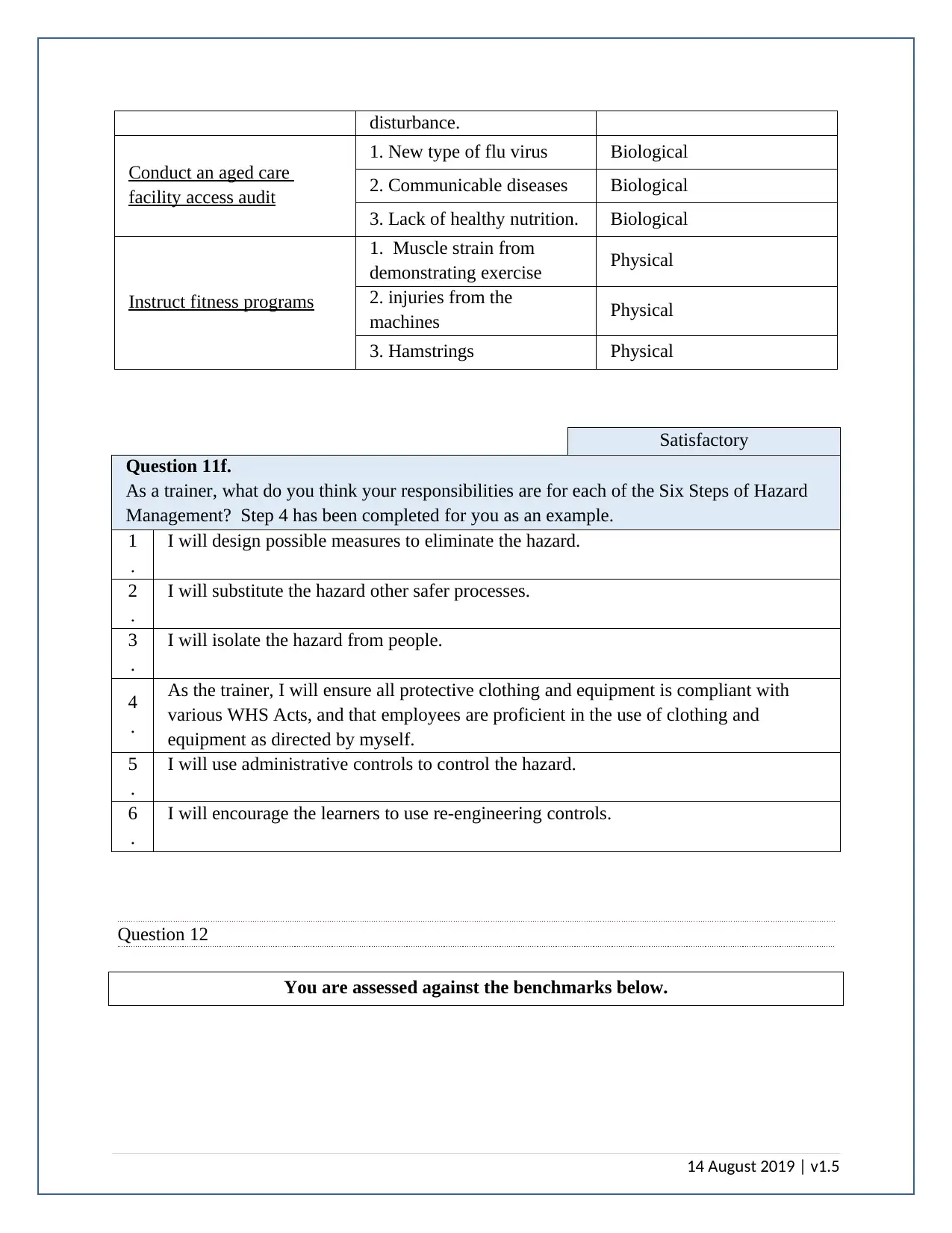
disturbance.
Conduct an aged care
facility access audit
1. New type of flu virus Biological
2. Communicable diseases Biological
3. Lack of healthy nutrition. Biological
Instruct fitness programs
1. Muscle strain from
demonstrating exercise Physical
2. injuries from the
machines Physical
3. Hamstrings Physical
Satisfactory
Question 11f.
As a trainer, what do you think your responsibilities are for each of the Six Steps of Hazard
Management? Step 4 has been completed for you as an example.
1
.
I will design possible measures to eliminate the hazard.
2
.
I will substitute the hazard other safer processes.
3
.
I will isolate the hazard from people.
4
.
As the trainer, I will ensure all protective clothing and equipment is compliant with
various WHS Acts, and that employees are proficient in the use of clothing and
equipment as directed by myself.
5
.
I will use administrative controls to control the hazard.
6
.
I will encourage the learners to use re-engineering controls.
Question 12
You are assessed against the benchmarks below.
14 August 2019 | v1.5
Conduct an aged care
facility access audit
1. New type of flu virus Biological
2. Communicable diseases Biological
3. Lack of healthy nutrition. Biological
Instruct fitness programs
1. Muscle strain from
demonstrating exercise Physical
2. injuries from the
machines Physical
3. Hamstrings Physical
Satisfactory
Question 11f.
As a trainer, what do you think your responsibilities are for each of the Six Steps of Hazard
Management? Step 4 has been completed for you as an example.
1
.
I will design possible measures to eliminate the hazard.
2
.
I will substitute the hazard other safer processes.
3
.
I will isolate the hazard from people.
4
.
As the trainer, I will ensure all protective clothing and equipment is compliant with
various WHS Acts, and that employees are proficient in the use of clothing and
equipment as directed by myself.
5
.
I will use administrative controls to control the hazard.
6
.
I will encourage the learners to use re-engineering controls.
Question 12
You are assessed against the benchmarks below.
14 August 2019 | v1.5
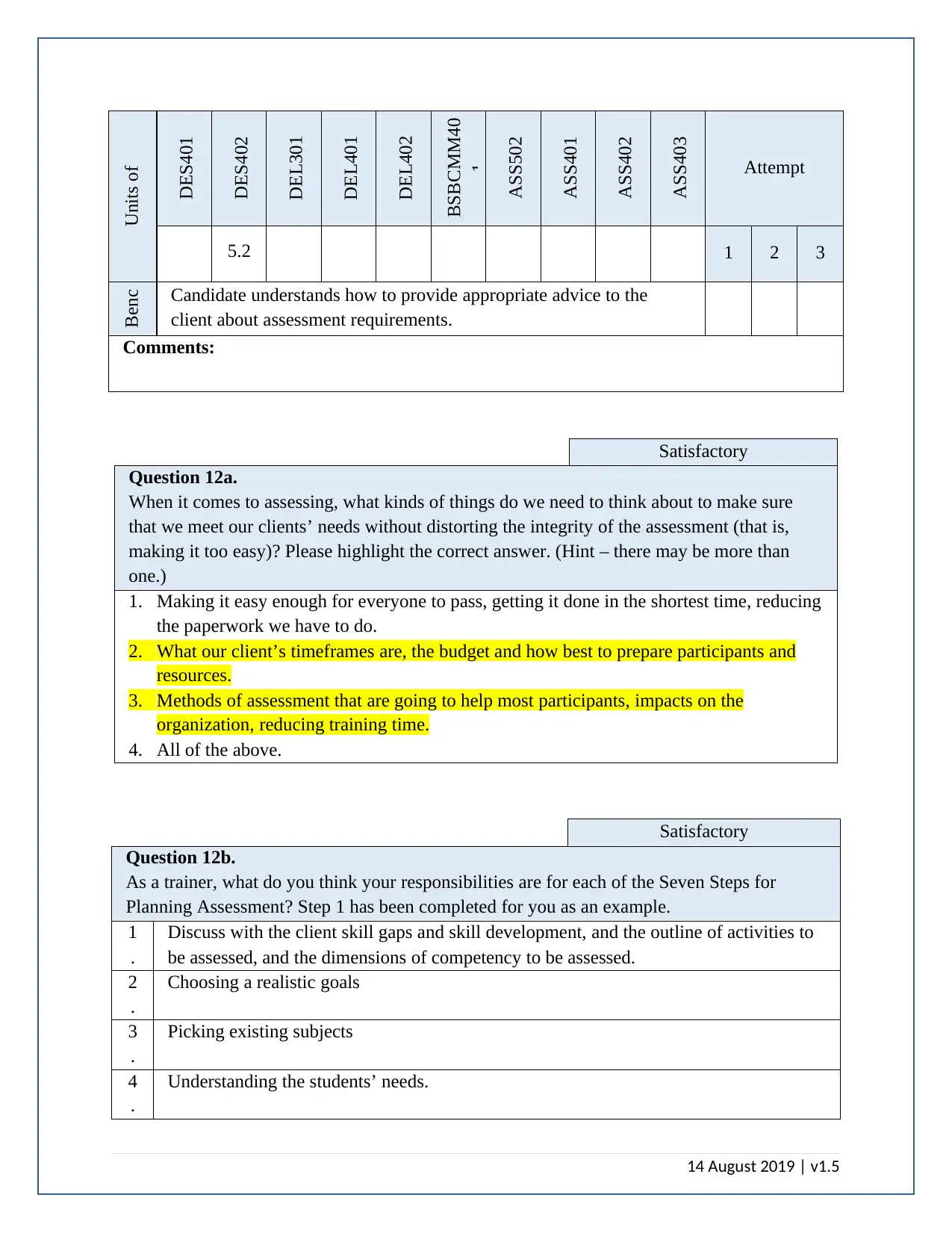
Units of
Competency
DES401
DES402
DEL301
DEL401
DEL402
BSBCMM40
1
ASS502
ASS401
ASS402
ASS403
Attempt
5.2 1 2 3
Benc
hmar Candidate understands how to provide appropriate advice to the
client about assessment requirements.
Comments:
Satisfactory
Question 12a.
When it comes to assessing, what kinds of things do we need to think about to make sure
that we meet our clients’ needs without distorting the integrity of the assessment (that is,
making it too easy)? Please highlight the correct answer. (Hint – there may be more than
one.)
1. Making it easy enough for everyone to pass, getting it done in the shortest time, reducing
the paperwork we have to do.
2. What our client’s timeframes are, the budget and how best to prepare participants and
resources.
3. Methods of assessment that are going to help most participants, impacts on the
organization, reducing training time.
4. All of the above.
Satisfactory
Question 12b.
As a trainer, what do you think your responsibilities are for each of the Seven Steps for
Planning Assessment? Step 1 has been completed for you as an example.
1
.
Discuss with the client skill gaps and skill development, and the outline of activities to
be assessed, and the dimensions of competency to be assessed.
2
.
Choosing a realistic goals
3
.
Picking existing subjects
4
.
Understanding the students’ needs.
14 August 2019 | v1.5
Competency
DES401
DES402
DEL301
DEL401
DEL402
BSBCMM40
1
ASS502
ASS401
ASS402
ASS403
Attempt
5.2 1 2 3
Benc
hmar Candidate understands how to provide appropriate advice to the
client about assessment requirements.
Comments:
Satisfactory
Question 12a.
When it comes to assessing, what kinds of things do we need to think about to make sure
that we meet our clients’ needs without distorting the integrity of the assessment (that is,
making it too easy)? Please highlight the correct answer. (Hint – there may be more than
one.)
1. Making it easy enough for everyone to pass, getting it done in the shortest time, reducing
the paperwork we have to do.
2. What our client’s timeframes are, the budget and how best to prepare participants and
resources.
3. Methods of assessment that are going to help most participants, impacts on the
organization, reducing training time.
4. All of the above.
Satisfactory
Question 12b.
As a trainer, what do you think your responsibilities are for each of the Seven Steps for
Planning Assessment? Step 1 has been completed for you as an example.
1
.
Discuss with the client skill gaps and skill development, and the outline of activities to
be assessed, and the dimensions of competency to be assessed.
2
.
Choosing a realistic goals
3
.
Picking existing subjects
4
.
Understanding the students’ needs.
14 August 2019 | v1.5
Secure Best Marks with AI Grader
Need help grading? Try our AI Grader for instant feedback on your assignments.
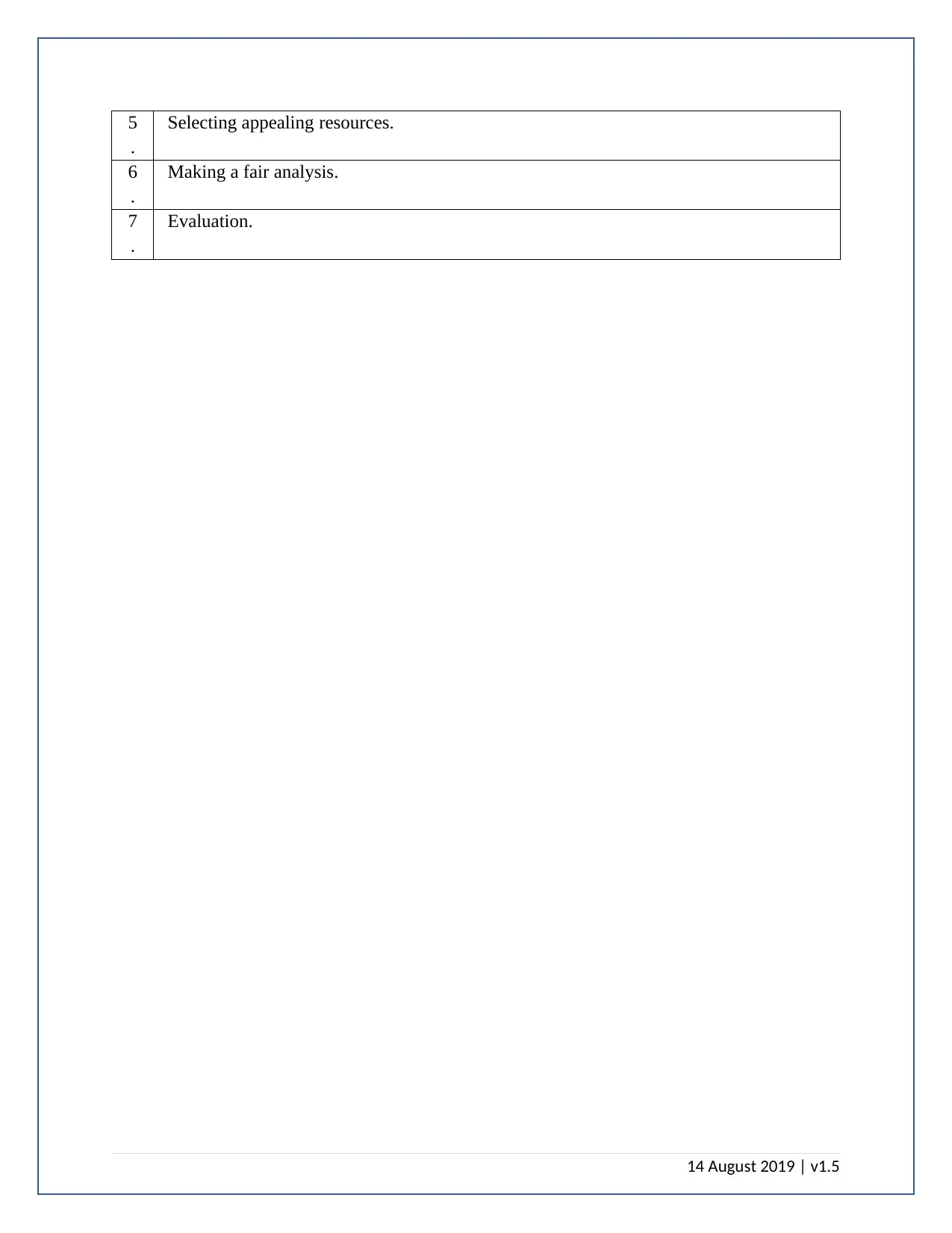
5
.
Selecting appealing resources.
6
.
Making a fair analysis.
7
.
Evaluation.
14 August 2019 | v1.5
.
Selecting appealing resources.
6
.
Making a fair analysis.
7
.
Evaluation.
14 August 2019 | v1.5
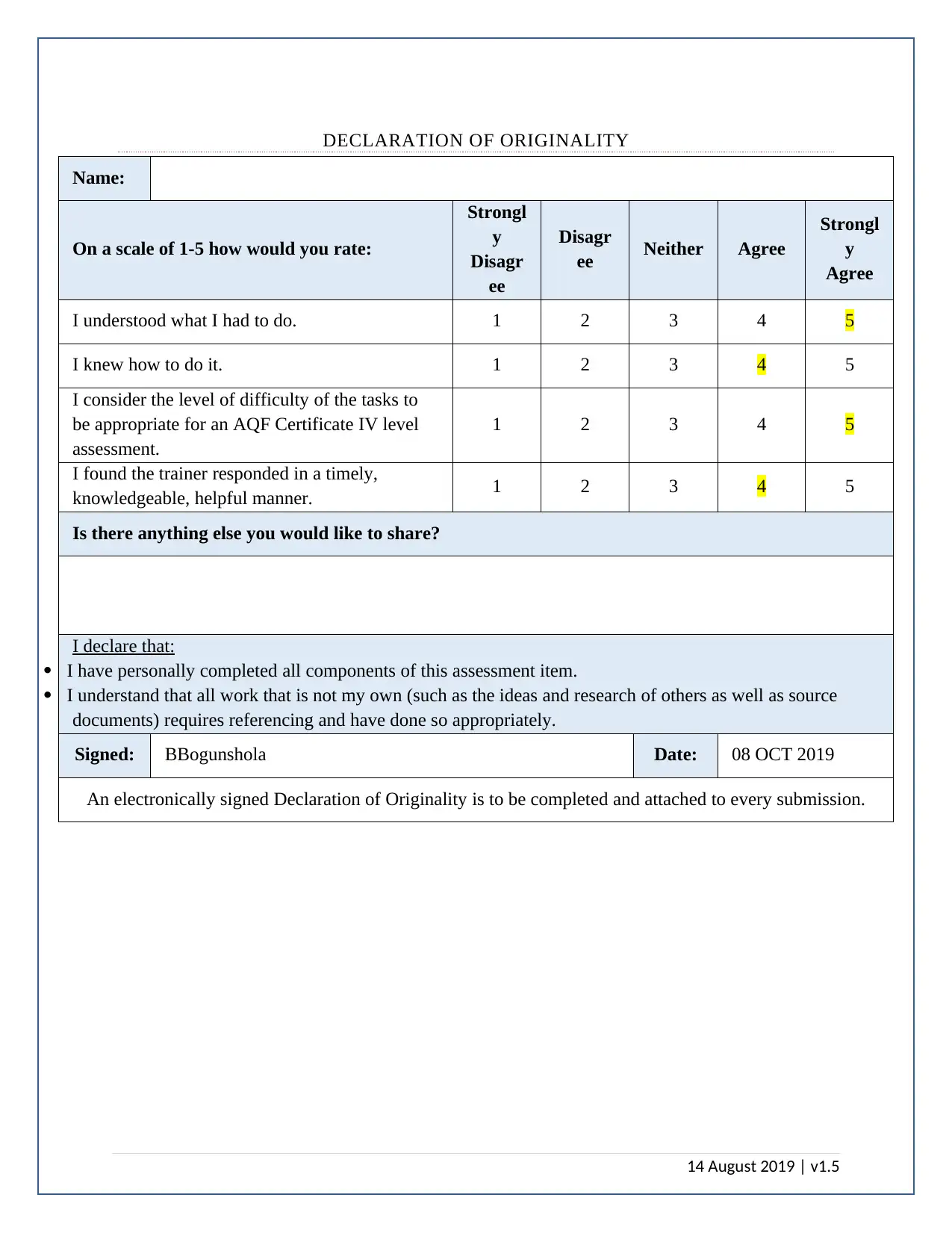
DECLARATION OF ORIGINALITY
Name:
On a scale of 1-5 how would you rate:
Strongl
y
Disagr
ee
Disagr
ee Neither Agree
Strongl
y
Agree
I understood what I had to do. 1 2 3 4 5
I knew how to do it. 1 2 3 4 5
I consider the level of difficulty of the tasks to
be appropriate for an AQF Certificate IV level
assessment.
1 2 3 4 5
I found the trainer responded in a timely,
knowledgeable, helpful manner. 1 2 3 4 5
Is there anything else you would like to share?
I declare that:
I have personally completed all components of this assessment item.
I understand that all work that is not my own (such as the ideas and research of others as well as source
documents) requires referencing and have done so appropriately.
Signed: BBogunshola Date: 08 OCT 2019
An electronically signed Declaration of Originality is to be completed and attached to every submission.
14 August 2019 | v1.5
Name:
On a scale of 1-5 how would you rate:
Strongl
y
Disagr
ee
Disagr
ee Neither Agree
Strongl
y
Agree
I understood what I had to do. 1 2 3 4 5
I knew how to do it. 1 2 3 4 5
I consider the level of difficulty of the tasks to
be appropriate for an AQF Certificate IV level
assessment.
1 2 3 4 5
I found the trainer responded in a timely,
knowledgeable, helpful manner. 1 2 3 4 5
Is there anything else you would like to share?
I declare that:
I have personally completed all components of this assessment item.
I understand that all work that is not my own (such as the ideas and research of others as well as source
documents) requires referencing and have done so appropriately.
Signed: BBogunshola Date: 08 OCT 2019
An electronically signed Declaration of Originality is to be completed and attached to every submission.
14 August 2019 | v1.5
1 out of 54
Related Documents
Your All-in-One AI-Powered Toolkit for Academic Success.
+13062052269
info@desklib.com
Available 24*7 on WhatsApp / Email
![[object Object]](/_next/static/media/star-bottom.7253800d.svg)
Unlock your academic potential
© 2024 | Zucol Services PVT LTD | All rights reserved.





